LUCID
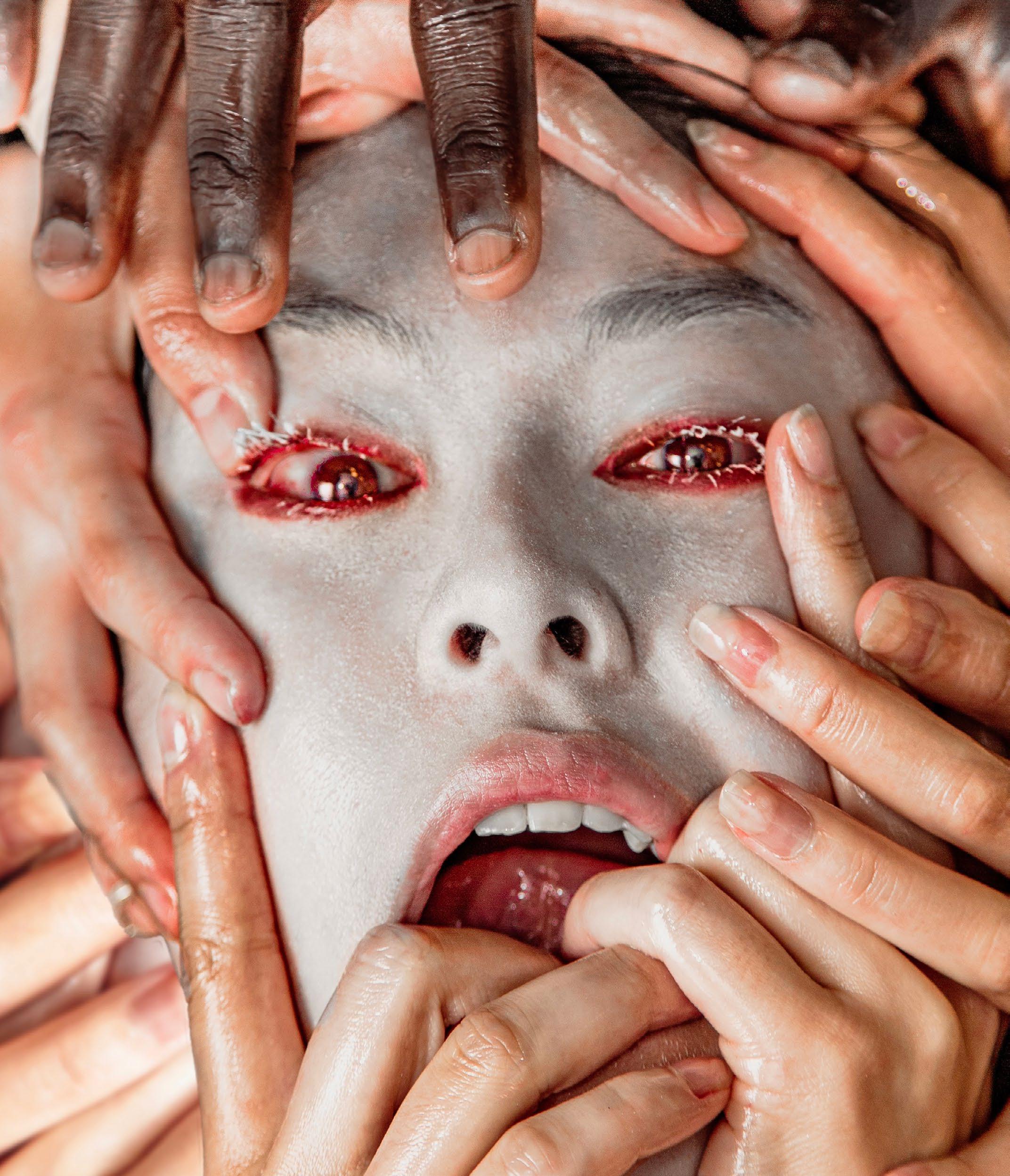
fever
mundane
utopia



02
Abby Falzone
ART DIRECTOR
Renee Pearce
EDITORS IN CHIEF
Jessica Brite
Lily Elwood
Husein Esufally
Farrah Haytham
FASHION EDITOR Hill Mak
BEAUTY EDITOR Antonia Sousa
LIFESTYLE EDITOR Elena Plumb
WRITERS
Alex Trotto, Soomin Yang, Meghna Iyer, Sophia Naumovski, Lily Elwood, Lauren Violette, Nyree Christianian, Wraven Wantanabe, Rachel Erwin, Valeria Martinez, Sarah Gordon,
MODELS
Sasha Lewis, Anthony Peters, Ax Balione, Tanya Verma, Sam Levis, Samantha Diaz, Rachel Solomon, Yue Chen, Miles Stevenson, Bhavana Sinha, Annika Geiben Lynn, Jason Harris, Kat Tse, Elana Lane, Bita Adel-Zadeh, Lazaria Harris, Marisa Munoz, Andrew Barnett, Lina Petronino, Wraven Watanabe, Halima Duarte, Andrea Gertrudis, Ty Orlando, Lazaria Harris, Ronnie Efremov, Jacyn Daniels, Harrison Freiman, Yene Usua, Srishti Gummaraju, Luna Bruss, Amelia Ball, Aidan Sevier, Hannah Hartsough, Sasha Shrestha, Chloe Cowan, Schekinath Biaou, Jennifer Uyanga, jack deutsch, Chris Parker, Lynne Khouri, Ken Yin,Cassie Stanely, Cassidy Chamillard, Hill Mak
STYLISTS
Gigi Gillen, Adriana Alvarez, Solomon Canada, Woody Lindor
MAKEUP ARTISTS
Clarisa Zalles, Sofia Urrutia, Celine Plaisir
CREATIVE DIRECTOR
MANAGING EDITORS
PROJECTS EDITOR David Donoian ASSOCIATE CREATIVE DIRECTOR Sasha Lewis ASSOCIATE ART DIRECTOR
Jacyn Daniels PHOTO DIRECTORS
Angelina Chau Lynne Khouri ASSOCIATE PHOTO DIRECTOR Mia Rapella VIDEO DIRECTOR Sara Akhtar VIDEOGRAPHER Cali Cardenas VIDEO EDITORS Emanuele Dokyi Katie Ma
Gray Timberlake, Isabella Bernstein, Ebube Onwusika, Logan Roberts, Kat Tse, Adriana Alvarez
Azra Schorr, Peyton Pollard, Kathleen Ma, Shirley Wang, Izzy Bernstein, Serena Buscarello, Sydney Singh, Jenna Ory, Lauren Violette, Mukki Gill, Olivia Leon, Emma Lawson, Amanda Kerr, Cali Cardenas, Alex Chang, Kira Briggs, Isabella Pozzi DESIGNERS Daisy Tuller, Sydney Singh, Vanessa Peng, Sharon Chen, Emlyn Griffiths, Sophie Fiks DESIGN DIRECTOR Claire Higgins ASSOCIATE DESIGN DIRECTOR Rachel Osborne DIGITAL DESIGN DIRECTOR Tanya Kler HEAD STYLIST Yeani Kwon MAKEUP DIRECTOR Melanie Barest UX/UI DESIGNERS Jason Harris Titamah Simpson Jade Khatib SOCIAL MEDIA DESIGN Elana Lane WEB DEVELOPER Ania Misiorek COMMUNICATIONS DIRECTOR Azra Schorr COMMUNICATIONS ASSOCIATE Elana Keller OUTREACH COORDINATOR Rachel Mann PRODUCTION ASSISTANT Hannah Shapiro PRESIDENT Isabelle Roberts VICE PRESIDENT Tommy Bell TREASURER Paige Keeler SECRETARY Phoebe Kahn
PHOTOGRAPHERS

04
AN EXPLORATION OF HOW OUR FANTASIES JUXTAPOSE REALITY TO CREATE A CLEARER LENS THROUGH WHICH WE VIEW THE WORLD.
LUCID:

LETTER FROM
THE EDITORS
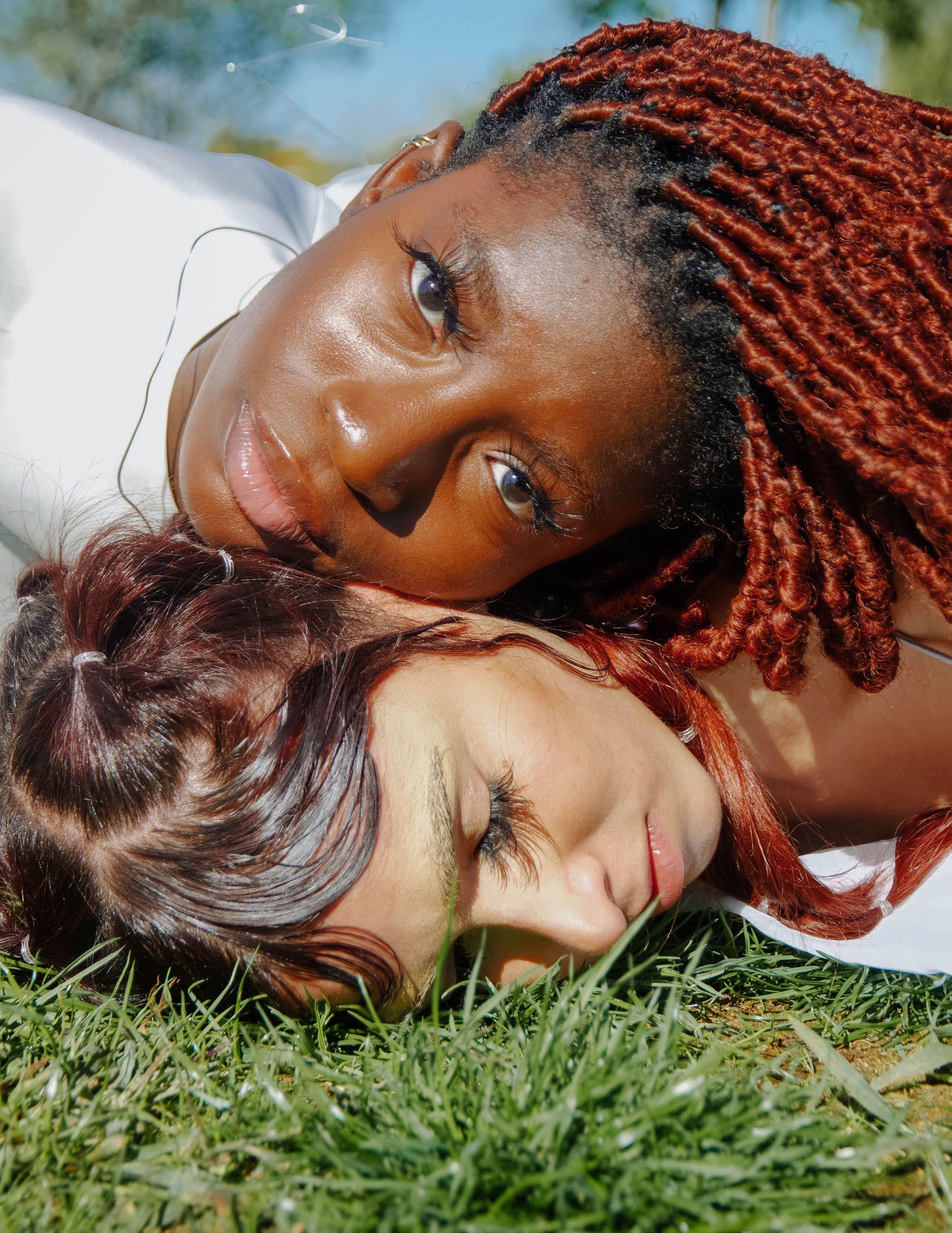
06
This semester we entered a new era of The Avenue, with a brand new leadership team, ushering in quite a bit of nerves with the fear that we didn’t know what we were doing. To be honest, most of the time it very much felt like we were making it up as we went — who knew we would spend hours on Zoom with the Creative and Art Directors just to plan out a calendar. Nevertheless, here we are, and we couldn’t be prouder to present this issue. Both of us have been with the magazine since our first year at Northeastern as writers, columnists, and section editors, so taking on the EIC position has been an incredible and humbling experience.
This issue, we really wanted to keep the writers in mind for our magazine theme. Something that spoke to them, that evoked creativity — and we arrived at a theme that would allow our writers to explore aspects of fantasy-based storytelling in media and dive deeper into how our culture is shaped. LUCID is exactly that. It perfectly encapsulates the line between reality and fantasy; how we as people interact with the world through different lenses of thinking; how media interacts with fantastical elements to create something tangible for our consumption. It is both sanity and insanity, the concept of control over yourself and your environment, it is theatricality, it is over-thetopness. Lucidity is about hyper-awareness, understanding that you are a product of your environment, at its mercy, while simultaneously knowing that change is possible.
The articles that came out of our brainstorming process are both outrageous and muted, both fantastical and realistic, both light and dark. The comparison of opposite aesthetics became a staple for us as we sent our writers to begin their processes. Keeping in mind a light or dark theme allowed them to go full throttle in their specific direction and has given this issue an air of juxtaposition that The Avenue has not had in the past.


With this issue, the editorial team worked on overdrive for weeks concepting and perfecting this semester’s slew of articles. We were able to connect with the creative process as well, striving to make the magazine cohesive across the board, all in the hopes of giving our readers the best immersive experience.
LUCID is the product of hours and hours of hard, collaborative work between the creative and editorial teams. It is so inspiring to work with like-minded, talented, creative individuals who deeply care about the finished product. There truly is nothing like being a part of something every step of the way from its inception to its final form. Overseeing the process has ultimately been such a joy for the both of us and it absolutely represents everything we believe The Avenue to be — innovative, beautiful, and of course, extremely fashionable. Thank you so much for taking the time to read LUCID; we hope you enjoy it.
JESSICA BRITE AND LILY ELWOOD EDITORS IN CHIEF
LETTER FROM THE CREATIVE DIRECTOR

08
THE FANTASTICAL, THE PERFECT, THE TERRIFYING
LUCID has pushed the boundaries of what The Avenue is, what we can produce, and how far we can experiment as a collective before we get lost in it all. With all of the new talent added to our team this semester, our creative collaboration has never hit a high this amazing and I can’t help but believe that this is a turning point for The Avenue as a whole. Always pushing each other to question if we’re “doing too much,” I am extremely proud and grateful for everyone involved in making this issue what it is.
One of our biggest goals as we moved into this semester was connecting to our audience, showing our readers that this is not just an exclusive, high-fashion magazine. We aimed to connect and evoke emotion and excitement out of everyone who lays eyes on our spreads and articles. LUCID represents the fantastical, the perfect, the terrifying, the real in our everyday lives and society. We hope that we’ve created a world in this issue that you can not only see, but touch, feel, and get lost in.
This being my first issue as creative director, I hope to have started a new chapter and push what it means to be a part of The Avenue and its production. From styling to design to photo to direction and everything in between, I am so, so proud of this issue and how far we’ve come since we sat down in May and started building our creative team. With all of the (literal) blood, sweat, and tears we have spent on making LUCID what it is, I can whole-heartedly say that it was worth it.
I hope you can feel the passion we’ve put into making this issue what it is, and that The Avenue continues to push what is possible as a publication at Northeastern, Boston, in the industry, and in our lives. Thank you to everyone who was a part of this beautiful creation process, enjoy.
ABBY FALZONE CREATIVE DIRECTOR



10


UTOPIA 60s Fashion: A Conduit for Social Change Iris Van Herpen: Fashion in Flux Romanticizing Your Life The Sweet Escape Psychedelics: In Pursuit of Change Young and Beautiful Healing through Mindfulness All That Glitters Finding Answers in the Stars 012 024 030 036 042 046 050 056 060 066 072 084 090 094 098 102 108 112 116 122 MUNDANE I Am Not a Sin Fashioning the Mad Hatter Dissecting the 90s 'Heroin Chic' Look Not So Clean After All Victoria's Dark Secret The Nihilist Generation Dreams: Fantasy
Reality? Couture
the Dark FEVER TABLE OF CONTENTS
or
from


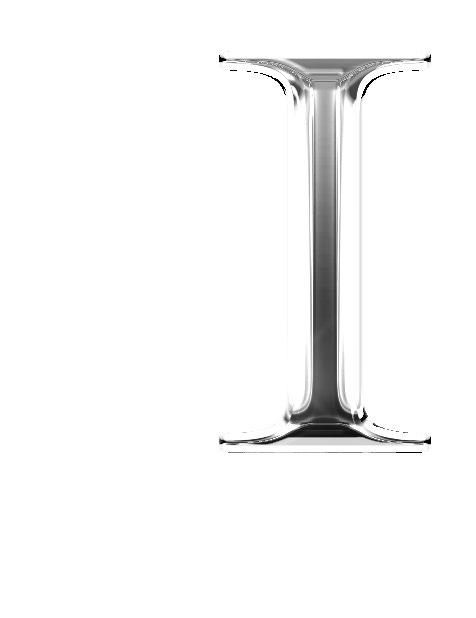

12
 creativedirection ABBY FALZONE artdirection RENEE PEARCE photography MIA RAPELLA design CLAIRE HIGGINS contributingartdirection JACYN DANIELS modeling SCHEKINATH (KIKI) BIAOU & CHLOE COWAN styling YEANI KWON & GIGI GILLEN & ADRIANA ALVAREZ makeup&hair MELANIE BAREST & GIGI GILLEN & JACYN DANIELS & ELANA LANE
creativedirection ABBY FALZONE artdirection RENEE PEARCE photography MIA RAPELLA design CLAIRE HIGGINS contributingartdirection JACYN DANIELS modeling SCHEKINATH (KIKI) BIAOU & CHLOE COWAN styling YEANI KWON & GIGI GILLEN & ADRIANA ALVAREZ makeup&hair MELANIE BAREST & GIGI GILLEN & JACYN DANIELS & ELANA LANE


14




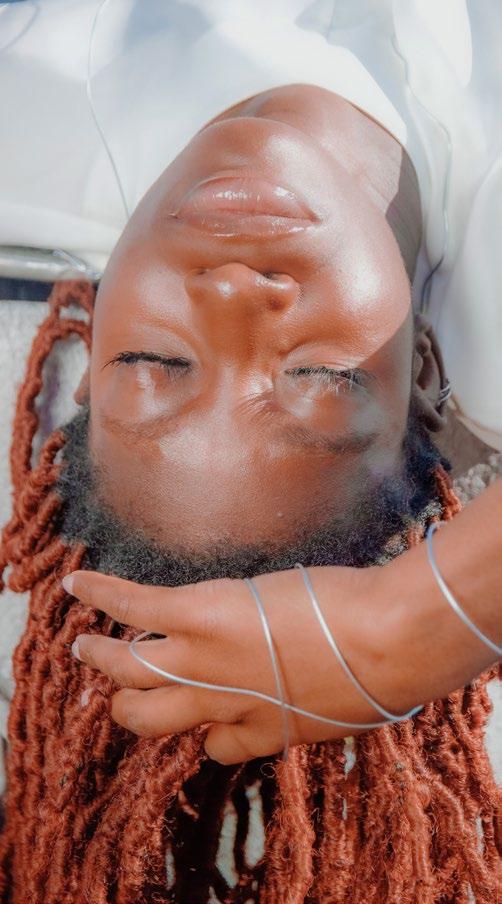
16
an imagined world
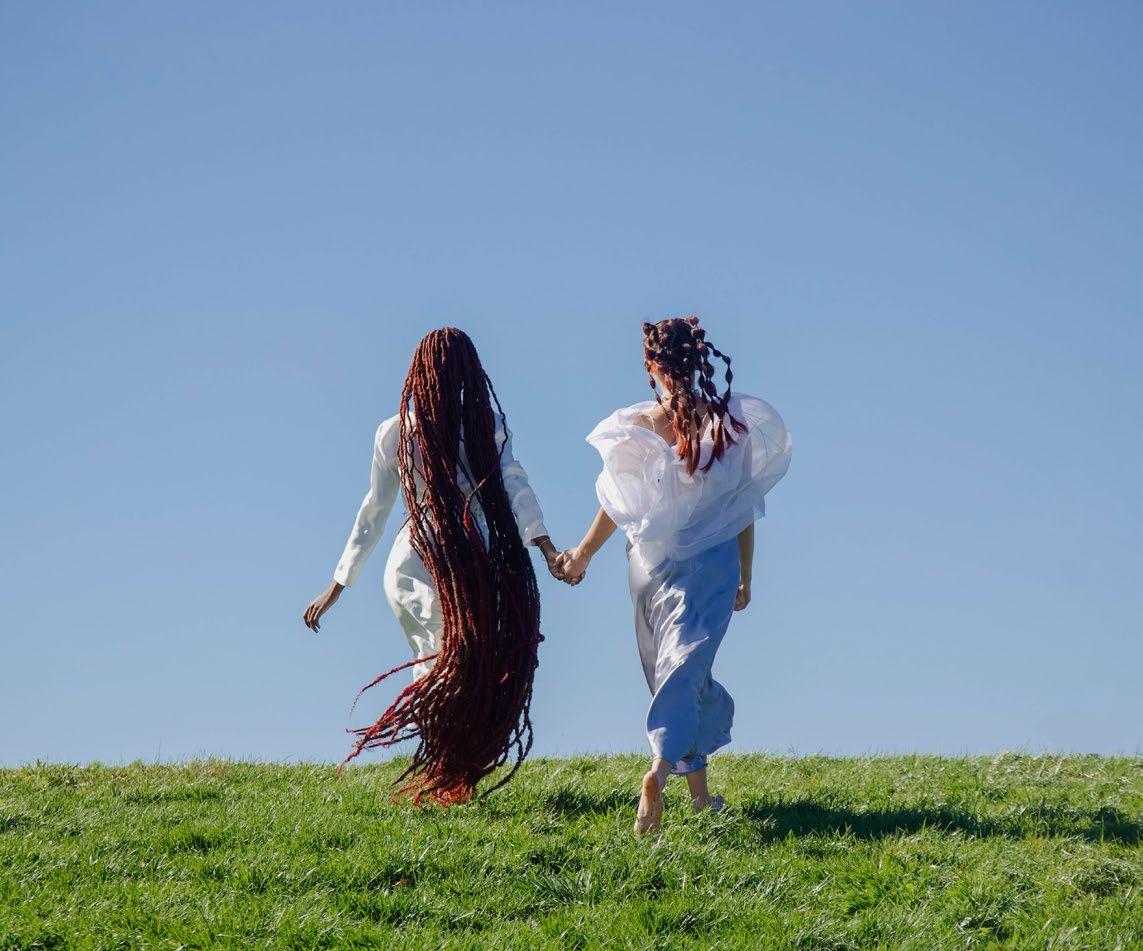



18


pearls modular necklace by foreign resource
u p dress ri g h t d i r ce t i o n u p right direct i o n pu
u p ihw t e
right d i re c t i o n pu thgir noitceid
noitcerid
up
dress by right d i r e c t noi pu
white dress b y thgir noitcerid
ta i lored 20
tailored dress yb rengised thgir
white

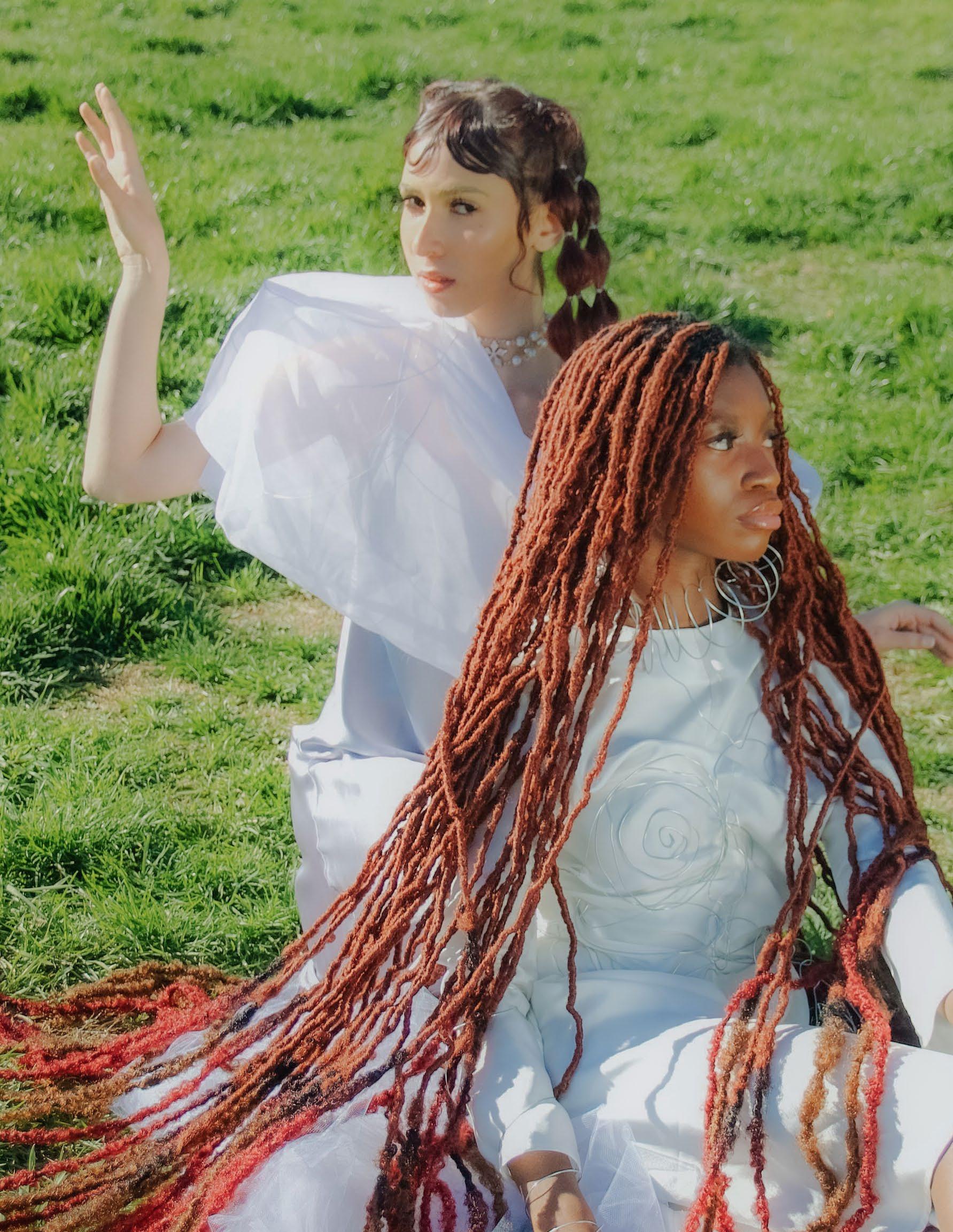
22



24
60S 60S 60S
60S FASHION: a conduit for social change
In times of struggle, people often turn to fashion to express their emotions. They look to it to spark the cultural changes they crave but aren’t ready to speak aloud. As such, fashion becomes the conduit for social change and the beginnings of a revolution.
We do this on a small scale every day as individuals. However, when a community of people join together in the movement, it can push the boundaries of shared cultural values. This cultural phenomenon was exemplified during the war-filled 1960s. As the Vietnam War and the Cold War unfolded, people felt a range of emotions — from fear, to rage, to a desire to escape from the chaotic world around them. Women stepped up to fill nontraditional roles, and style trends evolved to suit their changing needs. As people attempted to find direction in the midst of social turmoil, fashion and style became dictated by each individual. In this era, fashion ceased to begin in the hands of designers, but instead grew from people and the way they chose to live.
In the midst of war, optimism is a necessity. There was a common wish to escape and a sought-after remedy at the time was psychedelics. They grew to be popular because they provided a means of freedom from reality, and through this escapism, people were able to access a semblance of hope. This social movement found its way into the patterns and colors of clothing. The bright designs evoke a sense of confusion, resisting reason or order. Men’s clothing in particular drew influence from psychedelics and music. The novel prints found in their clothes grew to be known as “A Peacock Revolution for Men.” The bright prints were used most prominently by musicians like the Beatles and the Rolling Stones, whose lyrics frequently explored the use of psychedelics.
writing MEGHNA IYER modeling RONNIE EFREMOV & JACYN DANIELS & HARRISON FREIMAN photography MUKKI GILL design DAISY TULLER styling ADRIANA ALVAREZ makeup CELINE PLAISIR
CREATION AND ROLE DISRUPTION


26
Similarly, music has the power to subdue and transport an individual to another world — one that, at times, is easier to live in than the real world. When a person wears the chaos and immerses themselves in it, they let go of the pressure to process the chaos around them, which opens the door toward acceptance of one’s circumstances. This mindset helped people to cope with the effects of war and made room to hope that better days were ahead. Men’s clothing had never been colorful or bold before, but these new trends enabled them
to explore their feelings regarding the traditional features of masculinity in greater depth and ultimately confront them.

For women, the ‘60s was a time of creation and role disruption. With the threat of death and violence looming in the background, many young women used their time to live life to the fullest and without regrets, which included embodying non-traditional roles for the first time. From that youthful, rebellious spirit came the miniskirt. After seeing how women

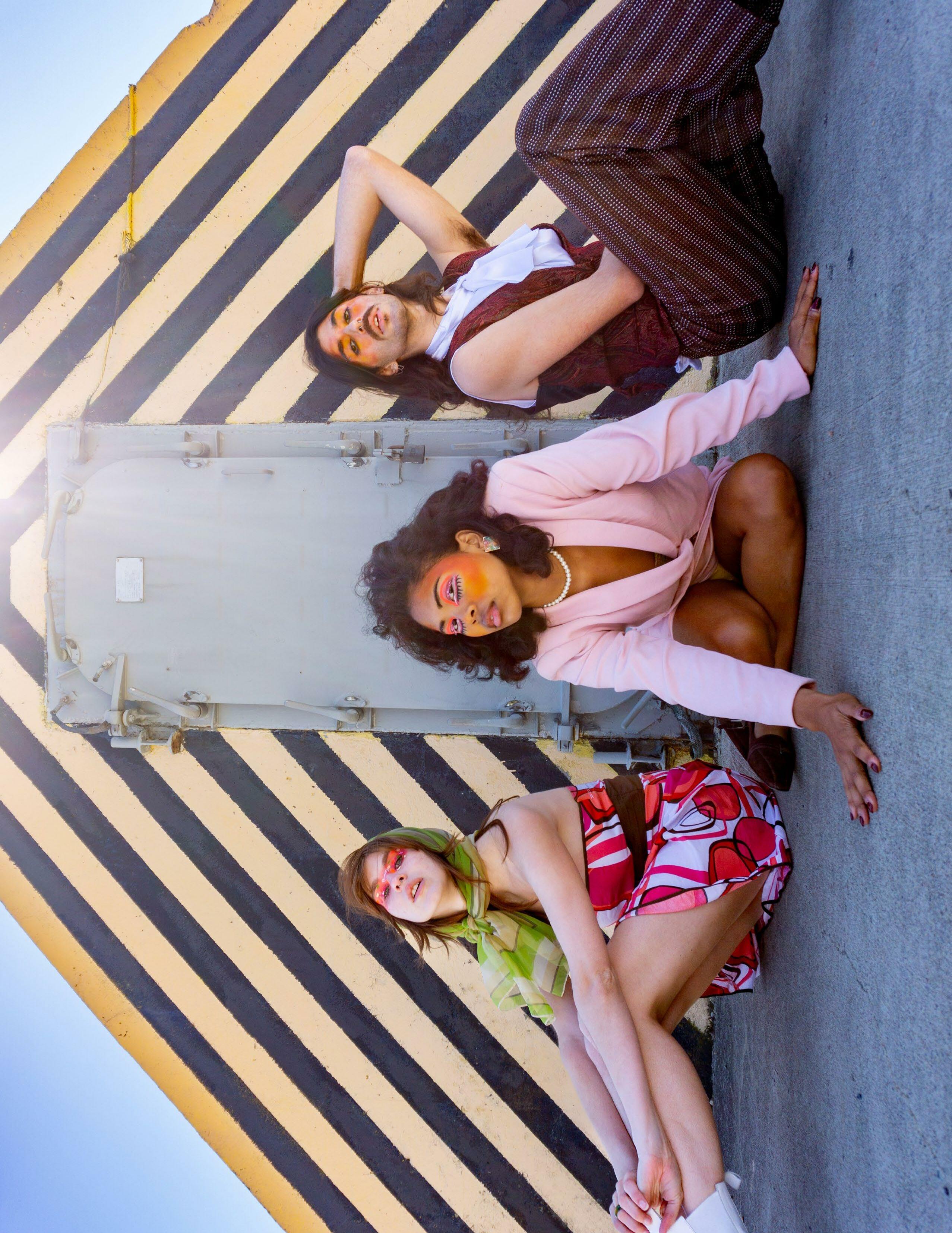
28
were shortening their own skirts, French fashion designer Andre Courrèges and Mary Quant, an English designer, were the first to pioneer the miniskirt. They were made in every color and pattern, including “Space Age” themed skirts, which reflected the future-friendly sentiments inspired by the ongoing Space Race. The trend of futuristic fashion fueled the Mod, or Modernist, clothing movement, an era characterized by more rulebreaking. Women did not have to follow the age-old rules of what to wear or who they should be — they could be anyone they wanted.
As women made their way into positions of power within the workplace and the wider world, the first pantsuit for women was designed. In 1966, Yves Saint Laurent debuted the “Le Smoking” tuxedo for women. Previously, the tuxedo had been a clothing item reserved for men, and with the advent of this suit, it became more socially acceptable for women to don them as well. As women gained social agency, so too were they able to better control what they wore and how they were perceived — a kind of power that, until the 60s, had been unheard of.
The ‘60s were about creative dissent and challenging norms amidst dwindling support for the ongoing war. The fashion trends of the decade represented a time of dissonance and redefining what it means to be ourselves. People dressed to be free and to express their passions, a pivot made possible through communities finding common ground. Clothes do not magically inherit the power to break boundaries on their own. Individuality is its own culture, but the community is a counterculture with the potential to restructure the ordinary.
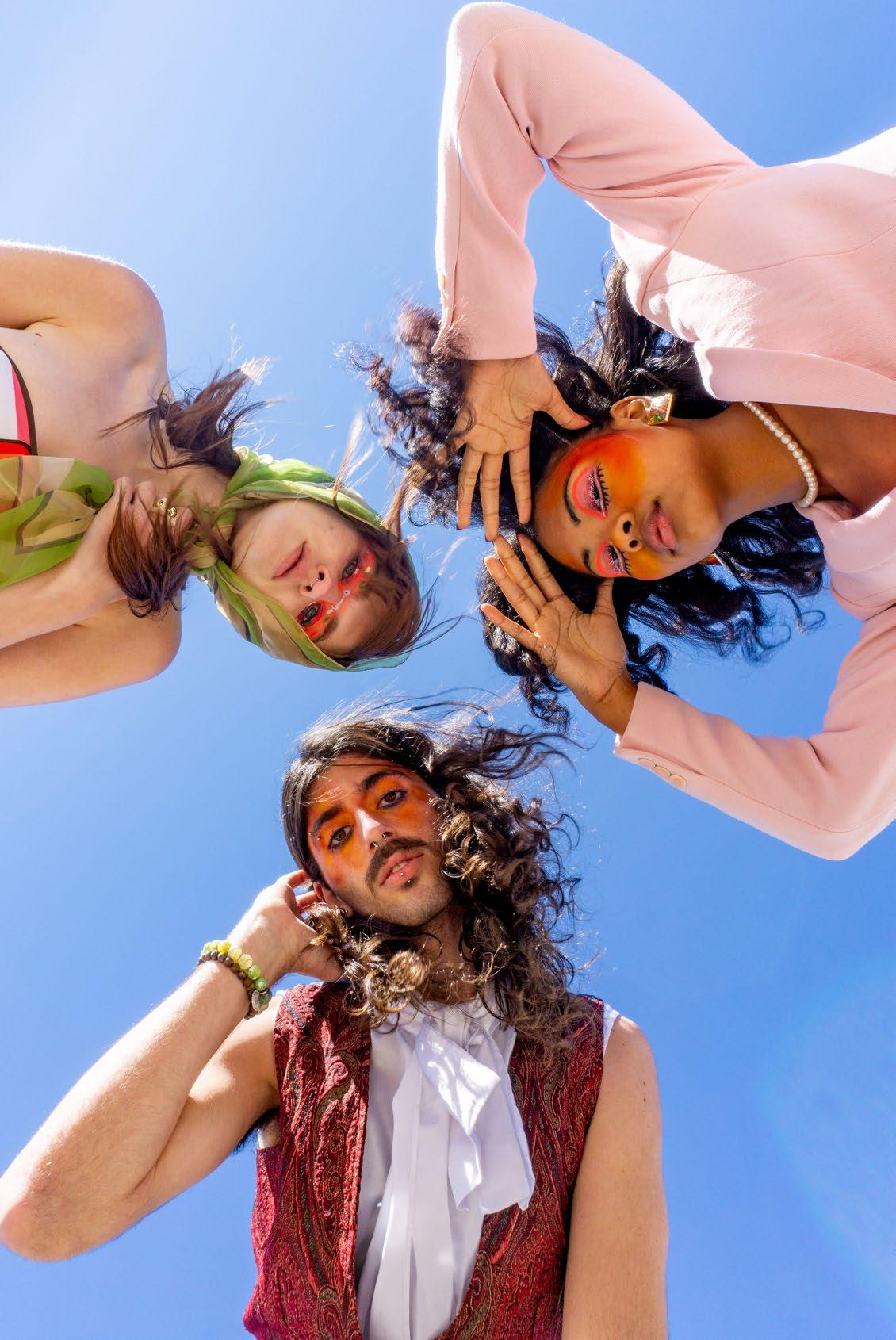
REDEFINING WHAT IT MEANS TO BE OURSELVES







30
FASHION IN FLUX



Is human evolution ever complete? Are our physical bodies reflections of our souls or impediments to humanity’s next stage of development? Ethereal fashion designer Iris Van Herpen’s latest collection, “Meta Morphism,” suggests that the human form is an ever-evolving concept. Our current state is not the end of Darwin’s thesis, but simply a point on the map of the human continuum.
Rarely does fashion send its audience spiraling into existential crises. However, toeing the line between fantasy and reality has become somewhat of a trademark of Van Herpen’s career — and “Meta Morphism” is no exception. Van Herpen explores humanity’s relationship with nature by delving into the lore of Ovid’s “Metamorphoses,” deconstructing the poem’s transformative themes to comment on humanity’s increasing reliance on technology. Through sustainable materials, a manipulation of shape and form, and celestial designs, the forwardthinking fashion designer is writing her own mythos of transhumanism, leaving the audience wondering how the next stage of humanity will emerge.
It is no secret that Iris Van Herpen is the fashion industry's unrivaled paragon of biomimicry. Even as a student at ArtEZ University of the Arts, her unconventional ingenuity was evident. What other student constructs designs from umbrella boning and metal boat paneling? Her designs are evocative of both a dreamscape and the future of fashion, combining whimsy and methodical modernity in an unprecedented manner.
Drawing influence from the beauty and chaos of nature, the shape of the human body, and the flow of movement itself, Van Herpen has defined her label with her surreal designs for the past 15 years. She hopes to elevate fashion beyond limiting labels such as a “garment” or “commercial product.” Instead, she operates under the more abstract definition of fashion: an art that explores its interactions with its surroundings. Even for Van Herpen, “Meta Morphism” is her most ambitious project to date; it posits that such otherworldliness is now fast approaching our lived reality.
writing SOPHIA NAUMOVSKI illustrations IAN NICASTRO design VANESSA PENG
Meta Morphism” reinforces that the human form is in constant flux. Its unique manipulation of form distorts models’ bodies along with our sense of reality, muddling our understanding of where the human form ends and art begins. The flowing silhouettes and exoskeleton bodices become an extension of the models, transforming them beyond the constraints of their natural figures. The draping of white tulle in the “Ananda-Maya” gown frames its model in a shroud of smoke, rebirthing her as a celestial goddess emerging from the heavenly clouds of Olympus. The billowing, copper sleeves of the “Singularity” jumpsuit become fluid appendages of the model, gliding with her as if they are one entity. These transcendental, mystic shapes elevate the models into supernatural beings.
As Arachne becomes the spider and Daphne becomes the Laurel tree, Van Herpen fabricates her own definition of a utopian reality through humannature symbiosis, an evolution sought after since Ovid’s time. The “Mano-Maya” and “Arachne” gowns breathe beauty into the woman-spider mythos, with the former enhancing the model with claw-like limbs and the latter entwining her in the of the collection materializes the myth of Daphne. the boundaries between clothing and body. Such through Ovid’s dream, where humanity and nature
The Maison's insistence on the sanctity of nature is further realized through its creative process. Van Herpen utilizes some of the most environmentallyconscious materials and tools to spawn her designs. In this collection alone, she employed biodegradable banana leaf fabric blended with raw silk, cocoa shell beans, and up-cycled and overstocked organza. Such eco-friendly inventions are made possible through Van Herpen’s use of cutting-edge technologies like 3D printing, laser cutting, and electroplating. Even as nature remains the essential player in her designs, Van Herpen embraces human technology as a tool for modernizing fashion. She realizes its potential as an asset to facilitate sustainability, rather than a threat to the natural world.
In this collection, technology is not only a means of production but a central theme in her work. “Meta Morphism” is more than a reflection on ancient mythology and the literal objectification of women’s bodies — it is a metaphor for humanity’s next leap in reality: virtual reality.
Where the metamorphic transformations of Daphne and Arachne are fantastical fables, transhumanism is a near reality, where humans seek to enhance their bodies and cognitive faculties beyond their natural capabilities. Though cyborgs are still science fiction, the advent of the Metaverse has made the virtual universe a concrete possibility. The Metaverse is opening a new dawn of humanity

32
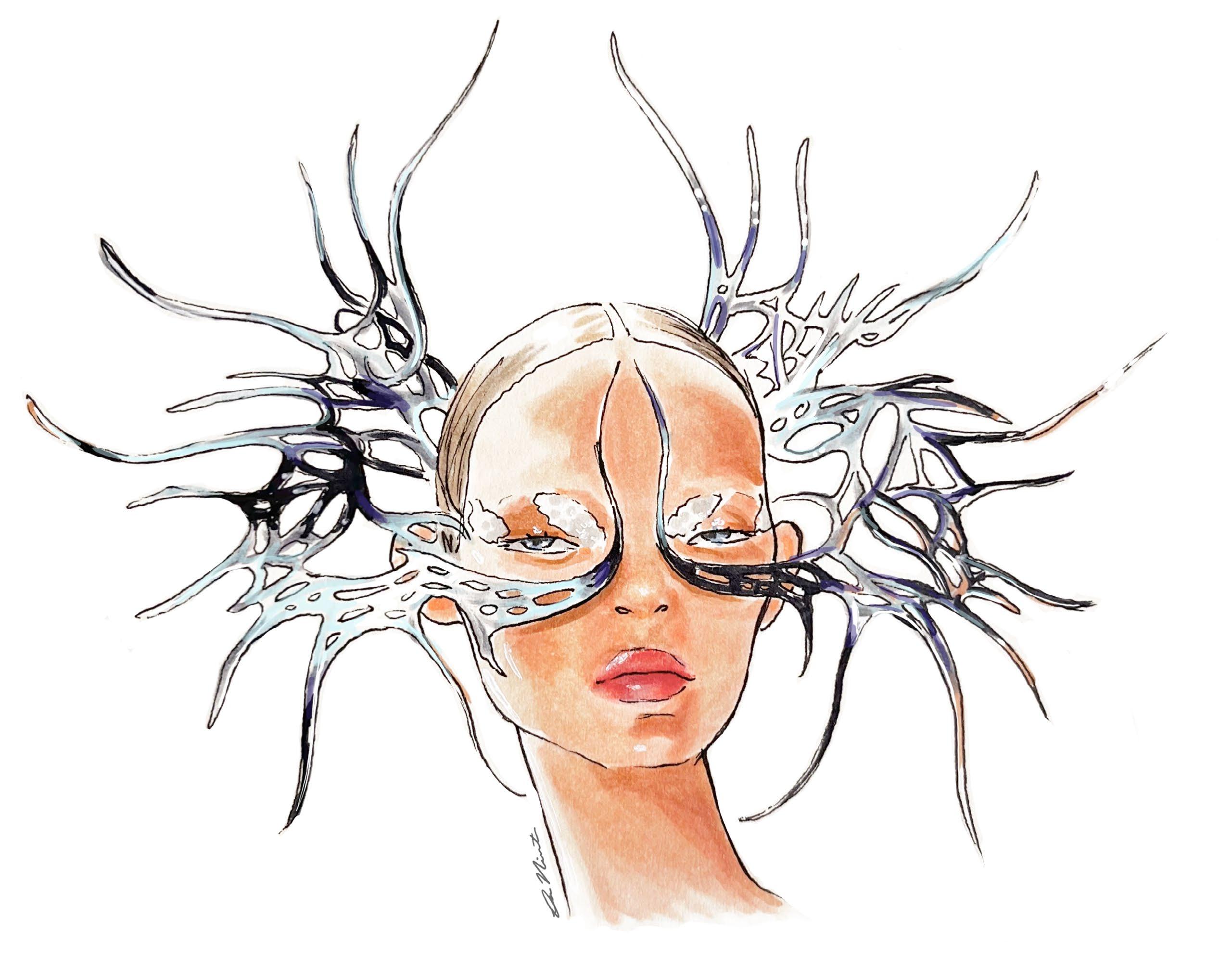

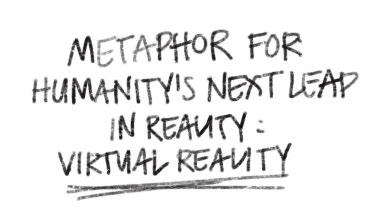
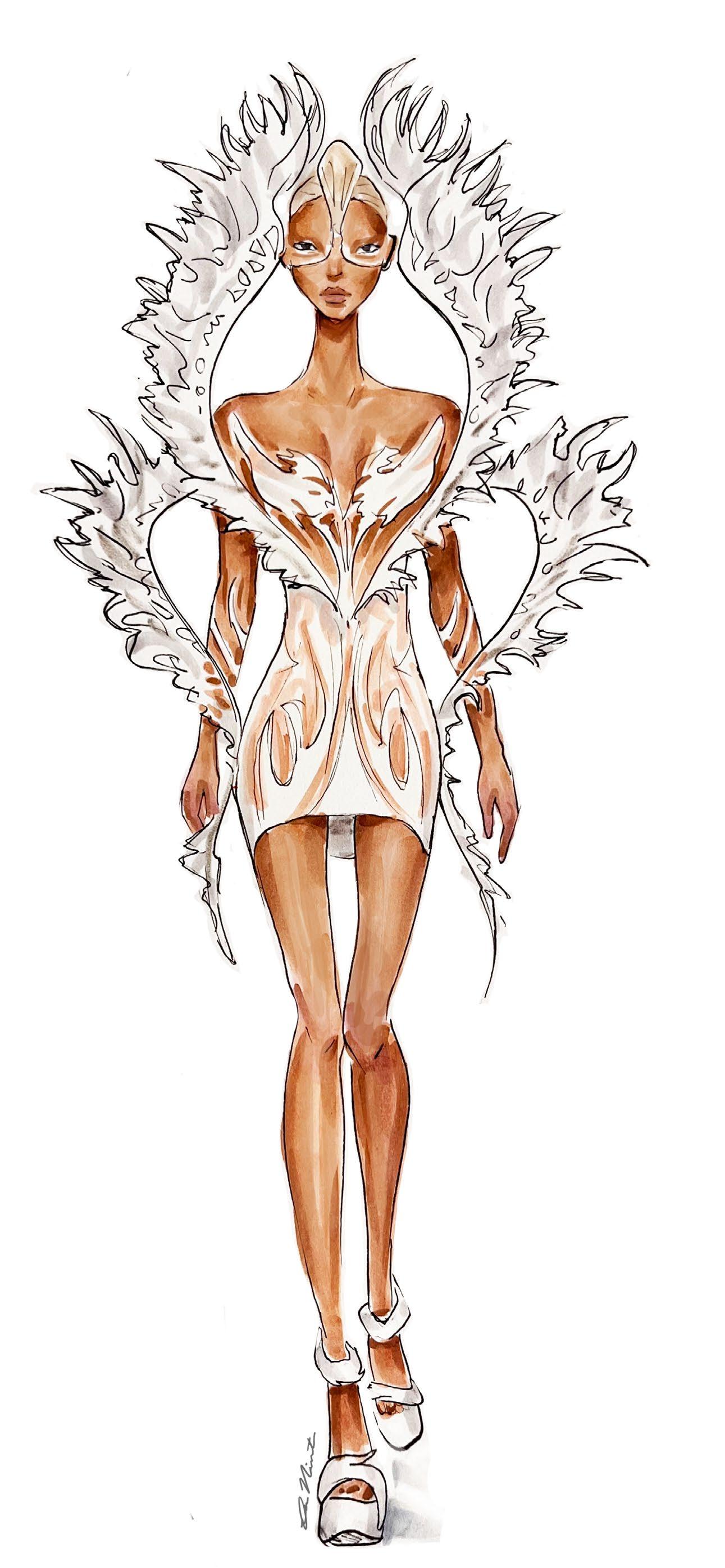



34
where socialization, work, and play may take place on a completely different plane, where humanity and technology converge as one. Reality is now being redefined, begging the question if such an “enhancement” is a blessing or a curse.
Will a virtual lifestyle threaten to dissolve our sense of self? What happens to the “real world” if life exists exclusively online? Just as Van Herpen finds the beauty in Daphne’s metamorphosis, she also finds it in the transhuman transition. The “Glitched Growth” dress allows the model to embody a futuristic cyborg form without sacrificing Van Herpen’s signature, ethereal style. The dress’s robotic, exoskeleton bodice is embossed in a reflective, silver coating and embellished with loose threads looping from the shoulders to the hem, reminiscent of tangled wires. The dress seems to imply that our bodies are still evolving; this is simply a stage in the negotiation of boundaries between human form, natural evolution, and technology.
As Van Herpen embraces these changes, she also warns of the hazards of transformation. Taking inspiration once again from Ovid’s genius, her “Narcissus” gown layers the model’s face against an embroidered white profile on a black organza panel. The model’s face blends with the dress and is swarmed by distinct, yet similar reflections of white faces throughout the dress, materializing the danger of both narcissistic self-obsession and a loose grasp on self-identity. The Metaverse provides an opportunity for people to redefine themselves, which can both promote self-expression and muddle our sense of identity. Assuming different identities between the physical and virtual may create a confusing and complex split reality.
evolution of form.
“Meta Morphism” is more than simply another haute couture collection festooning Paris Fashion Week’s runways. Van Herpen seized the opportunity to remind us that new technology is not a threat because it challenges conventions of humanity. In fact, she welcomes it as a tool for transformation. This collection is a supernatural experience, ushering in a new wave of reality at the nexus of nature, humanity, and technology. If anyone is guiding us on this intimidating journey of hyperreality, it's going to be Iris Van Herpen.


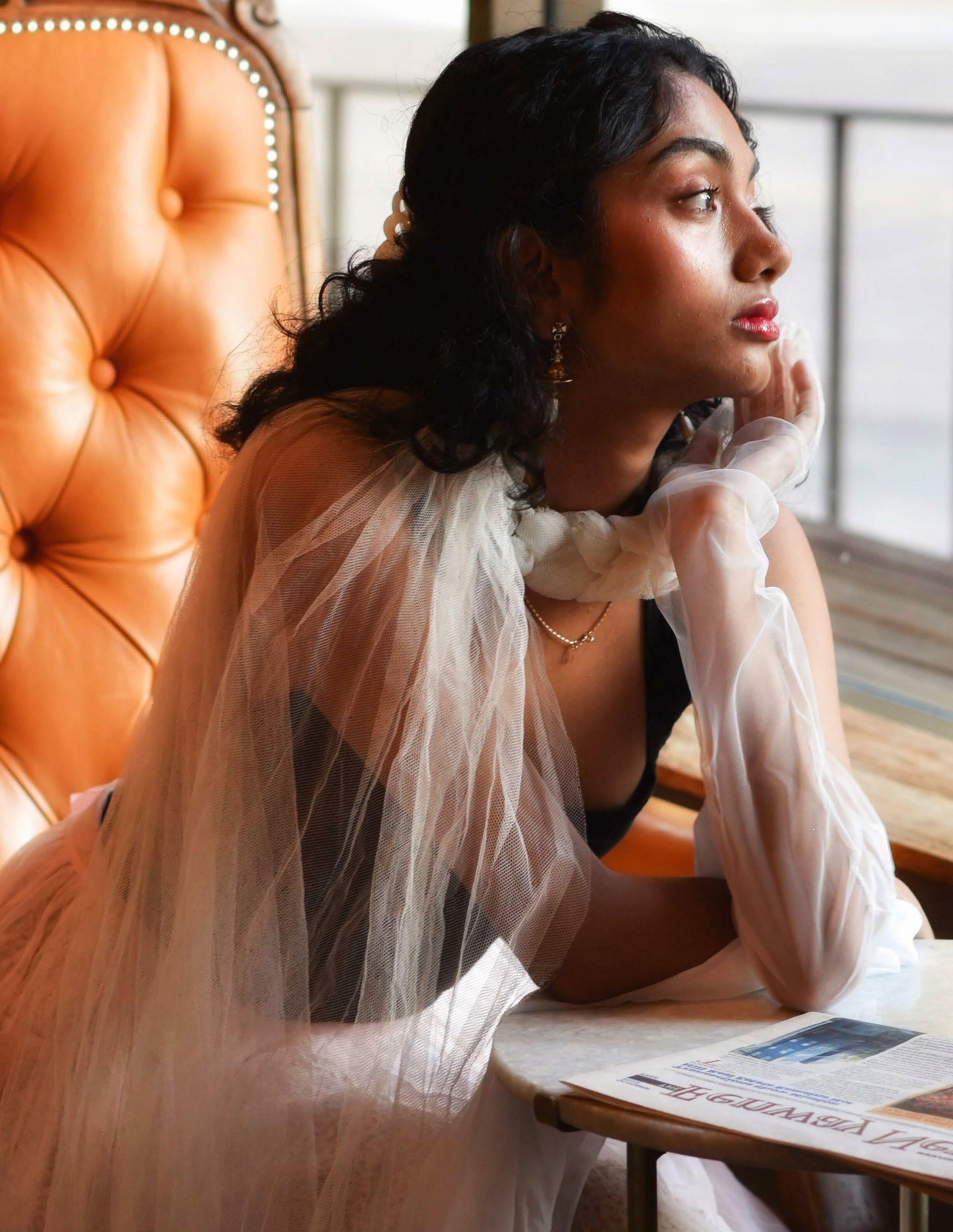



36
When the future is undefined, limitless, and unknown, it’s easy to feel overwhelmed. I often feel like I am sailing through choppy waters, with waves crashing in every direction. Uncertainty and instability are at the forefront of my mind, clouding any ability to remain present or optimistic.
Our generation has witnessed seemingly endless hardship. We were born right around 9/11, making fear an emotion ingrained from birth. We were taught how to hide silently underneath desks as news channels flashed headlines of the latest school shooting. We saw natural disasters that ravaged communities and took hundreds of lives.
I used to be the type of person who trusted that things would work out. I trusted that my life would fall into place and that I would become everything
I wanted to become. As my adulthood quickly approaches, I’ve found it difficult to maintain that optimism. When reality feels overwhelming, there’s comfort in an escape. I, like many others, will scroll through social media to find entertainment and reassurance in curated snippets of other people’s lives — ones that seem significantly more enjoyable by comparison. They appear more regulated, more beautiful, and more predictable, like a movie montage. I envied them and wanted to recreate this feeling in my own life. I needed to know if it was possible to regain the hopeful mentality of my youth through romanticizing life, and in turn regain the magic that it used to hold.
 writing NYREE CHRISTIANIAN
modeling SRISHTI GUMMARAJU photography KIRA BRIGGS design EMLYN GRIFFITHS styling YEANI KWON makeup MELANIE BAREST
writing NYREE CHRISTIANIAN
modeling SRISHTI GUMMARAJU photography KIRA BRIGGS design EMLYN GRIFFITHS styling YEANI KWON makeup MELANIE BAREST
To test whether romanticizing my life would actually make me feel better, I gave romanticism a threeday trial run. Three days where anything that didn’t make me feel fulfilled fell to the back burner. Three days of movie-montage soundtracks. Three days of loving myself and the people around me, hard and unabashedly. Three days of conscious effort to remain present, and trust that the life I want is coming my way.

The first day was a challenge — I couldn’t quite grasp how to remain present. I was so overloaded with deadlines that it felt nearly impossible to focus on myself. I spent the morning feeling anxious, and the afternoon feeling disappointed in myself for not checking off every item on my to-do list. To move past the feelings that would have previously demotivated me, I decided to look at my life as a story, categorizing this moment as a growth period; the rising action part of my story. I was able to gain perspective by journaling, engaging in my EFT tapping routine, and listening to the countless Spotify playlists built to inject a little more sunshine into my life.
The following morning, I was uncertain of the efficacy of my three-day trial but cautiously optimistic that it would be better than yesterday. My boyfriend and I were scheduled to fly out for my cousin’s wedding: we woke up before the sun and played music while we made the bed, grabbed our luggage, and eventually headed out the door to Mike’s Donuts. We sat in that tiny restaurant where we were regulars, and watched the sunrise through the café windows. I felt so full of love and so full of hope. I couldn’t wait to celebrate love with my love.
There’s no doubt that travel days can be tough for most people. My checked bags were not initially recorded in the airline’s system, but after a minor panic attack and a laugh with the lady standing next to me in line, my baggage tags were printed and we were ready for take-off. The remainder of the flight was easy, and my mani-pedi was waiting for me when we landed. I sank into the massage chair and pictured my ideal life, careless and worry-free. Spending a day on self-care is not something I usually prioritize, but I immediately felt grounded, in touch with myself, and able to take on the day.
38


the excitement and pure joy in the groom's eyes. A beautiful moment was made even more beautiful because I was present — my phone was buried in my bag, and my self-consciousness seemed to melt away when I danced. I felt like I was in a movie, watching the speedy exit of wedding crashers, overhearing two brothers reconnect, and slowdancing with my boyfriend.
I really wasn’t sure whether romanticizing my life would change how I felt, especially because it is such an abstract mentality. However, I felt real physical and mental changes. I have struggled with anxiety ever since I can remember, but at this event, which would have previously sent me into sensory overload, I felt in control of my emotions. I was reminded of all the strategies I had accumulated throughout my years in therapy and was able to
Even though I am still filled with uncertainty, romanticizing my life rewarded me with a smile that widened each time I reminded myself that I am in control. I get to decide what city I move to next and which career I choose to pursue; who I let into my life and who I let go. Who I am, and who I will become. I am the author of my own story. This time, I’m sailing toward the horizon, no matter the storm.

40






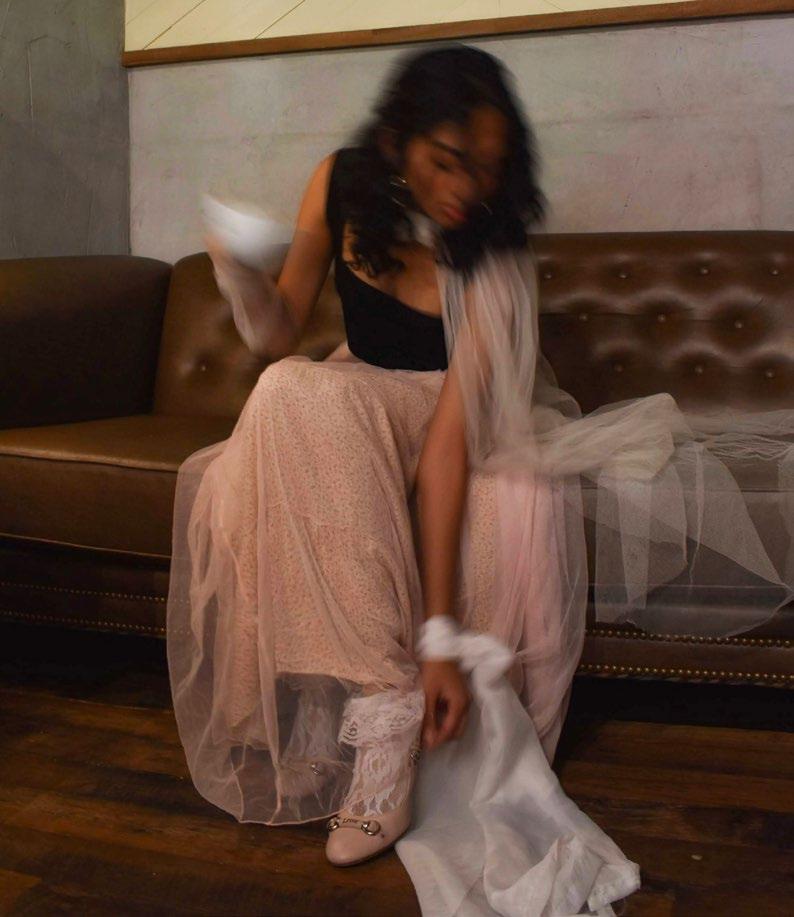



the sweet
We are obsessed with escape — the luminous, magical, the distant — obsessed with diverting from the dull monotony of our day-to-day lives and into better realities.path to healing.
Escapism is the desire to disengage from reality and escape into a world of wonder and fantasy. Designers draw inspiration from the fantastical and imagined to help wearers and audiences to break free from normalcy. Escapist fashion has been interpreted by designers both established and emerging, utilizing elements from science fiction, fantasy, and more. They seek to transport viewers of their collection to a new reality, one perhaps more bearable than the one we currently exist in. The imaginative nature of escapist fashion allows designers freedom from the constraints of modern, on-trend collections that may fall victim to blending in with the crowd. From ready-to-wear accessories to haute couture, designers of wearable art transport their subjects and audiences into their imaginations with their extraordinary creations.
Embroidery designer kaMILA of Mila Textiles enhances the human form with hand-embroidered bags and balaclavas. The one-of-a-kind accessories are like their own miniature worlds, which are exploding with vibrance and color. kaMILA’s stitch work is embellished with beads and sequins and, according to their website, is “inspired by natural surroundings with a touch of surrealism.” Their designs look like colonies of coral polyps from afar, but a closer look reveals dense patches of hand-stitched embroidery thread, clusters of tiny beads arranged in spikes like sea urchins, sequins, pearls and iridescent beads that sparkle and shine, and the occasional grinning critter. kaMILA posts photos modeling the playful, saturated balaclavas and nothing of their face shows except for the expression they wear on their eyebrows and dark eyes. Instead of being lost in the explosion of color and life of the piece, the juxtaposition of reality and the surreal makes the mask wearer’s eyes become even more entrancing and somber, as if they are yearning for the imagined world the mask comes from.
Wearable art is not only a means for escape, but a tool to enhance the escapist visions of their wearer’s imaginations. As such, these extraordinary pieces are often worn by performers and music artists onstage or in music videos to heightenthe illusion of fantasy. Fashion has always been entwined with the music industry, and has become a way for performers to both assert their individual brand to their audience and create a memorable experience at concerts, in their music videos, and walking red carpets.
42
escape
 writing GRAY TIMBERLAKE modeling YENE USUA photography SERENA BUSCARELLO design SOPHIE FIKS makeup SOFIA URRUTIA styling WOODY LINDOR
writing GRAY TIMBERLAKE modeling YENE USUA photography SERENA BUSCARELLO design SOPHIE FIKS makeup SOFIA URRUTIA styling WOODY LINDOR
Rapper and singer Doja Cat takes us to the world of “Planet Her” in her “Need to Know” music video, a space-travel themed number full of holograms featuring a star-studded clique of aliens — including an elf-eared Grimes. Doja Cat’s skimpy space outfit contrasts massive, out-of-this-world Windowsen FW21 Athletic Platform Thigh High Boots. Windowsen’s Creative Director, Sensen Lii, combines exaggerated costumewear and sportswear in their dramatic, genderless designs. Inspired by science-fiction media like the TV series Black Mirror, Windowsen’s futuristic wearable art effortlessly enhances Doja’s otherworldly allure.
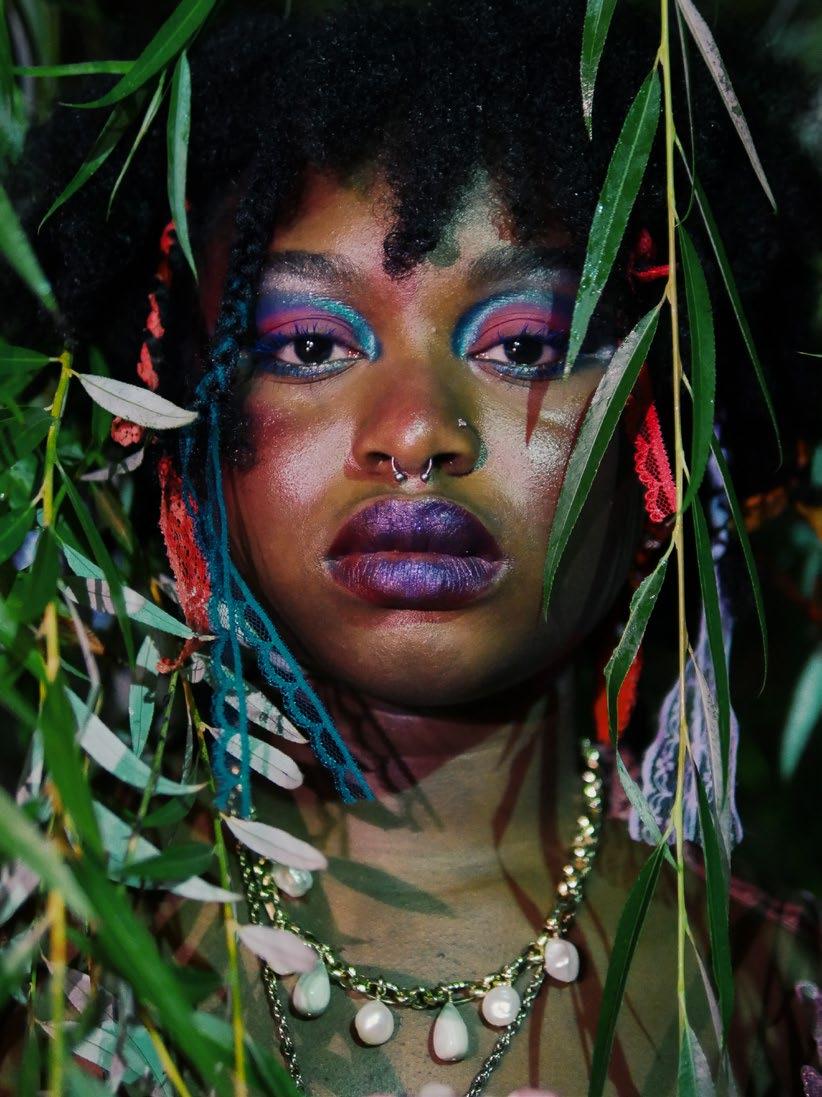

Like Doja Cat, futuristic dance-pop artist Grimes’ music videos also break viewers free from reality, and she uses otherworldly art and fashion to enhance the imagined worlds that exist in her videos. Grimes’ “Shinigami Eyes” music video brings us into a world that bears no resemblance to our own. “Shinigami Eyes” evokes a glitchy, trippy, futuristic escape, exploding with holograms, color and fantasy, where cyborg women duel with shiny metal swords and laser beams. This world is electric and techy, but a closer look reveals much of it is influenced by the natural world. The abstract, spiky metal mask Grimes wears enriches these biopunk aesthetics that are the core of the video.
The mask was created by Lance Victor Moore, a self-described mask-artist, face jewelry creator, and avant-garde fashion designer who has created fantastical pieces for the likes of Grimes, Machine Gun Kelly, Iris van Herpen, and Lady Gaga. Moore gives animal products like horns, bones, and leather a second life by resurrecting them into nature-inspired face masks. He uses parts of animal carcasses as the base of his pieces, but he transforms them into wearable art with a metal and punk style — giving bear-fanged skulls metal grills and embellishing leathered pony skin with large studs. His masks cover most of the wearer’s face, but he says his pieces make people feel more free, as they can be anyone in any world while wearing them.
Escapism is meant to take us out of our world, but it often brings us right back to it with inspiration from its natural elements. At the same time, escapist art and fashion can truly take those who experience it out of their world, as artists are creating surreal, fantasy worlds to escape to, with wearable art functioning as the conduit.
44
take us of our world out
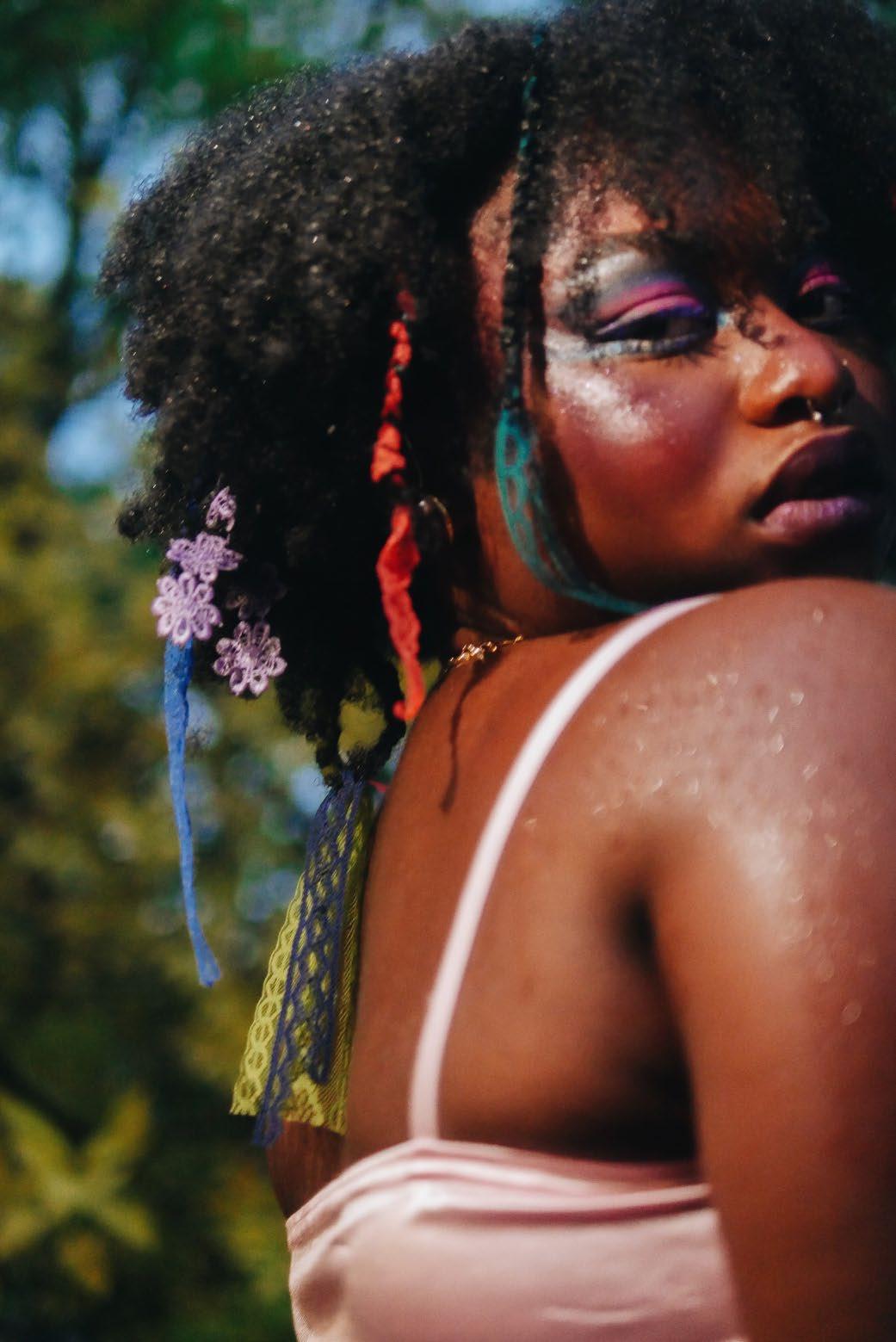
PSYCH- EDELICS
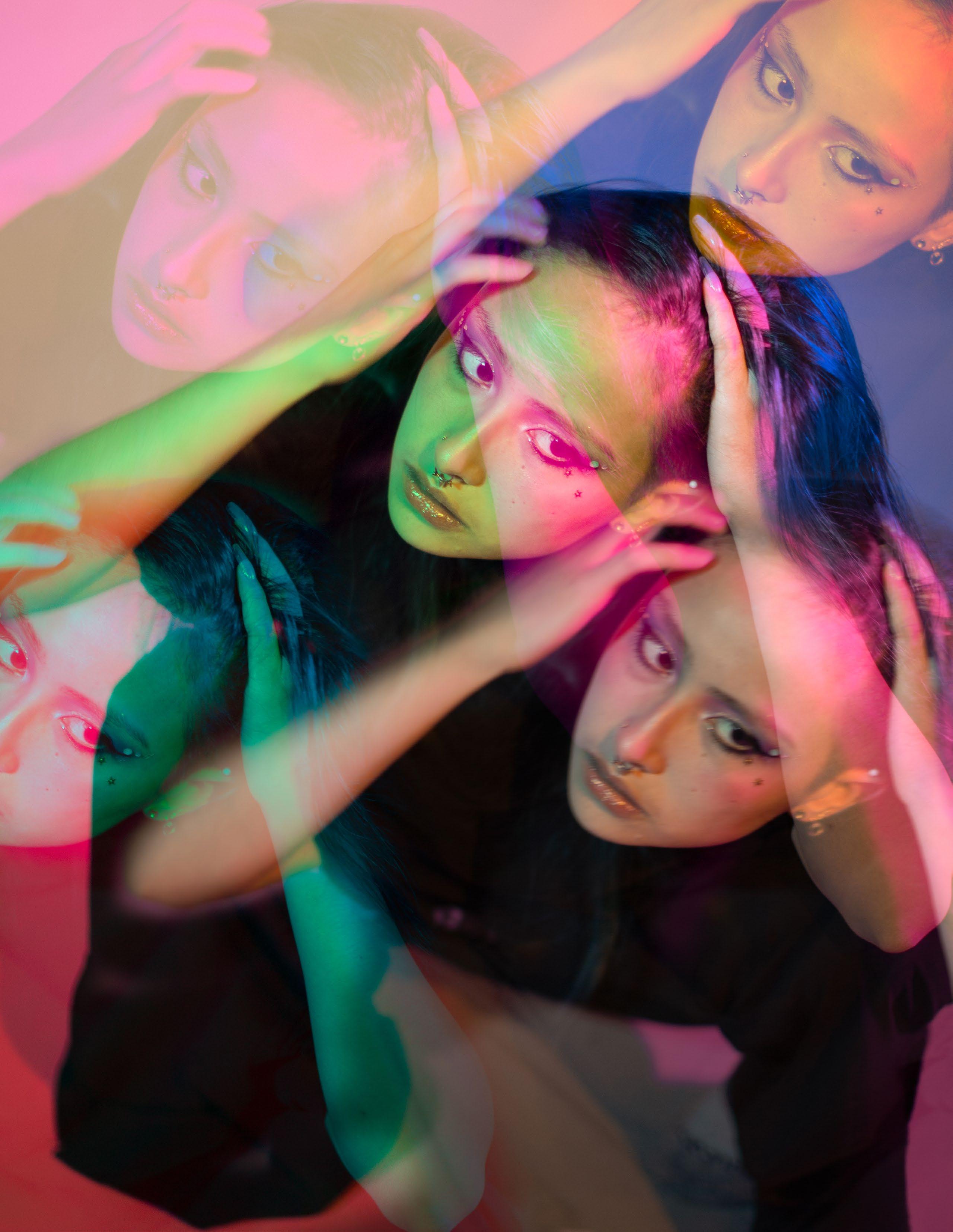
46
What does the word “psychedelic” bring to mind? One might imagine the Beatles tripping out with tangerine trees and kaleidoscope eyes, or Alice discovering Wonderland. Aside from fanciful lyricism and surrealist literature, the term “psychedelic” is used to describe the class of hallucinogenic drugs that run the gamut of LSD, psilocybin mushrooms, ayahuasca, and peyote.
Throughout history, psychedelic drugs have served countless functions and become important cultural phenomena. Some use psychedelics for religious and spiritual experiences, while others use them socially at parties or festivals. Many people try them out of pure curiosity. Beyond making one hallucinate, many believe psychedelics grant us the ability to see life through a different lens.
Psychedelic drugs have long been associated with escapism. LSD, for example, is known for its crazy, colorful psychedelic properties and its ability to trigger transformative, mind-altering experiences, or “trips.” What better escape than to enter a seemingly alternate reality filled with bright colors and eccentric hallucinations?
But for many, using psychedelics isn’t necessarily about escape. Although LSD is a hallucinogen, having an “acid trip” probably won’t make one see things that aren’t there. LSD does cause visual distortions like swirling patterns and movements among still objects but is best known for its effects on your mindset. Researchers don't fully understand the effects of LSD and other psychedelics on the brain, but previous studies have revealed that they depress certain parts while stimulating others. A series of brain scans conducted by experts at the University of Sussex and Imperial College, London found the drugs to induce a “heightened state of consciousness” overall.
LSD may trigger euphoric feelings and intense empathy. People on psilocybin mushrooms might experience similar excitement and giggles. However, these drugs can just as easily induce a state of intense paranoia and anxiety, also known as having a “bad trip.” Whether one has a good or bad experience depends on their mood and surroundings, signaling that the psychedelic experience greatly amplifies what the user is already experiencing.
writing WRAVEN WANTANABE modeling LINA PETRONINO & WRAVEN WANTANABE photography AMANDA KERR design RACHEL OSBORNE styling WOODY LINDOR
OF
Aside from altering emotions, psychedelics are characterized by their ability to elicit a deep preoccupation with their present surroundings. Someone on LSD might become fascinated with an element of their environment, fixating on it for long periods of time. Such preoccupation might also come in the form of emotionally connecting with someone else or reflecting upon oneself. Since the drug can inspire intense contemplation or soul-searching, many describe their experiences as profound mental or emotional journeys. Rather than providing an escapist reality, psychedelics can allow people to very deeply connect with themselves and their environment.
The “psychedelic experience” contrasts with much of what younger generations like Generation Z experience. From cell phones to social media, we exist in a hyperconnected era. We’ve grappled with a global pandemic, climate disasters, and a mental health epidemic, so one might think escapism would be in high demand. However, it’s not everyone’s cup of tea. Some, left listless by the pandemic or weary about the future, might gravitate towards psychedelics in the search for an entirely new lease on life, or at least a different lens through which to view the world. Some may only try them once, whereas others will have countless psychedelic experiences over their lifetime.
Regardless, more and more people are interested in psychedelic drugs, and the social and cultural trends of our generation are a hint as to why their popularity is increasing.
Today’s rise in psychedelics draws parallels with the popularity of LSD during the 1960s. At the time, a counterculture movement was taking place, born from the anti-war sentiments of young people — LSD was partially a symbol of that movement. The culture that arose culminated in the “Summer of Love” in 1967, a social phenomenon that drew roughly 75,000 young people to the streets of San Francisco to usher in a new era of liberation by way of fashion, ecstasy, and Utopianism. While Gen-Z isn’t gathering in the thousands to do psychedelics together, we are seeing the undercurrents of a new social revolution. The Black Lives Matter movement (BLM), the anti-work movement, and global support for Ukraine are examples of the shifts we are seeing. So, while psychedelics don’t represent our generation in the same way they represented the free-spirited folks of the 60s, their popularity and usage are representative of young people seeking change.
Ultimately, psychedelics are just a small category of the countless recreational drugs that humans use. Their popularity is rising, but they aren’t used as widely as alcohol and marijuana. Regardless of the numbers psychedelics are extremely culturally significant. From our ancient ancestors first discovering plants with hallucinogenic properties to hippies doing LSD at Woodstock, they have played an important role in our collective social development. Although everyone has different experiences with psychedelics, it’s clear that the most important thing they can do is allow us to see things from a unique perspective.
48


WHAT BETTER ESCAPE THAN TO ENTER A SEEMINGLY ALTERNATE REALITY FILLED WITH BRIGHT COLORS AND ECCENTRIC HALLUCINATIONS?

& BEAUTIFUL COQUETTE REFERS TO A FASHION STYLE CONSISTING OF A CLASSIC, ROMANTIC, AND HYPER-FEMININE APPAREL 50
YOUNG
 writing ISABELLA BERNSTEIN modeling BITA ADEL-ZADEH & SOFIA FRANCHESCHINI & MARISSA MUNOZ photography OLIVIA LEON design SYDNEY SINGH styling ADRIANA ALVAREZ makeup CLARISA ZALLES
writing ISABELLA BERNSTEIN modeling BITA ADEL-ZADEH & SOFIA FRANCHESCHINI & MARISSA MUNOZ photography OLIVIA LEON design SYDNEY SINGH styling ADRIANA ALVAREZ makeup CLARISA ZALLES
From the minute her first album, “Born To Die,” was released, Lana Del Rey has been a fashion and cultural inspiration. She burst onto the music scene in 2012, quickly becoming a prominent icon on social media app Tumblr in the early 2010s, and has been idolized across platforms such as Instagram, Pinterest and TikTok for the entirety of her career. Often labeled as “sad-girl” pop, Del Rey’s raw, personal lyricism and dreamy musical style serenades listeners directly. Her accessibility — particularly in these online spaces — has made her extremely influential. Del Rey’s 1950s and 60s Americana-inspired aesthetic pairs flawlessly with her emotional and glamorous lyrics, making for a perfect source of inspiration for style-inspo videos, movie edits, and photo captions.
A common tag on posts utilizing Lana Del Rey’s media is “#coquette,” a word defined by the dictionary as a flirtatious woman. Recently, the idea of a coquette refers to a fashion style consisting of classic, romantic and hyper-feminine apparel. Coquette style contrasts girlish charm and luxurious sex appeal, and is dominated by dainty patterns, lace and frills, bows, natural makeup and light neutral colors, punctuated by deep reds. The expansion of coquette’s dictionary definition to a complex subculture can be credited to Del Rey’s lyrics, which are arguably the most interesting and influential aspect of her artistry.
Famous for dialogue about taboo topics such as drug use, violence, naivety and unrequited love, Lana Del Rey is a master at mixing sad motifs with romanticism and opulence. Her risqué lyrics have garnered controversy over the years, but these illicit

52
topics are most likely the biggest appeal to her music — their shocking nature and raw humanity are what make them influential and powerful.

Del Rey’s lyrics glimmer with vintage romantics, melancholia, and luxury. Songs referring to luxury items, like “The Other Woman” and “Off To The Races” have inspired listeners to love high-end designers including Chanel, Dior, and Vivienne Westwood. But this is just the tip of the iceberg. Del Rey often alludes to youthfulness and adolescence, as seen in songs such as “Lolita” and “Carmen,” and unreleased songs such as “Put Me In A Movie.” These allusions parallel the girly, bashful and seemingly innocent essence of the coquette, explaining the bows, frills, lace, and ballet attire that is seen throughout the style.
Lana Del Rey often references clothing and makeup in her songs. She mentions heart-shaped sunglasses in “Diet Mountain Dew,” a 50s babydoll dress in “Yayo,” and says “I keep my lips red” in “Black Beauty.” These references have direct influences on her listeners. The stylistic philosophy Del Rey is known for has quickly become a staple of coquette fashion. When Del Rey makes explicit references to pieces in her wardrobe, her listeners are able to purchase their own versions. This is part of what makes Del Rey so magnetic — anyone can wear what she sings about and recreate her air of glamor.
Lana Del Rey’s lyrics are not her only influence over the rise of the coquette trend. Soft vocals, effervescent melodies, and classical and jazz influences have characterized Del Rey’s music across her many albums. She often utilizes
euphonic instruments such as the piano, violin, and harp, seen most prominently in her 2019 album, “Norman F****** Rockwell.” This accentuates the sense of classic, romantic and victorian lusciousness in her music, coupling her work further with the ornate nostalgia of the coquette style. Del Rey’s vocals — soft, high, and whispery — have a feminine, flirty and innocent charm like no other. The mixture of these dream-like harmonies and mature lyrics are embodied in the coquette style, as it combines both elements with its contradictory youthful girlishness and quiet sex appeal.
Lana Del Rey’s music videos — perhaps closer to short films or video art — are equally as significant as her lyrics. Del Rey masterfully pairs her retro-chic visuals and personal style with her music, furthering her influence on the way her listeners dress. Her natural makeup is often paired with a graphic 1960s liner, as seen in “National Anthem.” White, lacy dresses, heart-shaped sunglasses, and pearls have become staples of the coquette style for their lovely, elegant, slightly provocative and — most importantly — nostalgic flavor.
Lana Del Rey’s visual iconography and recurring motifs also contribute to the style as a whole. Her use of flower and water imagery coincides with the florals and flowy materials that dominate coquette clothing. Most of Del Rey’s videos are filmed on old,
grainy cameras, or in black and white, making her work look like it is straight out of a time capsule. This presentation matches her evocative, retro lyrics and melodies, and is yet another tie to the vintage look of coquette.
The coquette style of clothing is not isolated to internet and commercial fashion trends. Recently, high-fashion designers have been inspired by the modern day coquette, elevating the style on runways around the world. Australian fashion house Ozlana showed a stunning collection — each look complete with bows, pastels, hearts and pom-poms — in Winter of 2021 at Shanghai Fashion Week. Sandy Liang’s Spring 2023 collection incorporates coquette’s classic girlish pleated skirts, flowy fabrics, bows and braids. In October of 2021, Marc Jacobs dropped a collection inspired by Sofia Coppola’s The Virgin Suicides, a staple of the coquette subculture.
Not a soul captures lovely nostalgia as effortlessly as Lana Del Rey. She has truly brought the past back to life with great technicolor and her own modern twist. Coquette holds an innocent, feminine beauty that has been ever present throughout the ages – it is centered around the concept of love. Everything Lana Del Rey creates embodies this. What could be more “classically feminine” than love, the desire to love, and the desire to be loved?
54
IT COMBINES BOTH ELEMENTS WITH ITS CONTRADICTORY YOUTHFUL GIRLISHNESS AND QUIET SEX APPEAL

HEALING THROUGH

MINDFULNESS
56
I still remember the very first time I entered the orange room and met my meditation instructor: Berna. The room was strikingly large and enclosed by warm orange lights. I placed my backpack on the ice cold floor and my attention immediately turned to the aromatic smell that came from the incense on her table side.
“Gently close your eyes and take a breath in,” Berna said, as I caught myself fidgeting with the pillow she gave me to sit on.
Since I was 14, I had struggled with anxiety on a day-to-day basis. Some days were better than others, but overall, it was a challenge for me to get through just three full days without breaking down or feeling drained.
On the harder days, I felt like I only had the energy to be upset. It was like I was sinking underwater — into the deep, blue ocean, where the darkness seemed to have taken over my sense of self, future and identity. I wished I could swim back to the shore, but the waves kept dragging me back out.
It had come to a point where I knew I had to ask for help. After many different trials of several different practices, I finally decided to enter the world of mindfulness: the practice of seeking comfort from my breathing and from within.

As Berna instructed, I took a breath in, but my mind was racing with thoughts. I was bored and didn’t feel comfortable, but I became patient with the practice and began to feel calm.
“Place your hand over your heart, and start taking care of your inner child,” Berna said. “The one that feels abandoned, the Kat that needs love and care. Don’t leave her alone, because you are truly loved.”
Tears started trickling down my face and a wave of emotion rushed through me. I was confused by how I felt — I thought meditation was supposed to make me feel more calm and centered, so why was I crying? Was the practice itself a trigger, or was I finally confronting all of my suppressed emotions?
Over the next few months, Berna and I continued uncovering these hidden emotions. It took some time for me to sit still and be at peace with my heart, but once I slowed down and observed the way my body moved, everything gradually began to piece together.
writing KAT TSE modeling KAT TSE photography KATHLEEN MA design SOPHIE FIKS styling GIGI GILLEN
Six months later, I bought a notebook and began to write. I wrote all of my thoughts, worries and fears down onto the pages of my notebook. From the test I had to take at school next week to the things I hated about my body, every single thought that appeared in my brain was written.

It was through this practice that I started to distinguish what I do and don’t have control over.
A few weeks later, Berna and I burned these pages. We watched all my most destructive thoughts go up in flames. The “unrealistic expectations” were now specks of ash in a fireplace. Over time, I realized that I shouldn’t have to worry or beat myself up over situations that were beyond my control. It’s nice to reminisce about the past every now and then, but I must be careful to not sink back into that hole.
For me, the most helpful meditation practice was thinking about the past, then bringing my breath and my mind back to the present. It was a mind technique that I had to slowly master from within.
I realized that the uncertain feelings of guilt stemmed from my childhood traumas, and fresh betrayals, such as my recent breakup, triggered a constant battle between my mind and heart. Once I started to become more aware of my triggers and emotional patterns, I could start to feel a sense of ease and comfort with my own company.
Over time, I learned my boundaries — what I liked and disliked. I learned how to give myself space and time to reflect instead of jumping to conclusions. It was these breathing and mindfulness exercises that brought me this level of clarity. It was taking a small pause from the busy hustle culture to reconnect with myself and my inner child. With these new tools in my arsenal, I slowly started to heal from my past traumas.
Today, I can use this technique anywhere I want — not just in the orange room. I could go for a walk around the park and truly take in my surroundings. I could admire how the trees swayed side by side, how the birds chirped and how the rays of sunshine felt as they brushed past my face. I began truly appreciating the small wins that life could offer me, and became grateful for the little things that I might’ve previously taken for granted.
58
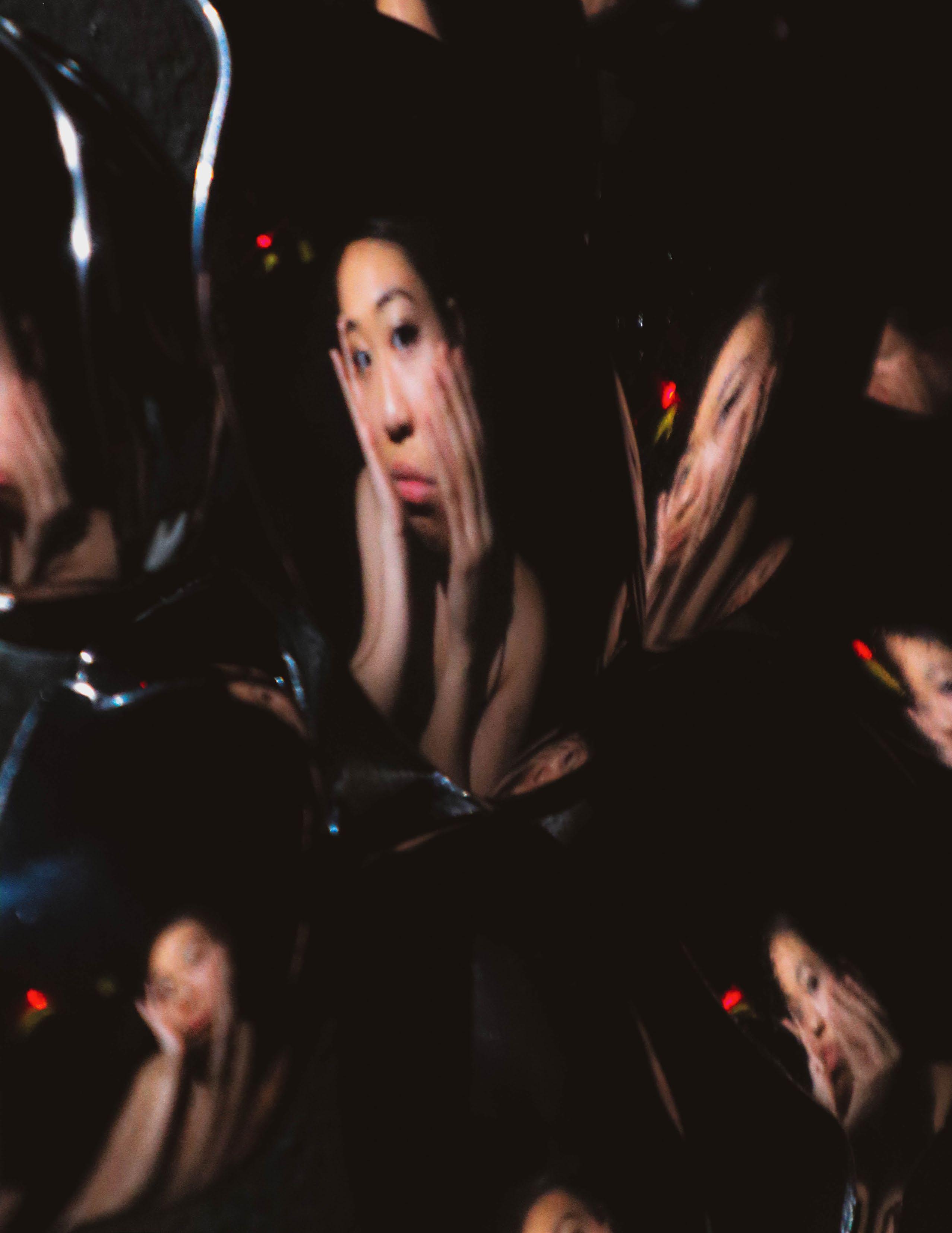
AT THE END OF THE DAY, IT ALL CAME BACK TO MY BREATH, MY BODY, AND ME
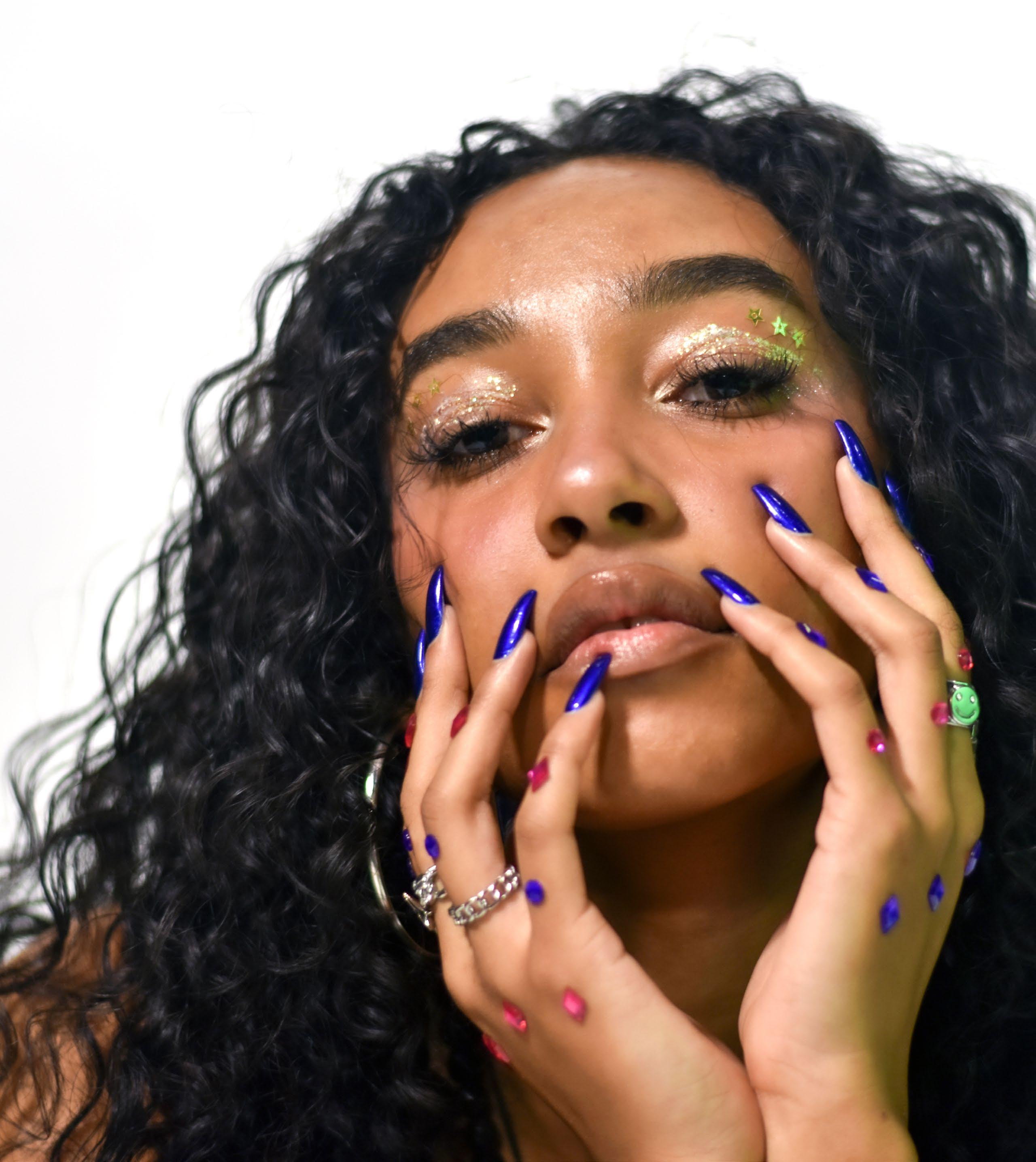
60
writing RACHEL ERWIN modeling SAMANTHA DIAZ & SAM LEVIS & TANYA VERMA photography SYDNEY SINGH design SYDNEY SINGH styling GIGI GILLEN makeup CLARISA ZALLES
GLITTERS ALL THAT

This year, I struggled to come up with a theme for my birthday party. I wanted it to be something fun, flashy and affordable for my friends.
It had to be glitter.
Glitter is everywhere: it’s in Sephora, Party City, Target and most likely your favorite corner store. It usually comes cheap, priced below $5 per offering. You can find a glittery version of almost anything, ranging from edible sparkles to a dazzling cowboy hat.
Glitter has been a part of my life for as long as I can remember, and it’s been a lasting presence on Earth since 40,000 B.C. Mica, a glittery mineral found in rocks, can be found in cave drawings and on Mayan temples. Later on, Egyptians, including Cleopatra herself, used crushed beetles to adorn their faces with glitter.
The glitter we use today originated in 1934 when Henry Ruschmann discovered a way to use plastics and other landfill materials to make packaged glitter. Decades later, glitter has become a beauty staple. Notable brands like Revlon and Estée Lauder were among the first to formally introduce glitter to the beauty industry in the 1960s, an era defined by a “refined shimmer” rather than bold, bright sparkles. The 1970s and 80s saw more daring uses of glitter, from David Bowie’s glittery alter ego, Ziggy Stardust, to the rise of British glam rock. By the
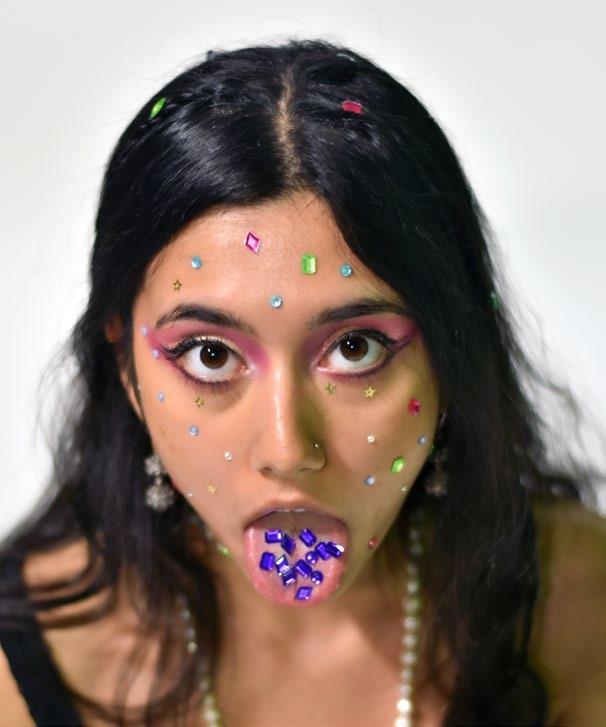




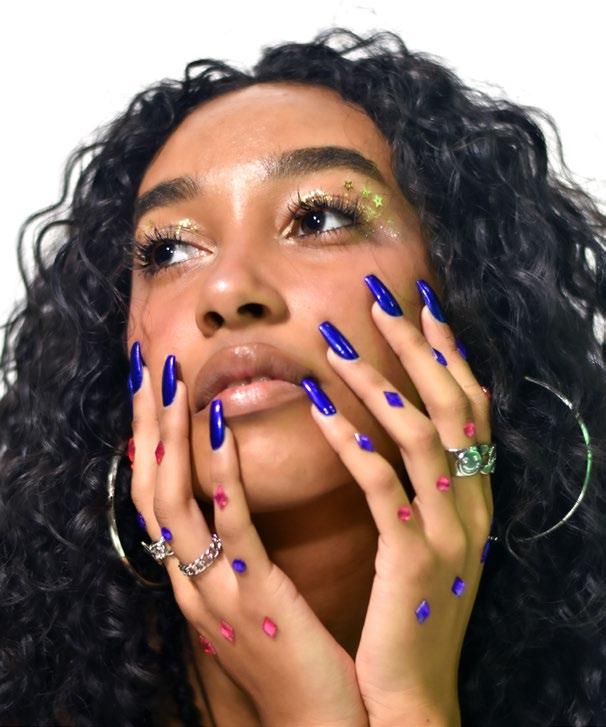
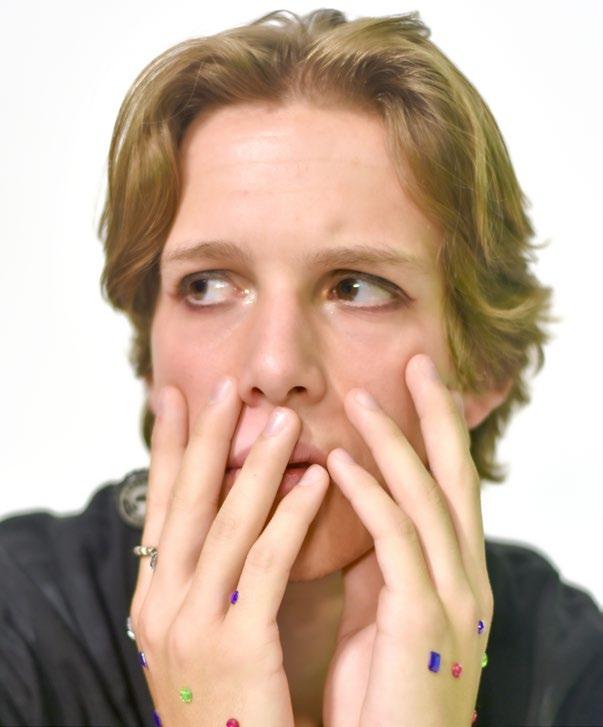


62
1990s, glitter had taken over products marketed to young girls, with sparkly school supplies and fashion accessories filling the shelves at stores like Claire’s and Limited Too.
What was once just an accessory, has become a tool of expression and rebellion used by marginalized groups. Looking beyond the Euphoriathemed parties and the Fenty body sauce, one will see the countless ways feminist and LGBTQ+ activists have made glitter their weapon. In a sense, it is the perfect battle tool for those seeking a nonviolent form of protest.
2011 signaled the start of “Glitter bombing” — the act of showering someone in glitter, first employed by activist Nick Espinosa against right wing presidential candidate Newt Gingrich. At a book signing, Espinosa doused Gingrich in rainbow sparkles, making a statement about Gingrich’s disdain for the LGBTQ+ community. For Gingrich and other right wing politicians, it was perceived as a threat to their masculinity, as a spray of a feminine powder is undoubtedly as dangerous as a nuclear weapon. Additionally, when trying to clean up glitter, it is nearly impossible to find every fleck, which added to the politicians’ frustration.
GLITTER IS USED AS A WAY TO CELEBRATE AND EMPHASIZE
In a statement against body negativity, individuals on social media have started their own rebellion, painting their stretch marks with gold glitter and calling them “tiger stripes.” In this case, glitter is used as a way to celebrate and emphasize a feature that once made someone insecure. It puts the power back into the hands of people who have been badgered and bullied for their natural bodies.
In a few major cities like New York and Chicago, queer-friendly churches are mixing ashes and purple glitter on Ash Wednesday in a movement titled “Glitter+Ash.” Glitter Bombs for Choice, a group of pro-choice activists, mails anti-abortion organizations packages filled with glitter, in a statement that people with uteruses should have control over their reproductive decisions. While the LGBTQ+ community has used glitter as a form of expression for decades, it has also long been associated with women most often perceived as a trivial display of femininity and vanity. Glitter may appear frivolous and soft, but when used as a weapon, it can be a powerful tool of public humiliation and shame.
IT ADAPTS AND EVOLVES, EACH TIME A LITTLE MORE POTENT
Following an alleged sexual assault of two girls by a police officer, feminist activists in Mexico City protested the normalization of violence against women by throwing pink glitter across the streets and at the security minister. This act was intriguing in the way that it paired typical protest violence with the dispersal of glitter, a nonviolent act.
These instances, as well as many more not listed here, reveal glitter’s uses go far beyond an eyeshadow look. It is a symbol of the fight against patriarchal power and oppressive governmental actions.
That is not to say, however, that glitter is the perfect symbolic tool. Activists must consider that glitter, despite its power, can be detrimental to the planet.
Glitter is usually a microplastic, which can take hundreds, if not thousands, of years to break down. It also requires the usage of fossil fuels in order to be produced, which are detrimental to the ozone layer and remain primary drivers of climate change. Glitter pollution is showing up throughout our planet, especially in bodies of water. This is mainly because, when we come home from a club, a protest or party, we wash the glitter off, then allow it to flow down the drain and eventually into these bodies of water.
There is a way to make glitter using cellulose, which can be plant-based. Universal Soul, a beauty company, is using trees to create biodegradable glitter. If other brands were to follow suit, this innovation could soften the impact of glitter on the environment, making it a more ethically-sound protest tool.
Using mica, as cave painters did in the early days, is still an option, but it is frequently mined by child laborers. Though difficult to differentiate between Mica mined by children or not, a few brands to note, including Coty and L’Oréal, have committed to stopping child labor in India as early as this year.
Knowing all this, how do we decide if the impact of glitter in an expressive sense outweighs its environmental consequences?
Those using glitter should be open to new and more ethical alternatives, provided they remain affordable and readily accessible. It is the responsibility of large corporations and manufacturers to take the necessary steps to keep glitter accessible.
So, when using glitter as part of our wardrobes, beauty routines or party plans, we must consider its history, source and impact. Glitter does not have to be consistently exercised as a statement or a protest symbol; it adapts and evolves, each time a little more potent, each time a little more powerful. For me, glitter is my method of standing out. It announces my courageous, unapologetic femininity in a loud way. It is also fun as hell! We all can use glitter to amplify ourselves because the world is always in need of more unwavering shine.
64

ANSWERS

FINDING IN THE STARS 66
There’s something so unsettling about the unknown. The future may hold our wildest dreams or our greatest fears — so how do we come to terms with the things we do not know? Do we learn to accept uncertainty, or do we escalate our search for answers? Many people turn to divination, the practice of seeking knowledge through supernatural means.
Divination can be practiced in many forms, whether it be fortune telling, psychic readings, astrology, or tarot, but each practice serves the same purpose: to answer our questions. As college students with uncertain futures in regards to career paths, relationships and economic stability, there is little sense of security. Sometimes we find comfort in the answers, or the “path” outlined for us in these age-old practices — whether legitimate or not, they provide at the very least an illusion of certainty, and there is comfort in that.
Astrology interprets how stars and planets influence human destiny. It is one of the oldest practices on Earth, originating in the Mesopotamian region and dating back anywhere from 4,000 to 6,000 years.
Until the 17th century, astrology was considered a scholarly tradition. However, as Western science developed, so did skepticism toward astrology.
In recent years, there has been a surge in the popularity of wellness and self-improvement practices, and with it came the reprise of astrology. Today, many identify with the basic attributes of their sun sign and utilize daily horoscope apps such as Co-Star to help focus their day. Astrologer Steve Parson has watched the practice become increasingly popular throughout the 2010s and was not surprised when more people started using astrology for guidance — he had already been guiding himself and others through life with astrology for years.
At the age of 23, Steve Parson received a chart reading by a woman who he now sees as one of the most incisive astrologers he knows. After an eerily accurate reading about his personality, familial relations, and even a prediction of a family member’s health condition, he began studying astrology himself shortly after. Now a practicing astrologist, Parson offers his own reading services to shed some light on some of the mystery.
writing SARAH GORDON modeling LAZARIA HARRIS & TY ORLANDO photography IZZY BERNSTEIN design VANESSA PENG styling GIGI GILLEN
However, Parson never meets his clients face-toface. He knows each of his clients only by their chart and shares his interpretations through a voice recording. He says a birth chart can tell him when someone will move, break up with their significant other, change career paths, or even take their last breath — though he does not disclose theories that would cause excessive disturbance to the client. By providing insight into the future, astrology can offer a sense of reassurance to those who feel discomfort in the unknown.

“For many, the idea that whatever is happening to them is supposed to be happening to them is validating — that it somehow involves a plan,” he said. “Without astrology it feels like chaos…‘When is this going to end?’ or, ‘Is my life always going to be this way?’”
Parson sees many of his clients regarding uncertainty, particularly within their career choices. He claims the “fear of future regret” is always a major motivation for his clients to seek answers. Many people fear devoting their lives to unrewarding, unstimulating work, and Parson believes his services can help prevent that. Through his clients’ birth charts, he can assess their passions and personalities, which in turn helps them better understand themselves and their desires. Ultimately, Parson operates under the philosophy
68
that what is meant to be, must be. He sees no reason for trying to reshape the future, but instead hopes his clients will use these answers to take control of their lives, live more confidently, and unlock their fullest potential.


Similar to how birth charts can offer a glimpse into the future, a deck of tarot cards can do the same. Through a single deck, tarot readers channel an elevated insight to decipher a person’s past, present and future. Tarot decks are similar to playing cards in the sense that they also have four suits, but instead of diamonds, spades, hearts and clubs, tarot cards have wands, swords, cups and pentacles, with each suit representing a specific approach to life. Cards are shuffled and laid out in a personalized manner to ensure that the client’s energy is reflected.
Card reader Kiki Wallace explains that most of her work is in observing the future. When doing a reading, Wallace says she can focus on someone’s career path, healing journey, friends, or family. Although she says 90% of her clients seek information about their future love life, there are many other insights she can reveal from someone’s future.
“Tarot has the incredible ability to tap into the energy you have already been manifesting to help it come true,” she says.
The use of tarot has also seen a rise in more recent years, which comes as no surprise to Wallace. She saw many clients virtually throughout the COVID-19 pandemic, as they were questioning how long the world would be shut down, what the impact of the new vaccine would be, and what their world would look like post-pandemic. Now, many of Wallace’s clients are curious about the future of the economy and the progression of wars. People want to feel as though they have a sense of certainty in times of uncertainty, and tarot can provide that feeling.
Astrology and tarot foster a sense of confirmation in one’s self. Parson believes the work he does is healing for his clients, as it offers an alternative explanation for why they are the way they are. In a sense, people feel like there is something larger in this world keeping them afloat.
While many find comfort in the use of astrology and tarot, others remain skeptical. Without any science or logic to back these practices, how does one trust their reliability? Wallace reveals that even she has questioned her practice before, but is reassured when time after time, her readings provide a sense of direction to those who feel lost.
Parson agrees, as he knows how questionable it may appear to rely on stars to dictate our personalities and our futures. However, he believes that those who question astrology can see the power for themselves if they open their mind to it.
“How do you reconcile that in 2022, we understand 6% of the human brain and perhaps 7% of outer space? How do you reconcile the existence of the church [with science]?” he asks. “Some things are not reconcilable. There is a great deal we don’t know. Have humility.”
70
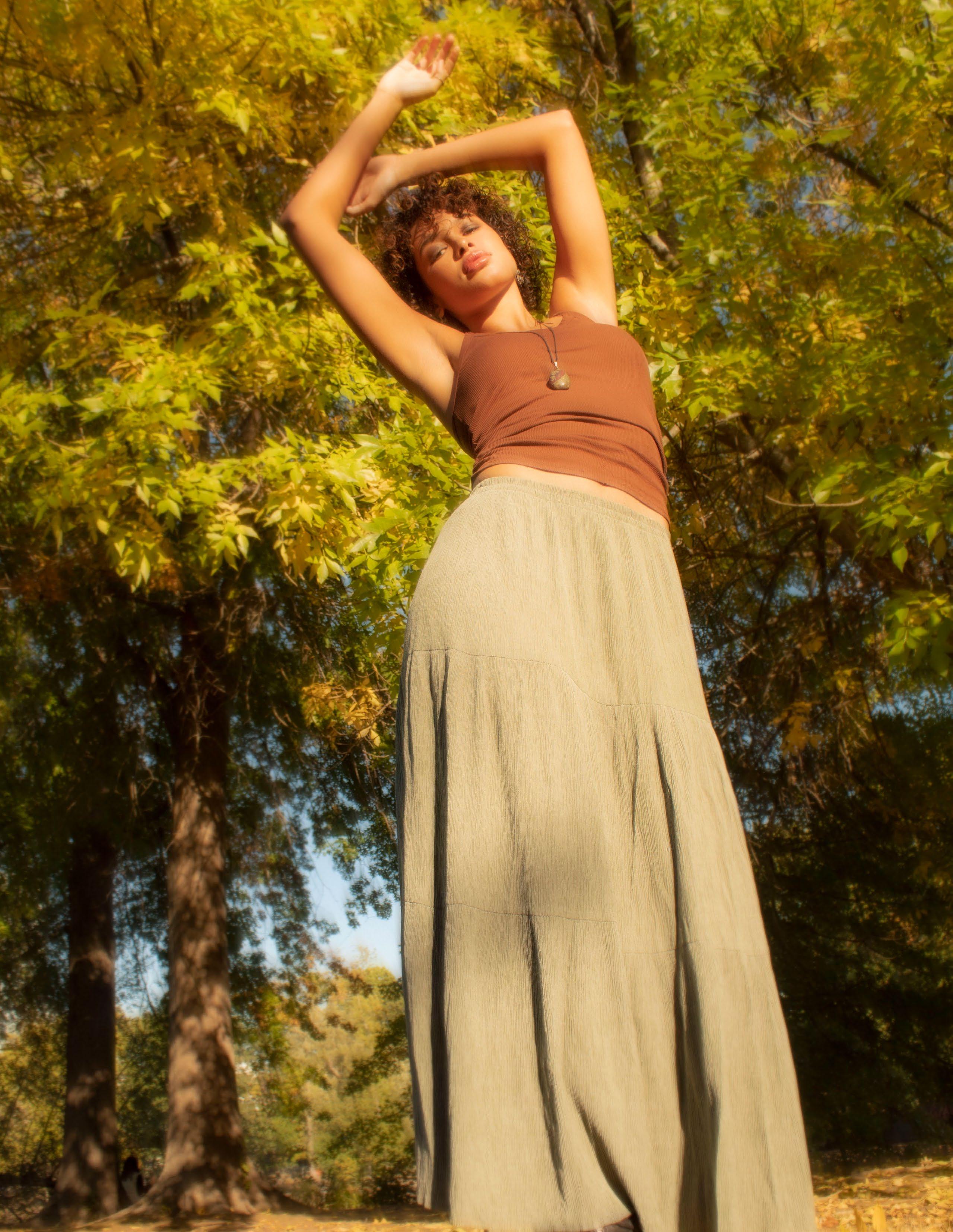
READINGS PROVIDE A SENSE OF DIRECTION FOR THOSE WHO FEEL LOST
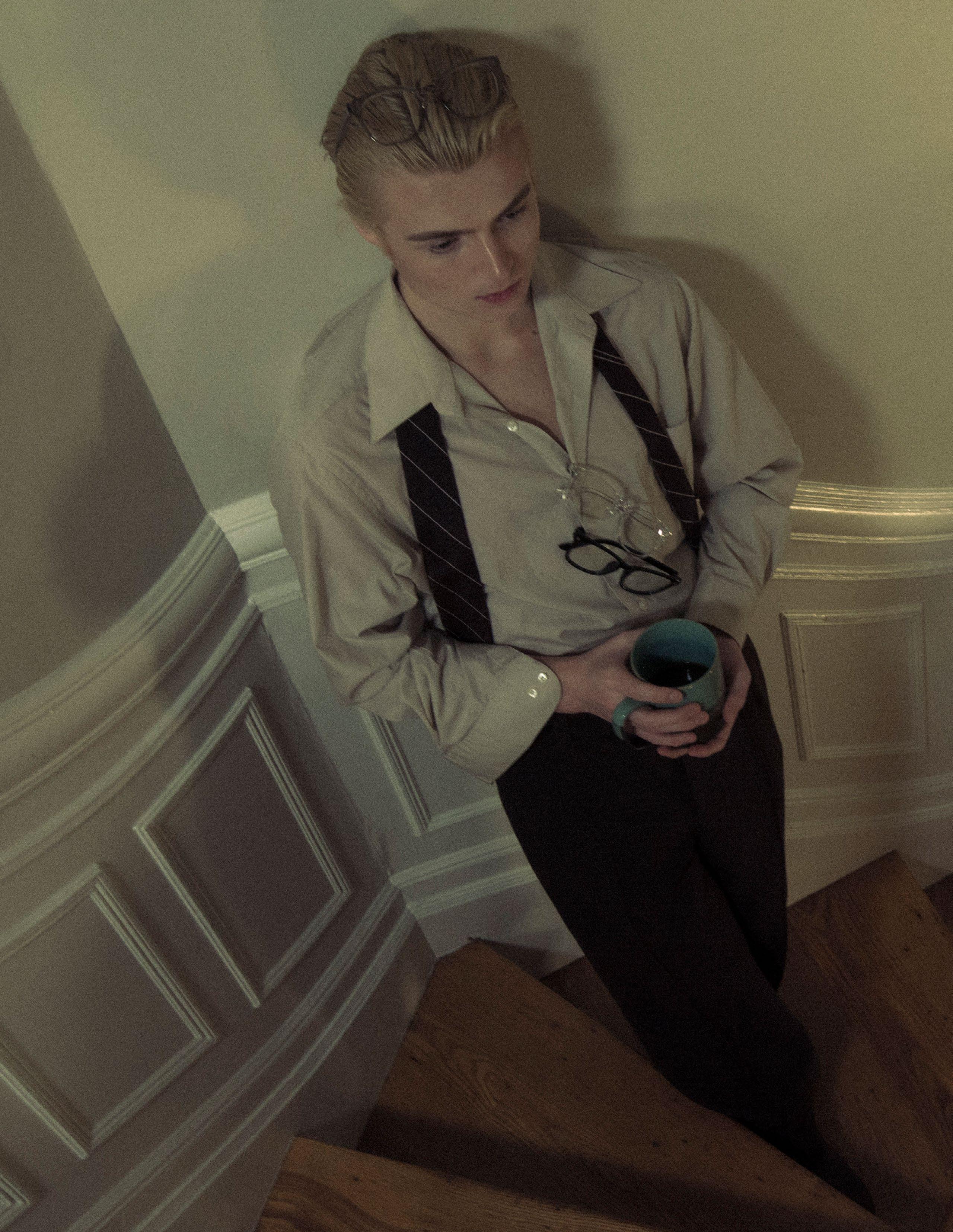
mun
72
dane
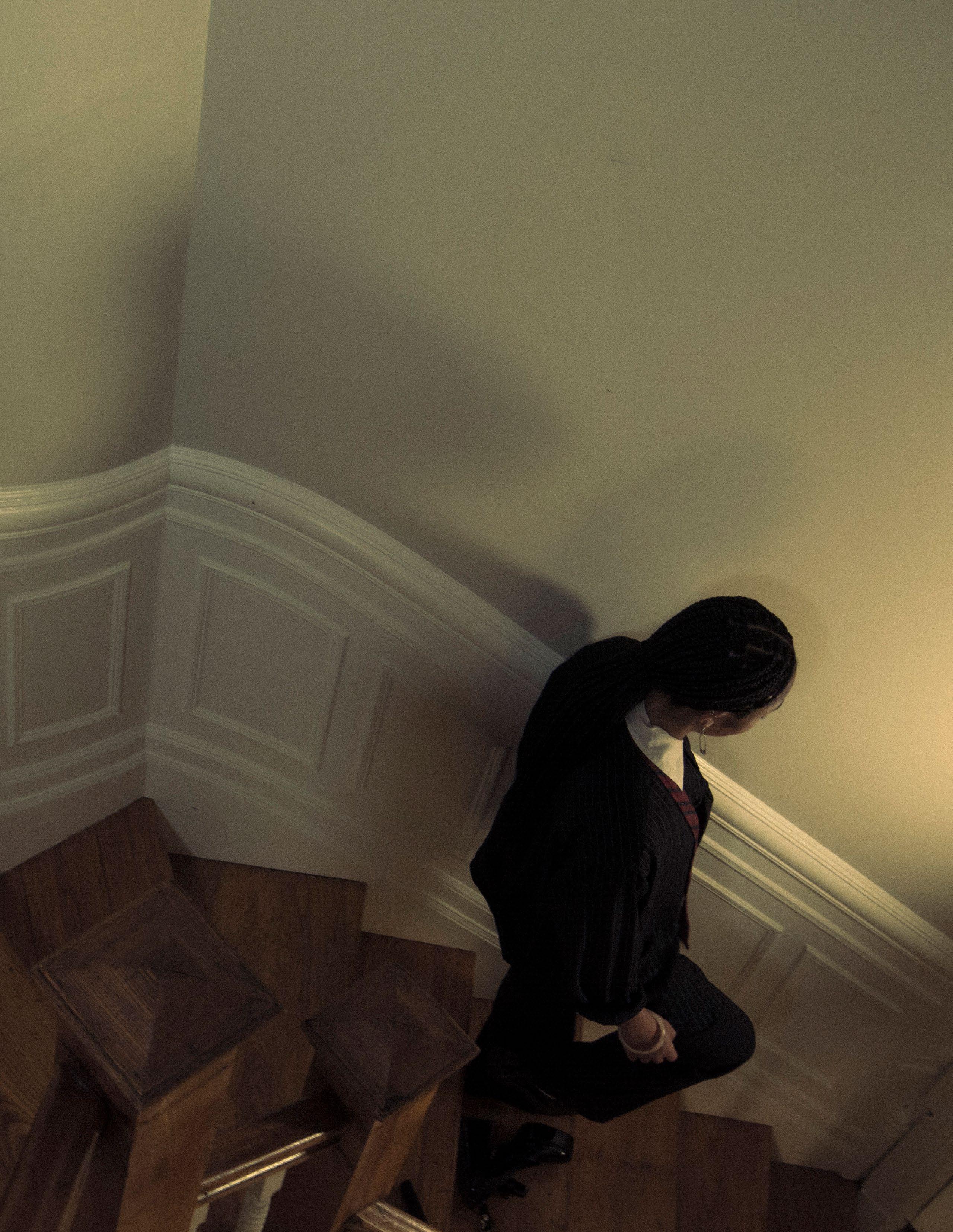
mun dane
creativedirection ABBY FALZONE artdirection RENEE PEARCE design CLAIRE HIGGINS & RENEE PEARCE photography ANGELINA CHAU contributingcreativedirection SASHA LEWIS makeup MELANIE BAREST styling YEANI KWON & SOLOMON CANADA & GIGI GILLEN & WOODY LINDOR & ADRIANA ALVAREZ modeling JENNIFER UYANGA & CHRIS PARKER & CASSIE STANLEY & JACK DEUTSCH & LYNNE KHOURI & KEN YIN


42.34253 N 71.08636 W 74
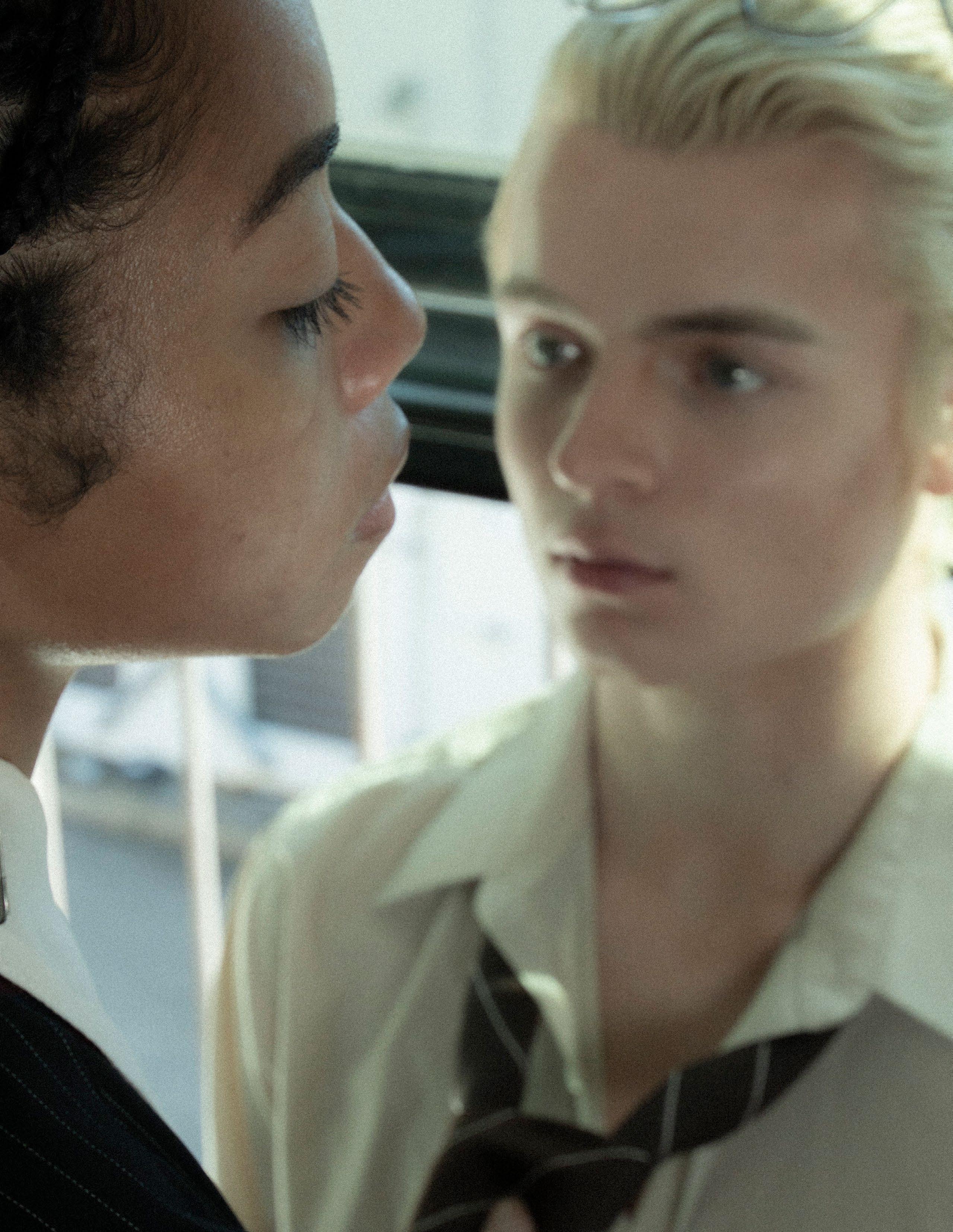

76






10/15/22
9:05AM
CAM 02


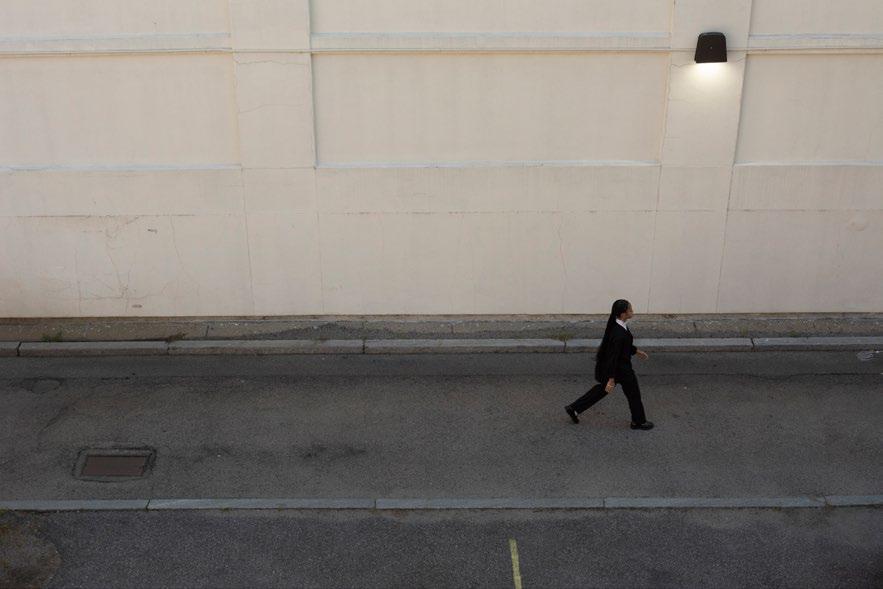



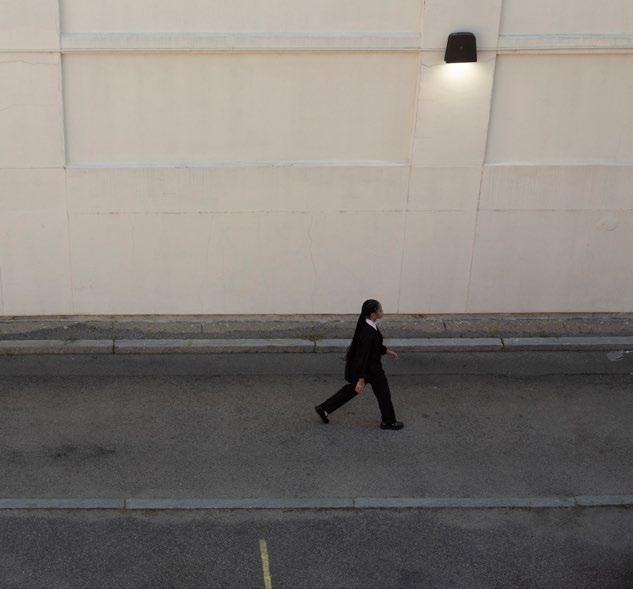








09:06:04 78






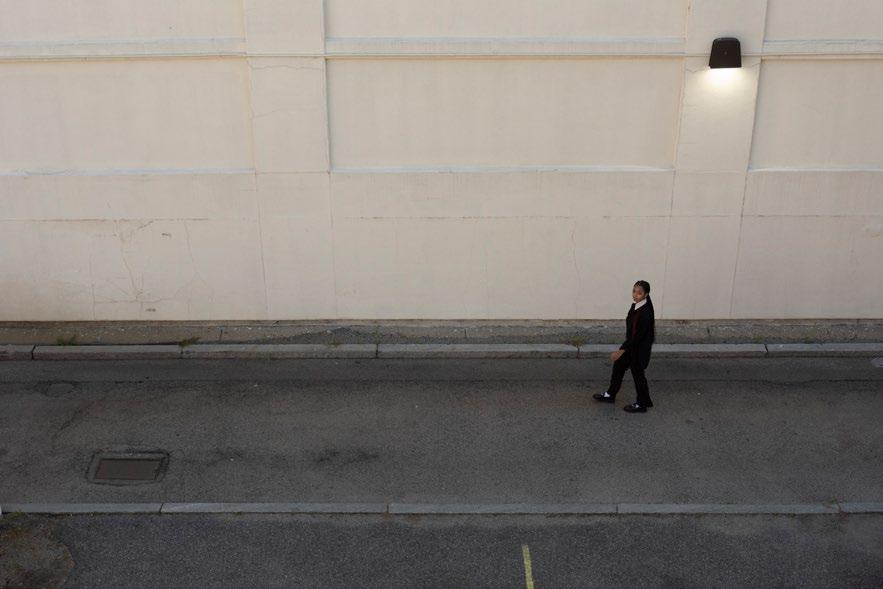
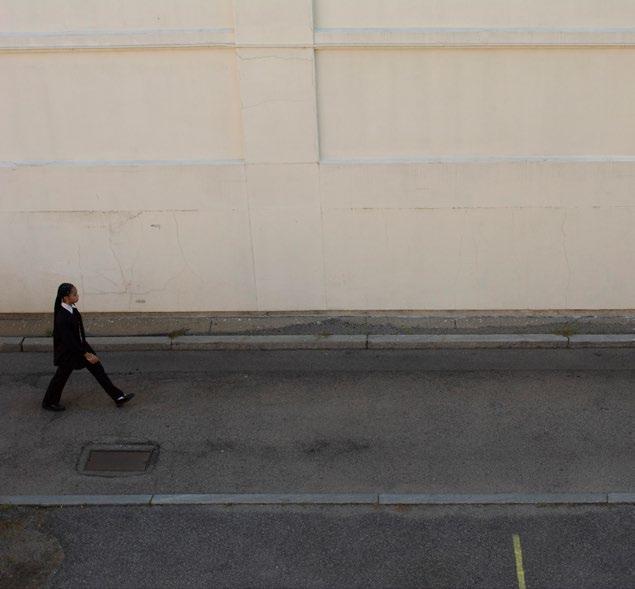







18:45:36


9:30 asdfghjklqwertyuiopzxcvbnm,qwertyuiopasdfg eertgyh" 9:32 “hiashdadhaahdsh haskdhkjsdhd jksahdbe msdcksclkscjn” 9:36 “hiashdadhaahdsh haskdhkjsdhasdf asdf zxcvbnm" 9:42 "sdfghjkl qwertyuisdfgyhjkl; oiuyqawresdfxg" 9:45 "qwertyuhgv cvbnm kjlkjnbgfd hfglhhn rfsgfxkb, ujhvdrd" 9:47 "lkjhgfdw poiuytfdcxvbnjmk "kjghfdxjhgfhsz l.m,ncxdj" 9:49 "asdfghjk erty uhgfv ghjkmvlkhjgashfkdhpowidguwdasukwedgd" 80


9:51 "xcvbgtrfedhjni jkscdasgydw cksjychskcsamndsx" 10:01 “hiashdadh xcvb rtgyhjub vbnjmkjhg ikjh" 9:36 “hiashdadh jsaldhn aslkjdhd iashwdwhq" 9:42 "sdfghjkl qweralskjdj alskjd welej" 10:02 "qwertyuhgv cvblaksjdksjadkljh ajlsk asdjha" 10:04 "lalskdjajsk woieuw ojdsacxj owehwkm" 10:05 "oiuyiuyt 10:08 "kalsdjwueyq dad 10:11 "aospdu jpieuwha akjasjdluy" 10:13 "xcfghikjhb

DAY #2894 CITIZEN #788089049 12/08/22 #16 BEGIN 82
ANOTHER ONE BEGIN AGAIN DAY #2894 CITIZEN #78 ANOTHER ONE BEGIN AGAIN DAY #3208 CITIZEN #788 ANOTHER ONE BEGIN AGAIN BEGIN DAY #3411 DA
I AM NOT A SIN

84
Sunday, 9 a.m.: the bells toll in my small hometown church. Crowds arrive and gather, taking a seat, some speaking Spanish, some speaking English, some speaking both. I sit next to my mother and wait for the pastor. Oblique, beige walls, benches of wood that creak under our weight, stained glass walls that echo the words of the churchgoers, and the inevitably-present cross that stands in the middle of the room. Discomfort? Fear? Anxiety? I wasn’t sure what I felt. But I wasn’t safe.
I never really liked church. I struggled with the idea of praising someone who I couldn’t know existed — and in tandem felt some sort of guilt in that doubt. Yet, here I am, every Sunday. Was it to make my
mother proud? To make myself proud? God proud? To this day, I fail to find the answer. Yet, here I am. Yet, here we all are.

I wasn’t old enough to understand what it meant. I was only 10. But I could see. Small, grim nods. Soft whispers of praise. The small ecstasy of approval for the words, “God loves those who obey, but God shows his anger against all wicked people, and abandonment is all they learn. All they learn, that they turn to abominus, dark and confused worship, worshipping of their shameful desires, sex between each other.” I wasn’t old enough to understand what that meant, but I could see it was wrong. I could feel it was wrong. I was convinced it was wrong.
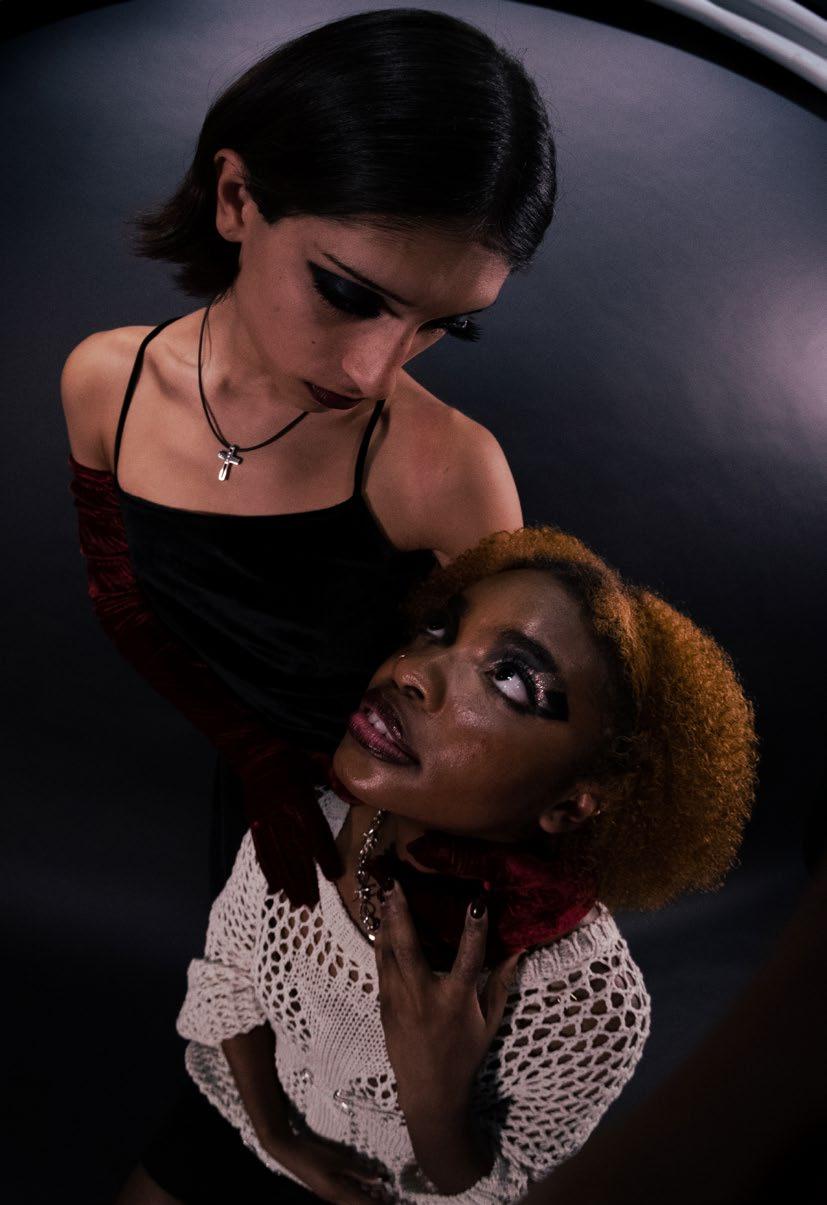 writing ANONYMOUS modeling ELANA LANE & AX BALIONE photography ALEX CHANG design EMLYN GRIFFITHS styling ADRIANA ALVAREZ
makeup MELANIE BAREST
writing ANONYMOUS modeling ELANA LANE & AX BALIONE photography ALEX CHANG design EMLYN GRIFFITHS styling ADRIANA ALVAREZ
makeup MELANIE BAREST
SO LUST BECAME A THREAT. DESIRE BECAME AN INSECURITY. AND QUEERNESS BECAME MY SIN.
So lust became a threat. Desire became an insecurity. And queerness became my sin. A death sentence to someone I could no longer be, someone I was never given a chance to be.

And who was I to be, so as to defy God? God won’t forgive me. The Catholic Church won’t forgive me. My family won’t forgive me. And at one point, I couldn’t forgive myself. So I did the only thing that was reasonable — I hid.
I couldn’t bear to see who I truly was. I couldn’t bear to know what God thought of me. And I simply could not bear the fact that I could disappoint the person that I had always believed would love me
unconditionally. For 18 years I believed in this truth, and I wanted to make ’Him’ proud. I wasn’t queer, I was just confused. God would only love me if I felt that way. If we felt that way. If we fixed our confused daze, he would give us a chance.
First communion, Sunday mass, Confirmation, Everything was all for you.
For 18 years, everything was for you.
I COULDN’T BEAR TO KNOW WHAT GOD THOUGHT OF ME.
86

Kneeling, praying, and praising became a numbing routine. You became my routine. You became me. And that was all I knew.
Eventually, college began, and I was no longer tied to family or religion. Having the freedom to pursue everything and anything suddenly became an unnecessary, threatening objective for me to chase. A chance that all my work of praise would be crucified if I were to disobey him.
I would lose ‘Him.’
And with him, I would lose myself.
And I couldn’t lose myself at the point in my life when I was supposed to be finding myself. People yearned for it. People feared for it.
It’s the fear of not being enough, coupled with the fear of being too much. The same fear of being you.
Except this time it's different, I was queer. But that was all I knew. That is all we know.
We are queer, but what’s next? Who can we talk to? And why does it feel like we are rushing it? Hiding from it?
A trait of we who are, but a deformity of who we don’t want to be. An endless abyss of straight couples, holding hands, getting married and following the praise of God. But for us, it’s just looks, grim nods of disapproval, and harsh whispers of condemnation. A small ecstasy of castigation that tells us we're not enough, that we'll never have the chance to become something. Anything.
And when we do, it’s rushed. We don’t have time. But we don’t want that time. Because when we have strayed from what we practice, we have the chance to know what has been unfamiliar. And we would rather sit in the uncomfortable silence of that unknown than acknowledge everything we missed, everything that was grasped away from us. Everything that was grasped from me.

88
Our childhood, our life. Our dignity and our identity, just to keep yours alive.
And it only took me 19 years to be sure. Not confident, but sure of who I belonged to. To keep our desires separate from yours. To keep our truths separate from your lies. To keep my community separate from your society. I belong to the LGBTQ community. I am queer. We are queer. We are who you suppressed, who you rushed, who we kept hidden away for your glory. And it’s enough. We have always been enough.


90
mad
madhatter fashioning the
In 2021, “Alice in Wonderland” was recognized by Vogue Magazine as one of fashion's most enduring muses. It seems we enjoy leaning into the madness and majesty of costumes as a way to soothe the streak of insanity within ourselves.
Fashion is a silent voice, but it’s also a yelling siren, especially when the end goal is to be both mad and magnificent.
Disney’s 2010 “Alice in Wonderland” movie enlisted Colleen Atwood to design its costumes. Tarrant Hightopp, or The Mad Hatter, was usually always in three-quarter culottes that splayed out midshins, wacky socks, a burgundy blazer, distressed tuxedos, and, of course, a hat. His makeup consisted of red eyeliner, bright green and orange contacts, rouge blush that stood out against a pale white foundation, blue eyeshadow, and red gravitydefying eyebrows and hair. When asked about the balance between the bright hues of the costumes and the period piece tailoring, Atwood remarked,
“The Hatter’s look is other-worldly and magical but still somewhat real in a sense. He is in a different head space at the beginning of our story and his costume goes through a journey of trying to help him find his soul.”
While Hatter’s costume is a highly successful extension of his off-kilter personality, contemporary audiences question if he was truly as mad as he appeared. His fashion choices, while unconventional, seem too stylized and calculated to truly be crazy. He is more inspiring where he should perhaps be disconcerting. Rather than scare us away with the loud hues and patterns, it draws us in with the bright colors and enthralling synergy. The costume is almost alive, with an utterly vibrant personality and eye-catching soul.
Audience members, designers, and fashion personas alike still find inspiration in the liveliness and irony of the costume.
writing EBUBE ONWUSIKA
modeling LUCY CHEN & MILES STEVENSON & BAHVANA SINHA photography JENNA ORY design SYDNEY SINGH styling SOLOMON CANADA makeup CELINE PLAISIR
“Mirror Mirror” (2012), a Snow White retelling directed by Tarsem Singh, is also known for its costume storytelling, as the plot of the film was symbolically reflected in the attire of its characters. Designed by Eiko Ishioka, the costumes were described in Fashionista to be so awe-inspiring that they film themselves. The Queen, played by Julia Roberts, wears a red peacock dress with high shoulders, representing the Queen's intimidating nature and her constant efforts to scare away—or, in the case of Snow White, kill—any competition.
Snow White herself was also outfitted with a memorable costume, particularly in the movie’s final scene. She wears a flamboyant orange and blue dress tied back with a gigantic bow. Ishioka wanted the gown to represent Snow White as a gift to the people who lived in the land after bringing an end to the Evil Queen’s reign. Who would expect entire plot lines to be encoded in peacock dresses and giant bows? The costume designers, that’s who — it’s what they do.
We can more clearly see the effects of such costumes when they are juxtaposed with casual clothes in everyday life. This pattern is particularly prominent in 2004’s “Enchanted,” in which Amy Adams plays the bubbly Giselle, a princess magically transported from the fairytale land of Andalasia to New York City. When Giselle first arrives in New York, it is in nothing less than a humongous wedding gown, complete with puffy sleeves and a million layers of hoop skirts — entirely impractical for the cosmopolitan city. As the movie progresses, Giselle starts wearing increasingly smaller dresses, more conservative prints, and smaller sleeves until she reaches her final outfit: a simple, sleek, solid-color evening gown that ditches the sleeves completely. This final gown stands in stark contrast with her initial wedding dress. Costume designer Mona May never explicitly confirmed that this pattern was intentional, but Giselle’s costume changes are an undeniable reflection of her growth during the movie.

92
Though these outlandish outfits may seem removed from our real lives, the costume changes are familiar elements of reality. Not a lot of us can claim that we have the same style now as we did when we were twelve. As our experiences and thoughts change, so does the way we choose to convey ourselves to the world. It’s the exact same thing with costume design in the film: designers aim to reflect characters’ personalities, growth, and even dreams through what they wear — a strategy that is even more remarkable when they come from imaginary worlds.
Inspired costume design draws audiences into the world of fantasy to enrich our real lives. Those of us who are awake in both the whimsical fantasy and cautious reality of our lives most likely find joy in seeing the most erratic and beautiful of finery come to life on the silver screen.w

AWAKE IN BOTH THE WHIMSICAL FANTASY AND CAUTIOUS REALITY OF OUR LIVES

94
90S ‘HEROIN CHIC’
DISSECTING THE LOOK
“Heroin Chic” is an aesthetic that rose to popularity in the early 90s. The term “Heroin Chic” was born from the style’s appropriation of physical features often associated with heroin addiction, including pale skin, a thin figure, dark undereye circles, and mangled hair. The aesthetic took the fashion industry by storm, from photographers to models to producers, and quickly grew from a trend into a cultural movement encompassing glamor, high adrenaline, and partying.
Heroin Chic likely found its advent with supermodel Gia Carangi in the 80s — the New York Times called her “The Model Who Invented Heroin Chic.” However, it did not truly grow to peak popularity
campaign, and remains the face of the aesthetic to this day.
The glamorization of the aesthetic increased with the eye-catchingly raw works of Davide Sorrenti. The famous New York fashion photographer was infatuated with the look, and most of his art was inspired by it. At the peak of 90s, when many in the industry dabbled in drug usage and drug culture, Sorrenti captured the models in a hauntingly beautiful form — though dressed in high-end
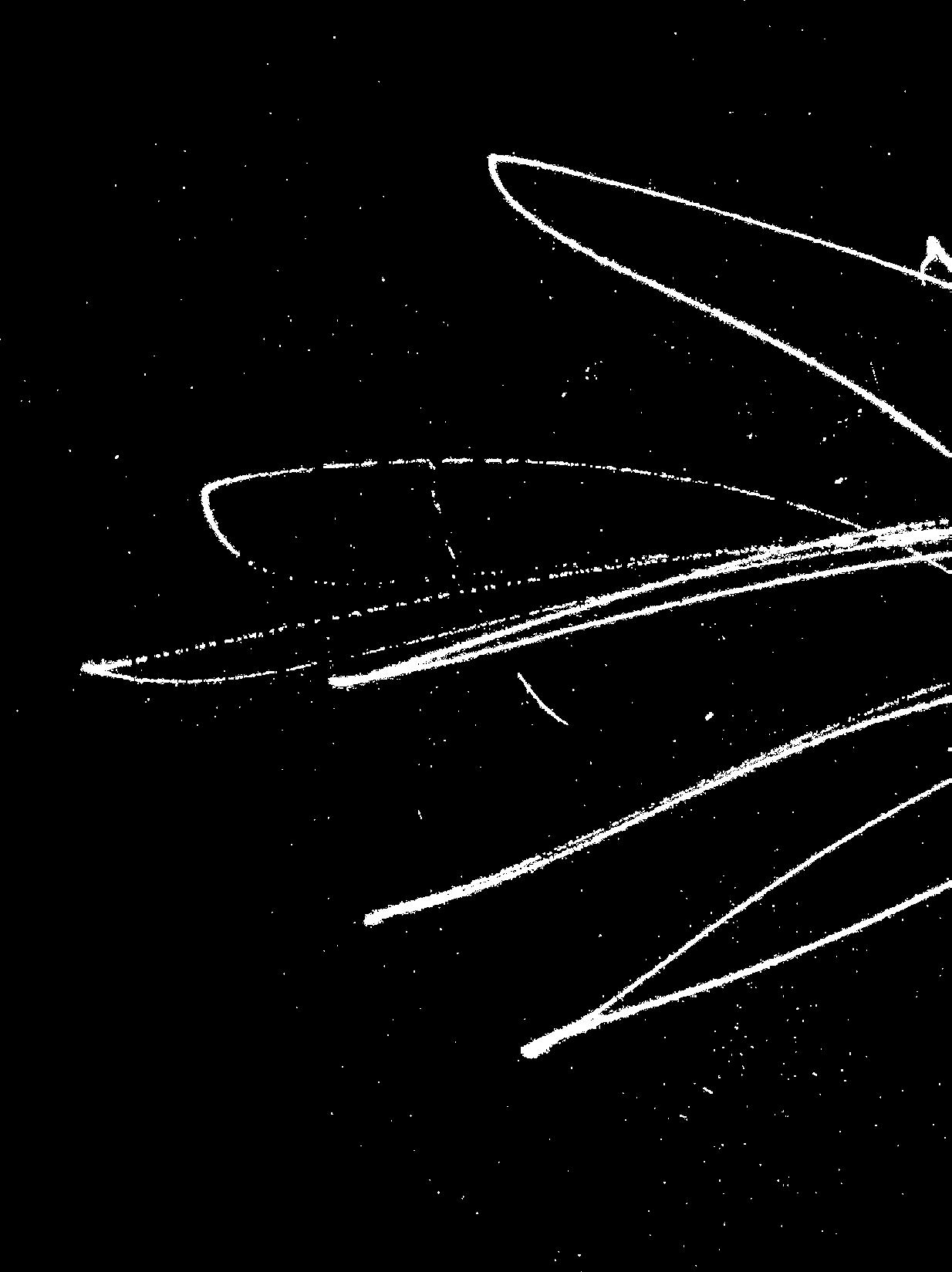 writing VALERIA MARTINEZ modeling RACHEL SOLOMON photography AZRA SCHORR design DAISY TULLER styling YEANI KWON makeup MELANIE BAREST
writing VALERIA MARTINEZ modeling RACHEL SOLOMON photography AZRA SCHORR design DAISY TULLER styling YEANI KWON makeup MELANIE BAREST
clothes, he shot their awkward poses and emotion filled eyes. Editors from fashion’s most influential magazines loved the air of naïveté and fragility that came with the uncomfortable posing. The makeup looks the models were photographed in perpetuated these characteristics; a common one being the grunge look, which consisted of pale red eyeshadow, dark liner, and matte lipstick, giving the look a sense of unease and chaos. However, Sorrenti’s success was short-lived, as he died in 1997 at the age of 20 — at the time of a suspected heroin overdose, which his mother later disproved in a 2019 Vogue article.
Despite passing from kidney failure, Sorrenti’s supposed heroin death led to a turning point from admiration to disgust within the industry towards the normalized drug culture and “Heroin Chic” aesthetic. It was a wake-up call to the consequences of the glamorization of addiction in society, and more specifically in the fashion industry.
As depicted by editorial magazines, beautiful fashion shoots, and red carpets, the fashion industry may seem like a glamorous, exhilarating, and vibrant space. As outsiders, all we see are the pretty photos on social media and entertainment outlets. However, the reality is that it’s an overwhelming, stressful, and high-pressure industry where low pay, high hours, and misogyny are common. In a Glossy survey completed by fashion employees, 87% of respondents said they were overworked. The normalization of worker exploitation in the fashion industry led many to unhealthy coping mechanisms, including but not limited to drug abuse. Its prominence within the industry led supermodels like Naomi Campbell and Kate Moss to become victims of substance addiction.
The “Heroin Chic” look the public saw was very different from what models were actually going through. As is often seen in the fashion and beauty industries, extreme thinness was a hallmark of the
Despite its harmful effects, the “Heroin Chic” aesthetic is still seen as an iconic moment to remember in the fashion and beauty industry. It is a mystery the way it is perceived as satisfying, but why is it so chaotic and destructive, yet exquisite and sophisticated at the same time? Perhaps it is due to the constant messaging from multimillion dollar companies pushing imagery that glamorizes and normalizes unhealthy lifestyles to achieve a certain beauty standard. Perhaps it is our culture’s obsession with feminine frailness and weakness, an ideal that was especially prominent during the 90s when looking starved was the new beautiful, especially in editorial and high fashion contexts. Perhaps it just feeds the beast that is the industry as it craves new ways to control women by turning their bodies into trend cycles.
However, over the past two decades, much progress has been made in shining a light on the toxicity of the fashion industry and its lack of inclusivity. Well-known models like Bella Hadid have started to open up about being overworked, the pressure models have to endure, and the importance of prioritizing mental health. The “Heroin Chic” aesthetic’s negative impact on society has in part pushed people to hold brands more accountable for improving their inclusivity and diversity on runways and in campaigns. The hope is that this trend remains in the past and progress continues in pushing the industry to be focused more on acceptance of all bodies and less on glamorizing dangerous lifestyles.

96
naïveté and fragility


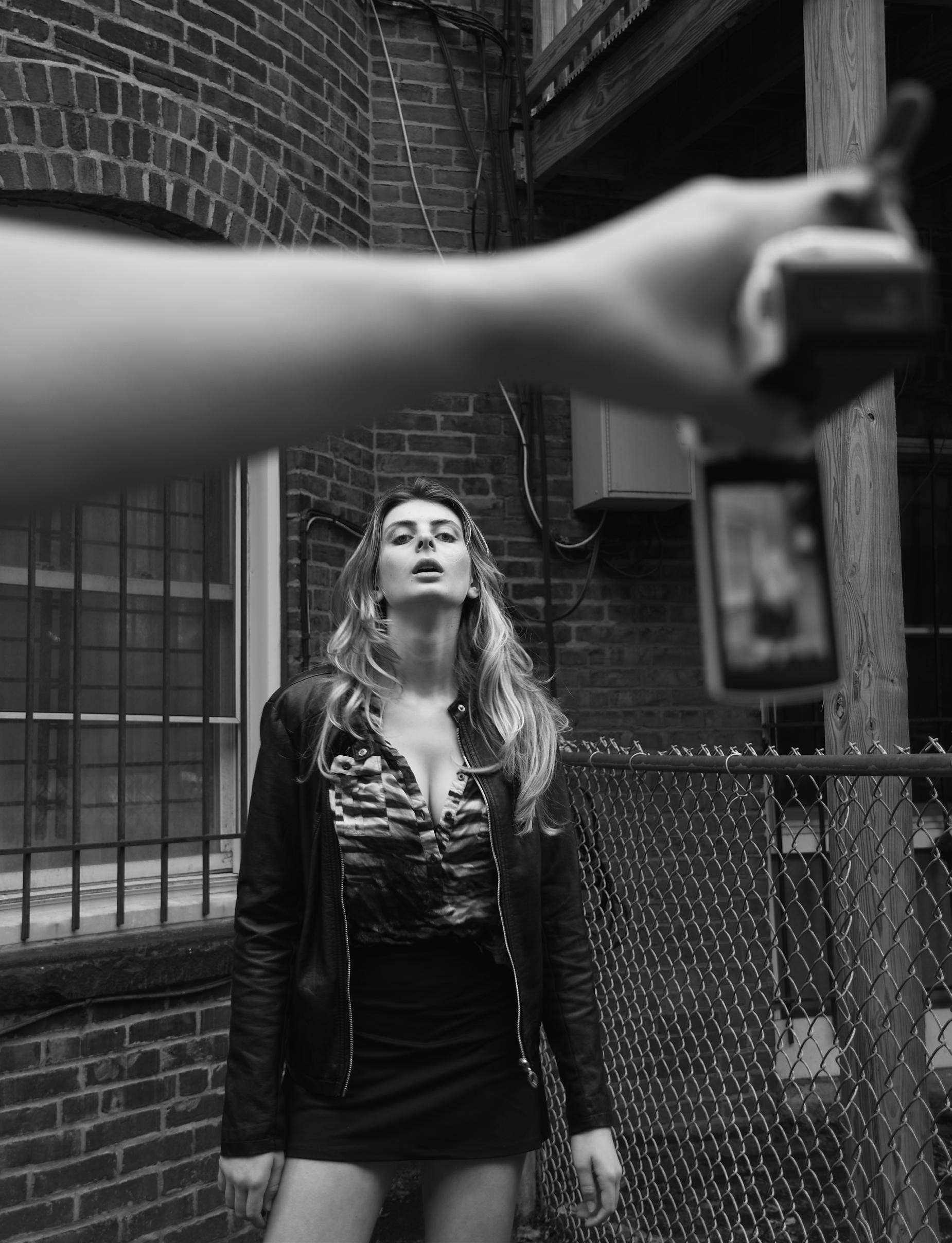
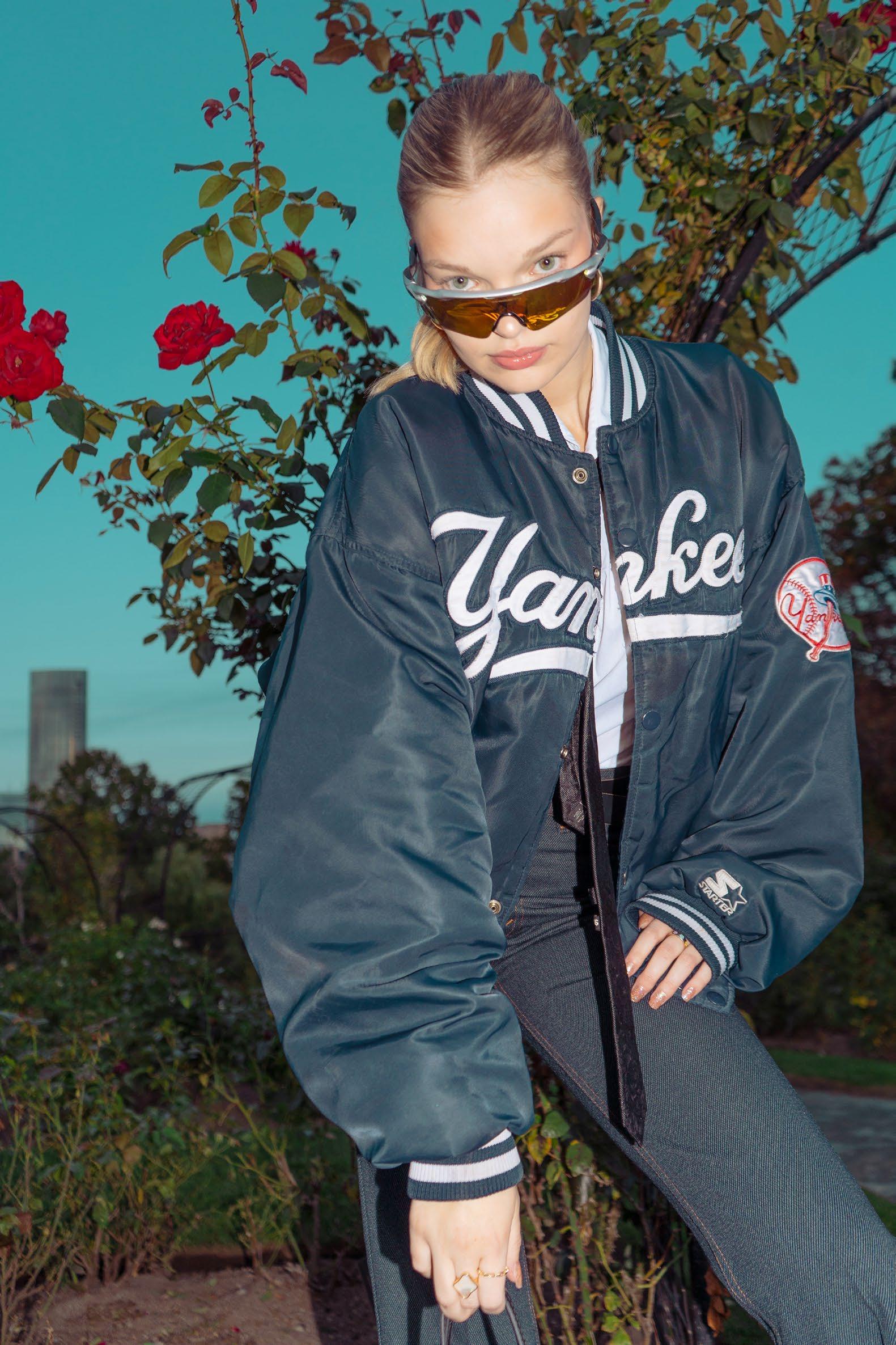


98
CLEAN Not So Clean After All
The so-called it-girl, “clean-girl” aesthetic has been one of the biggest trends on social media in 2022. If you search the keywords on TikTok or Instagram, you’ll be flooded with countless results showcasing what society collectively labels as the wannabe clean girl. The hashtag #cleangirlaesthetic has hundreds of videos on TikTok from creators showcasing what they perceive to be “clean.” With Hailey Bieber, Kendall Jenner, and the Hadid sisters all being examples of the celebrities who embody this look, millions of women aspire to achieve this glowy, minimalistic aesthetic in order to fit the
modern beauty standards reinforced by social media. As you scroll, you will also notice the lack of diversity and range in this aesthetic as your feed is covered with women fitting eurocentric beauty standards. Despite its recent popularity, the only new thing about the clean girl aesthetic is its token title.
Central to the clean girl aesthetic is “natural beauty.” This “effortlessly gorgeous” look is meant to look like one “just got out of the shower,” and revolves around glass skin, lack of under eye bags, freshly-
writing SOOMIN YANG
modeling ANNIKA GEIBEN LYNN & JASON HARRIS & ANDREA GERTRUDIS
& HALIMA DUARTE photography CALI CARDENAS design EMLYN GRIFFITHS styling SOLOMON CANADA makeup CLARISSA ZALLES
washed hair, clean nails, feathered eyebrows, and minimal makeup. It is often presented as easily achievable with minimal steps. Tutorials usually include three to four makeup products and a slicked back ponytail or bun, alluding that the end-goal is to look like you just woke up and you essentially have your life together. Among the most popular videos on Tiktok under the #cleangirl hashtag (with over 12 million views) is a tutorial for the look, introducing the clean girl as the girl “whose skin is always glowing, their lips are always glossed, and they never, ever look like they’re wearing too much makeup.”
Despite its widespread appeal, closer inspection reveals that this aesthetic may not be as “clean” as it seems. The aesthetic’s rise in popularity reinforces that the ideal woman is someone who has white, eurocentric features. Implying this look is “clean” automatically affirms that there is also the opposite end to the spectrum, being the non-clean, or “dirty girl.” As we try to retain beauty standards as they come and go as trends, we begin to notice the same few unattainable characteristics being resurfaced with different titles every few months. In a society that is so strongly influenced by aesthetics, there is a cap to the femininity as cis and trans women are able to explore and express themselves before they are faced with labels given to them by the general mass.
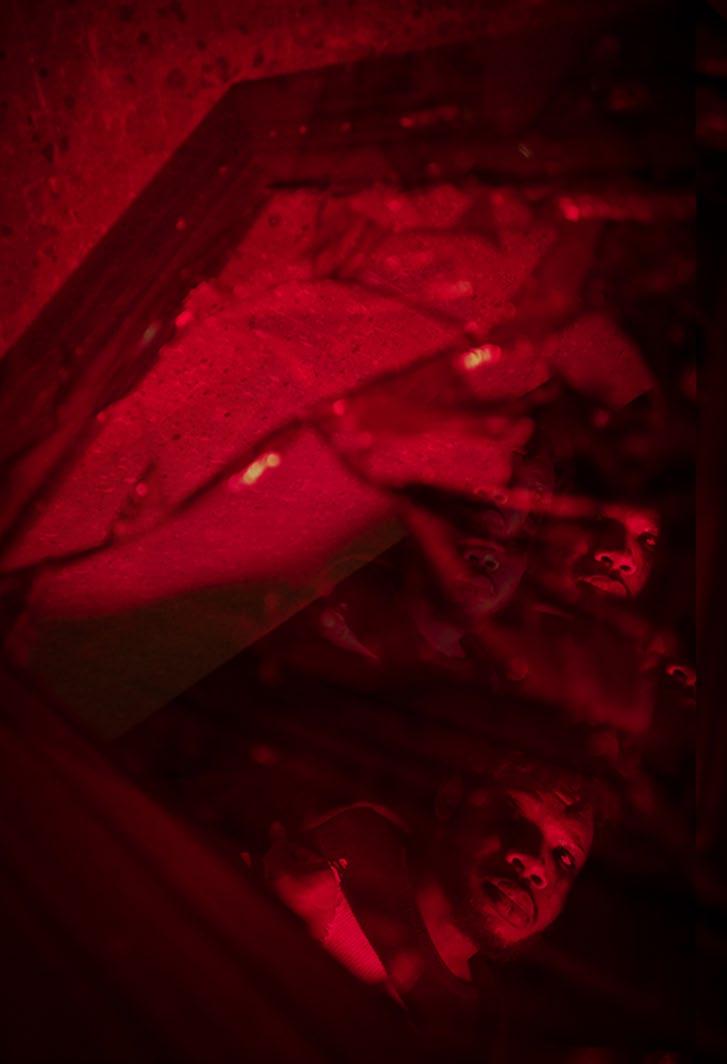
Despite its very foundations originating from women of color, the aesthetic only became the beauty standard when it was adopted by white creators. The slicked-back bun and laid edges originate from Black women and the culture they have built onto the historical elements behind their hair. Where fluffy, feathered eyebrows were demeaned on Latinx women, they are now “brow goals” on white women. Slugging, the generous application of petroleum-based skincare, has been a well-known skin-care routine of Asian countries for centuries before it became popular by white creators on TikTok.
The reality behind the ‘clean-girl’ aesthetic is that it appropriates the practices of its pioneers who created what has now become an oncoming trend. The prototypes of the current “trend” revolves mainly around white influencers and celebrities, and it is notably harder to find “clean-girls” who are from diverse racial or ethnic backgrounds. Popularizing these styles as the “clean-girl” aesthetic without recognizing their origins robs recognition from their rightful creators and negates the history behind the experiences of the makers.
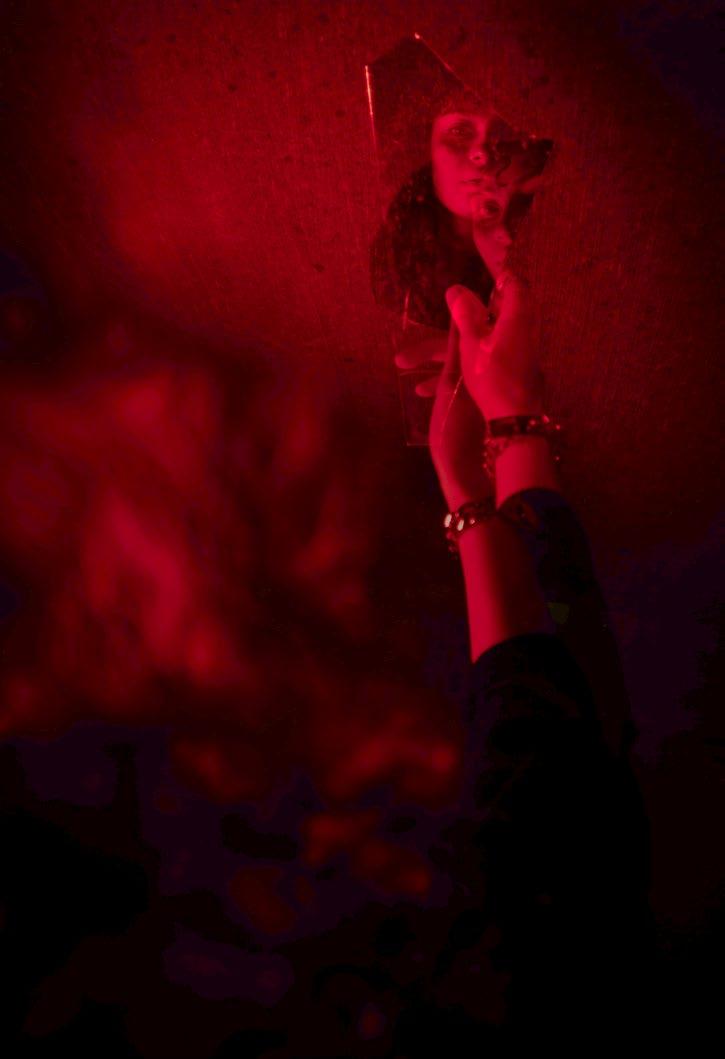
100
Among the aesthetic’s faults is the lack of affordability tied to achieving it. Furthermore, not everyone can afford to be the “clean girl.”
Social media creators and celebrities constantly commercialize and influence users to feed into consumerism as they market products that will supposedly help achieve these desired looks. Keeping up with this aesthetic is pricey and unrealistic, as it implies that not keeping up with a certain lifestyle equates to being dirty.
With this being said, there is nothing inherently wrong with the look – just the label. The “clean-girl” should just be referred to as being a simple and easy makeup look you can use to enhance your natural features. There shouldn’t be an end goal for how clean or put-together you have to look, but it should rather be about enjoying the therapeutic process of getting ready and feeling like the best

version of yourself. Your confidence shouldn’t be based on the amount of makeup you wear or the aesthetic you fit closest to, but rather the comfort you feel within yourself. The beauty standard shouldn’t be a singular mold, but rather something to be tested and explored.
As aesthetics come and go with trends, the history of the defining elements to this look are deeplyrooted in Black, Latinx, and Asian cultures. Its inherently exclusive nature renders it entirely problematic being that it centers whiteness at the core of a “clean” aesthetic. Giving praise to a certain demographic as clean-girls for the looks diverse groups have been wearing for decades takes away from the contribution and credit they deserve.
BEAUTY STANDARD SHOULDN’T BE A SINGULAR MOLD, BUT RATHER SOMETHING TO BE TESTED AND EXPLORED.
THE
victoria's 's dark secret v

102
VICTORIA'S DARK SECRET
victoria's rkc secret
 vwriting ALEX TROTTO modeling HANNAH HARTSOUGH & AIDAN SEVIER & SASHA SHRESTHA photography PEYTON POLLARD design SHARON CHEN makeup SOFIA URRUTIA styling WOODY LINDOR
vwriting ALEX TROTTO modeling HANNAH HARTSOUGH & AIDAN SEVIER & SASHA SHRESTHA photography PEYTON POLLARD design SHARON CHEN makeup SOFIA URRUTIA styling WOODY LINDOR
There I was, an elementary-aged girl, walking through my town’s mall with my mother when suddenly I came across the infamous pink and black temple — Victoria’s Secret. I gazed into the store as I slowly walked by since I knew that I could never actually go in. Victoria’s Secret was a store only for women. Some say that a girl officially becomes a woman when she first begins menstruating, but my younger self would argue that it’s when you felt comfortable enough to walk into a Victoria’s Secret.
I truly believed that a simple retail store could be a cornerstone of womanhood.
I wasn’t the only one who thought this. For the majority of the mid-2000s and 2010s, our society was entranced with Victoria's Secret’s beauty fantasy and idealized depiction of womanhood. Through their commercials, advertisements, and vastly popular annual fashion shows, they created an illusion of what a “real woman” should look like. In 2022, many people look back at this so-called beauty fantasy and wonder how exactly we bought into this incredibly sexist and unattainable image of women and beauty.
For a name like Victoria’s Secret, one may assume that it was founded by a mysterious woman named Victoria (or at least that’s what I thought when I was eight). She was a myth, pure fiction. In fact, the company was founded by a white man from Connecticut named Roy Raymond in 1977.
However, Victoria’s Secret didn't gain popularity until the 90s and the early 2000s. The company took advantage of a new wave of feminism during the turn of the century to sell its products. In the late 90s, a sexual revolution arose revolving around the self-objectification of women and the explosion of “raunch culture.” Women were encouraged to dress and behave scandalously as a form of sexual freedom and self-liberation. Victoria’s Secret jumped on this bandwagon. The company marketed its products around the idea that women should wear lingerie for themselves, to make themselves feel sexy — not for men or the male gaze. In an interview with author Susan Faludi for her 1991 book on anti-feminism, Raymond claimed that a woman should be buying “sexy lingerie to feel good about herself, and the effect it had on men was secondary.”
The claim that uncomfortable and restricting lingerie was made for the sole comfort and pleasure of women was bizarre. Nevertheless, women bought the sales pitch, as it was perfectly aligned with this new era of female promiscuity. This concept persuaded women to objectify themselves for their own gratification in a way that coincidentally aligned with the male gaze. They were able to confine women’s sexual exploration to the realm of male fantasy.
As the retail store began to take over the country, they decided to host an annual Victoria’s Secret fashion show, beginning in 1995. Archival footage from these runways shows a predominantly male audience as well as misogynistic commentary. During the 2001 Victoria’s Secret show, host
104
WOMEN HAD TO SUFFER TO BE DESIRABLE AND ATTRACTIVE.



106
THEY WERE ABLE TO CONFINE
Rupert Everett was heard saying “security is tight, and so are the girls.” On top of that, the models, famously coined “Angels,” featured in the show were unrealistically lean. In an interview with the Hollywood Reporter, former Victoria’s Secret Angel Adriana Lima admitted to cutting out solid food nine days before the show and not drinking water 12 hours before walking the runway. These models were portraying a beauty standard that was incredibly unhealthy and unattainable for the everyday woman — the brand’s supposed primary demographic.
Fantasy is defined as the activity of imagining things that are impossible or improbable. With that in mind, Victoria’s Secret had created quite the fantasy. The average woman doesn’t look like a Victoria’s Secret Angel, and the brand knew that. They spent the majority of the 2000s and 2010s conveying the idea that women had to suffer to be desirable and attractive. In order to be the perfect woman, they were expected to eat like bunnies and overwork themselves at the gym.
Thankfully, the brand has evolved with society and diversified its image. In 2021, Victoria’s Secret announced that they would get rid of their Angels and replace them with a seven-woman group called the VS Collective. This group is composed of diverse women who are committed to changing the image of what a “real woman” is or looks like.
Members of this collective include United States soccer star Megan Rapinoe and plus-size model Paloma Elsesser. It appeared that the brand may finally be promoting realistic body types and actually encouraging female empowerment. The company’s new chief executive John Mehas told The New York Times, “When the world was changing, we were too slow to respond. We needed to stop being about what men want and to be about what women want.”
This new campaign seemed to come very late for the brand compared to other companies, and because of this, many people questioned the sincerity of the rebrand. It seemed as though Victoria’s Secret was forced to evolve its image to adhere to progressive and modern ideals in order to stay in business. In 2018, The Guardian reported that Victoria’s Secret’s stocks fell 40%as more progressive and inclusive brands, such as singer Rihanna’s lingerie company Savage X Fenty, entered the industry. Victoria’s Secret knew that in order to stay relevant, they had to take a page out of these other brands’ books.
At the end of the day, it’s refreshing to see companies like Victoria’s Secret finally diversifying their brand, but that doesn’t mean that this wasn’t a disingenuous response. Despite including diverse female body types and ethnicities in their new branding, Victoria’s Secret is still trying to convince women that they need to buy fancy and sexy lingerie to fully connect with their femininity. Not to mention that the women featured in the new VS Collective are women who still fit the beauty standard. For instance, Megan Rapinoe is a professional soccer player who has a very lean and thin build. Another member, Priyanka Chopra, is a former Miss World pageant winner. Although these women have more realistic and attainable looks, they still exceed the presentation standards of the everyday woman. Although the departure of the Angels dissolved the original fantasy, the sincerity of its newfound voice is yet to be determined.

108
the
nihilist generation generation nihilist
have taken internet culture by storm. Much of the content that Gen-Z publishes on the internet has nihilistic and absurdist themes, true to the extended belief that one’s actions and emotions are also meaningless.
Nihilism is the belief that life is devoid of meaning and nothing matters; the systems that people subscribe to — religion, politics, economics, and identities — are all hollow constructs. Dating back to the Skeptic era and the anarchist revolutionary movements in Russia from 1860-1917, nihilism has consistently been associated with rebellion. Friedrich Nietzsche famously characterized the movement with themes of moral, epistemological, and cosmic failures, which have inspired artists, social critics, and philosophers since the beginning of time. Nietzsche predicted that nihilism’s “caustic strength'' would expose society’s beliefs and truths as Western mythology, along with many other facets of postmodern life. Though his recognition was posthumous, his relevance today resurfaces with the birth of a new generation.
Generation Z, those born between 1997 and 2012, is perhaps best characterized by their ceaseless grappling with climate disaster, economic peril, humanitarian crises, and pandemic fallout. Historic events occur with such frequency that many have become desensitized to the headlines and horrors that bleed on the front page. All of this begs the question: does any of it even matter?
With this in mind, it’s no surprise that Generation Z has shown an interest in these ideas of existential nihilism. Extreme skepticism and relativism, along with the 20th century belief that life is meaningless,
Esteemed American philosopher Hubert Dreyfus critiqued this nihilistic prevalence of the internet in modern life, writing, “as our lives become more and more desituated and detached, our capacity for committed action is undermined. We lose the ability to distinguish between the trivial and the important. And the multiplicity of causes and possibilities for engagement either paralyzes us or makes our decisions appear to be arbitrary choices.”
During the COVID-19 pandemic, struck by nearuniversal feelings of hopelessness and loneliness, many turned toward ideas of nihilism. The Biden administration embodied a detached sense of inevitability in their messaging, with White House Press Secretary Karine Jean-Pierre’s remark, “almost everyone is going to get COVID,” during Biden’s infection. As the philosophy garnered more and more public attention, nihilistic communities grew. In January 2019, before the onset of the pandemic, the subreddit “r/nihilism” had just 31,000 members; by September 2022, it fostered over 120,000.
IS LIFE MEANINGLESS?
writing LAUREN VIOLETTE modeling ANDREW BARNETT photography LAUREN VIOLETTE design SHARON CHEN styling SOLOMON CANADA
Nietzsche’s belief that nihilism would have a pervasive effect on future centuries' culture has been shown in the frequency of intense negative feelings such as anger, anxiety, and gloom that color much of modern-day life. Though Nietzsche is often regarded as a symbol of the adverse effects of nihilism, he himself believed that through great struggle and societal reckoning, humanity could rise above nihilism. He believed that if individuals could put aside all that people consider to be true, perhaps they could find a new course for mankind, separate from the institutions that lead to nihilistic beliefs.
Generation Z’s resulting action — or inaction — is thus a point of interest in the spheres of activism, social change, identity, and mental health. The result is a dichotomy between those who feel a sense of freedom from nihilistic beliefs and those who feel constrained by them.
The Harvard Crimson identifies two groups of nihilists: “passive nihilists” and “active nihilists.”
Passive nihilists are “individuals who, when faced with the realization that existence has no inherent meaning, can fall into a deep depression as a result.” Active nihilists, on the other hand, are individuals who, when confronted with the lack of meaning in the universe, strive to find their own.
Some might place these groups within absurdism, a nihilist subcategory which takes a greater focus on humanity’s theoretical conclusions after identifying life is without a meaning that humans can comprehend.
Wendy Syfret, author of “The Sunny Nihilist” and self-proclaimed active nihilist, gained popularity in 2021 for her upbeat and digestible approach to nihilism. She advocates that the perspective can “provide a balm for modern hyper-individualism and an obsession with finding meaning in everything, from our jobs to our skincare routine.”
This interpretation of nihilism is an up-and-coming phenomenon amongst today’s youth; an emerging trend to “romanticize your life” has swept TikTok, with over 35.9 million views under the namesake hashtag. In her own words for The Guardian, Syfret identified that “while I may feel dwarfed by the scope of endless and apathetic time… ifnothing matters long term, my focus shifts to this moment.”
Rather than surrendering to nihilism, utilizing portions of nihilistic concepts has become a popular approach to fostering healthier perspectives.
With the increasing relevance of nihilistic ideals, Gen-Z is redefining and repurposing nihilism to grapple with the existentialism that naturally results from an upbringing in a tumultuous world. Generation Z is largely considered the nihilist generation, yet as a whole, many stray from the confines of passive nihilism and utilize the feelings of insignificance as motivation to live freely and unabashedly, making a difference in their lives and communities.
hopeless
110
DOES ANY OF IT EVEN MATTER?
hopeless hopelesshopeless hopeless hopelesshopeless
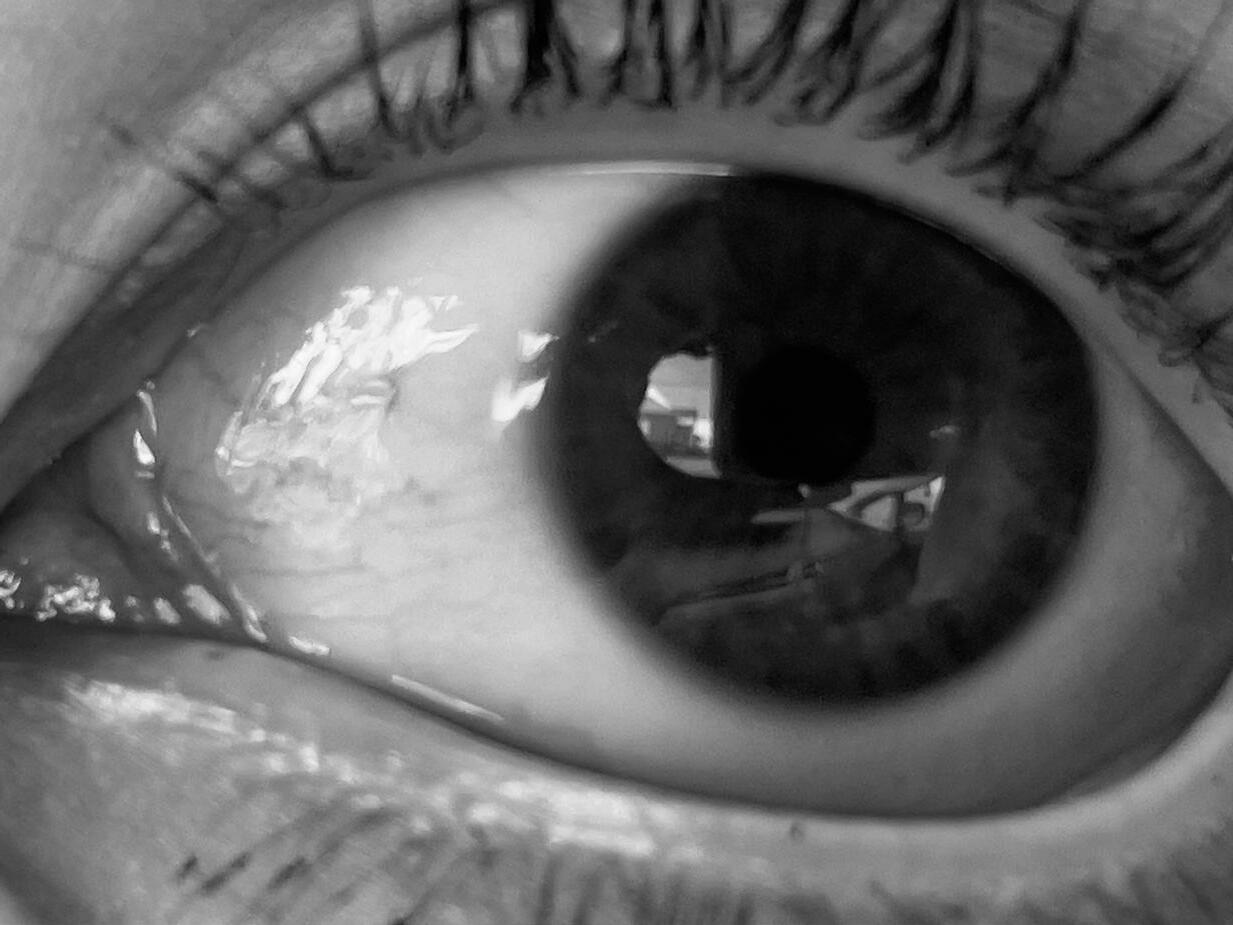
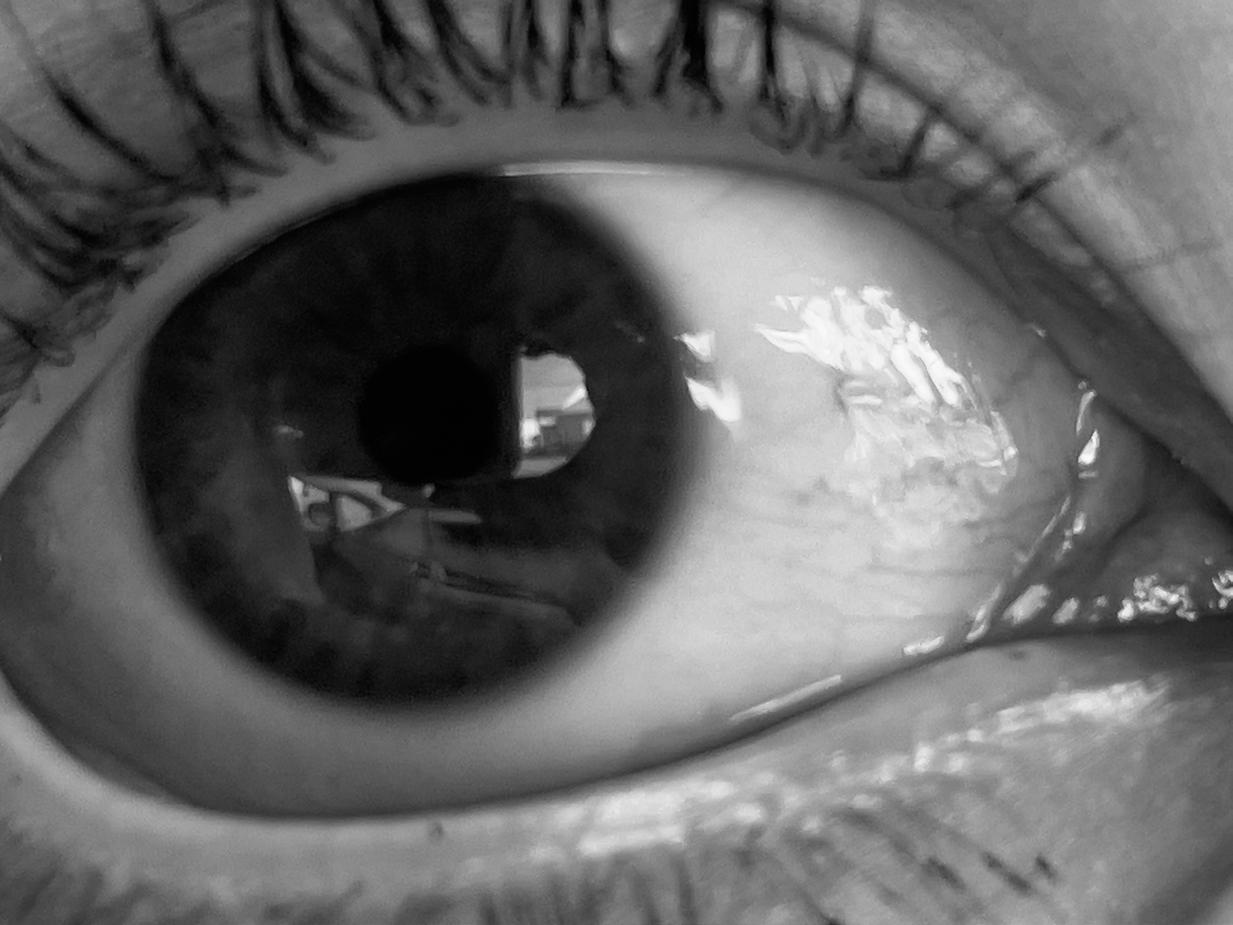
DREAMS

112
DREAMS
FANTASY OR REALITY

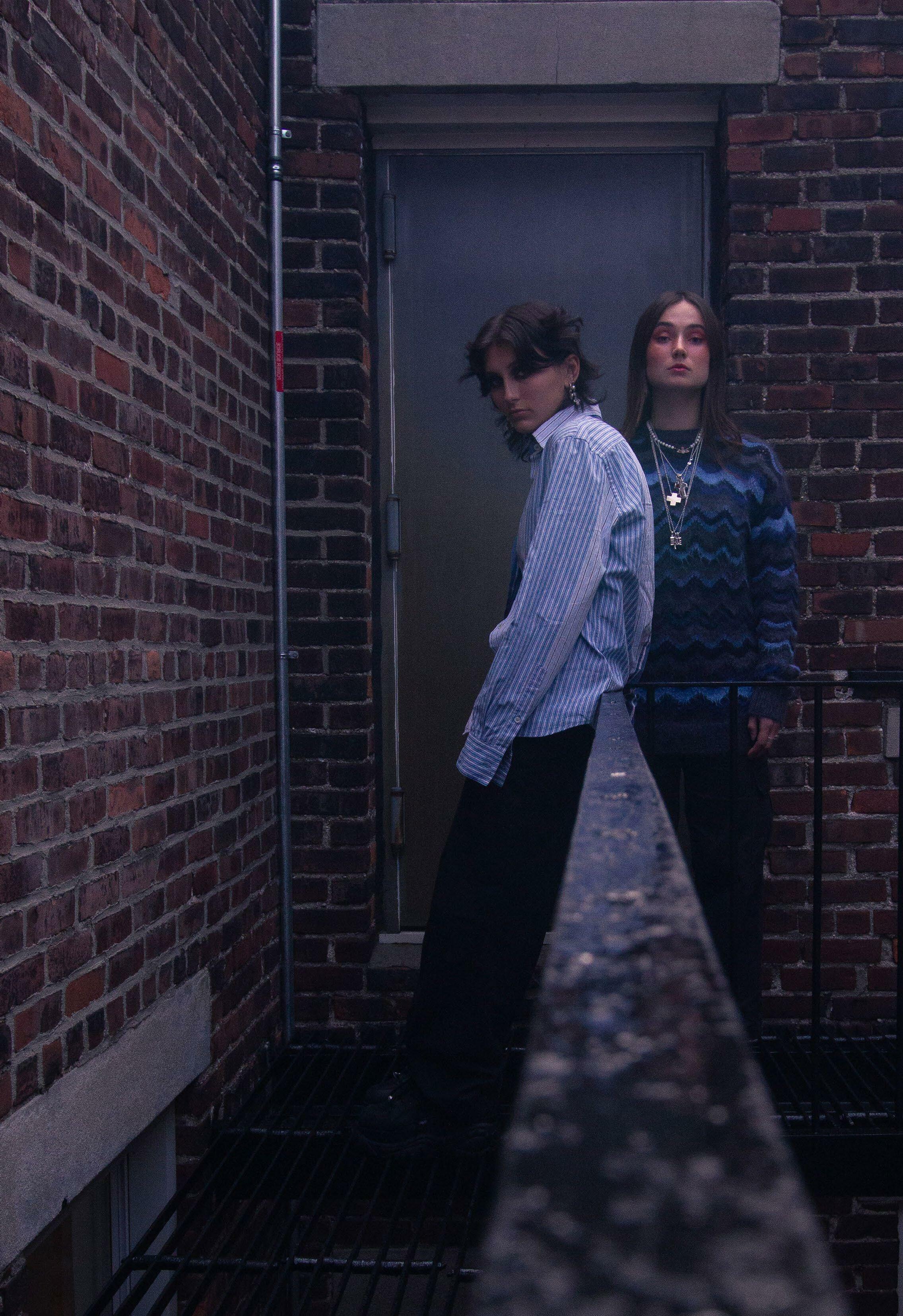 writing LOGAN ROBERTS modeling LUNA BRUSS & AMELIA BALL photography ISABELLA POZZI design SOPHIE FIKS makeup SOFIA URRUTIA styling SOLOMON CANADA
writing LOGAN ROBERTS modeling LUNA BRUSS & AMELIA BALL photography ISABELLA POZZI design SOPHIE FIKS makeup SOFIA URRUTIA styling SOLOMON CANADA
The interpretation of dreams has been studied for centuries. Why, as humans, do we even dream? What purpose do dreams serve? Our dreams are often bizarre — it’s hard to imagine a dream of being stuck in a floating clownhouse or chased by a gigantic goldfish having any real-life applications. However, the fantastical stories that play out in our psyche every night can actually tell us a lot about ourselves.
Our dreams occur within the subconscious, which processes our memories from the day and amalgamates them into a series of jumbled, seemingly nonsensical storylines. Think of the subconscious mind as a hard drive of stored information, containing everything we have ever experienced. It judges, reacts, and interprets situations based on past experiences. Being conscious of behavior is one thing, but understanding the drives behind those behaviors is another. Thus, understanding the subconscious is integral to self-awareness — and the key to our subconscious lies within our dreams.
Many have debated the role of the subconscious in dreams. Carl Jung, an influential psychologist, viewed dreams as a “bridge” to the psyche and the subconscious mind. Dreaming is where consciousness blurs, and our waking senses of logic and rationale are shut off.
For centuries now, psychologists have believed that the subconscious sends messages during sleep — especially during REM, where dreaming occurs. In this REM state, although technically asleep, our brain is still active. Our brain waves are just as rapid during REM as they are when we’re conscious, but our senses of logic and rationale are not employed to the same extent. As a result, our dreams can get a bit crazy — but they hold valuable messages at their core.

Sigmund Freud, another prominent psychologist, believed that dreams were a way for the subconscious mind to express innate desires and fears, which ultimately guide our conscious actions. To better understand and control our actions, we can look to our dreams and the insight they provide.
While dreams can be mundane and easily forgotten, unpacking the more vivid fantasies can be particularly useful. Dreams are abstract — akin to art, they can be interpreted differently. Ultimately, the only person who can genuinely reflect upon and understand those dreams is oneself.
By looking at repeating dreams or the strong emotions that our dreams invoke, we can engage in deep self-reflection. Understanding fears, desires, traumas, habits, and values is essential to selfawareness, which, in turn, is essential to growth.
114
FANTASTICAL STORIES THAT PLAY OUT IN OUR PSYCHE...
Dreams point to our subconscious, which reveal the focal points of our attention and the mood of our psyche. For example, if someone fears stepping out of their comfort zone and meeting new people, a favorable dream may illustrate a situation in which they found the confidence to meet new people. An interpretation of this dream may motivate the person to confront that fear, as the dream reinforced that they can be successful.
Take a zombie apocalypse for example. This could reflect that one’s inner world or subconscious feels a lack of control, or is overwhelmed in a present situation. If dreams are constantly switching between various obscure situations, this may reflect a scattered mental state and the body’s need to regroup. The overall tone of one’s dreams holds a mirror to their current inner workings.
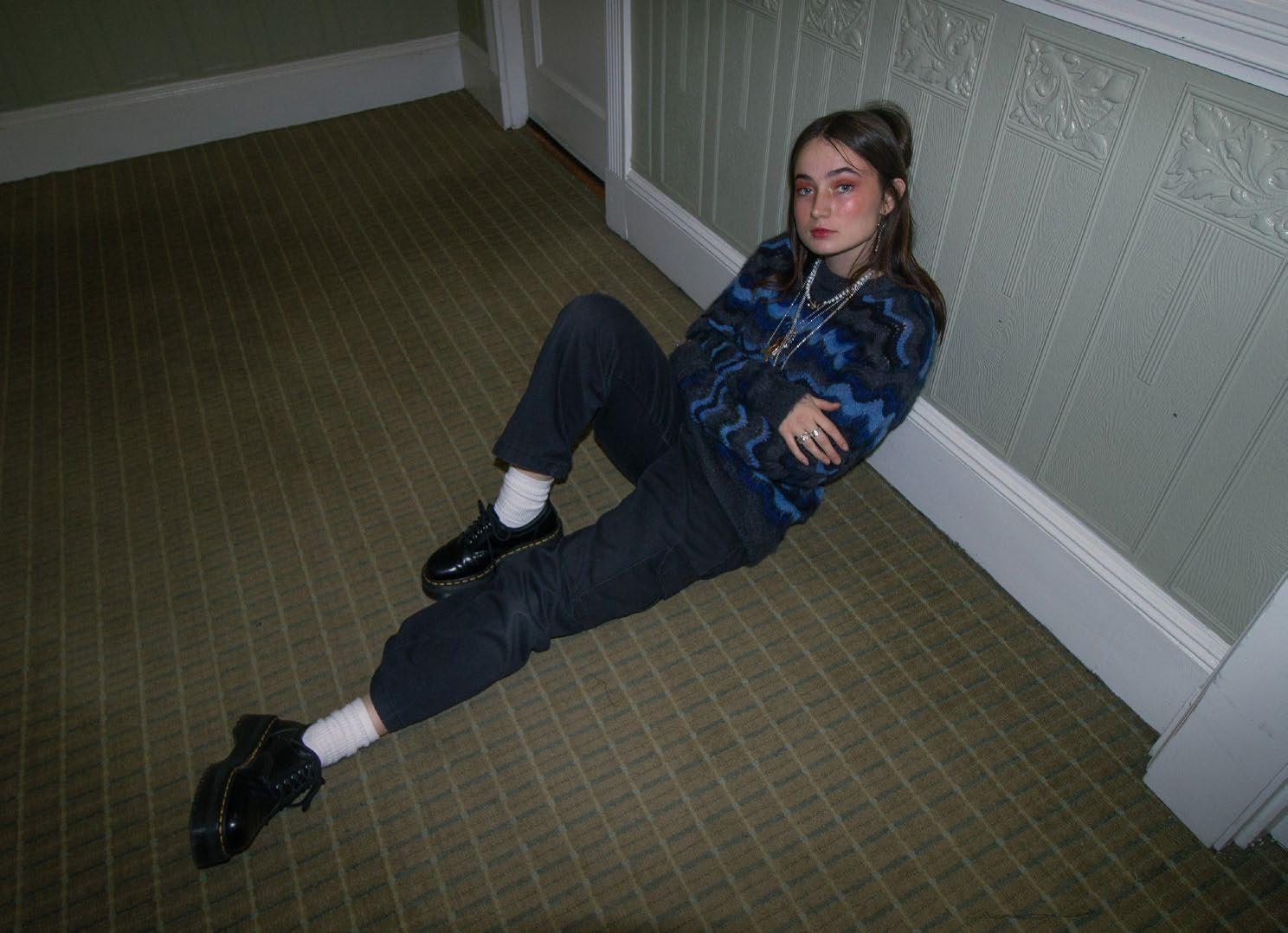
Through dreaming, the psyche can also learn to process different emotions so that the body and mind aren’t as overwhelmed in a waking state. The emotional regulation dream theory explains how your body and brain will label something as traumatic, and the REM phase of sleep will then help the body regulate the response to that event. In this sense, dreams can be interpreted as a survival mechanism. For example, people suffering from PTSD have symptoms that regularly appear as nightmares, which is a way of processing and building resilience to daily triggers. As mental health worsens, dreams become more violent and vivid in correlation. Identifying emotions through dreams can help get to the root of any fears or inner turmoil, which can help guide someone on the path to healing.
To remember one’s dreams and subsequently leverage the lessons they teach, logging has proven to be effective. Journaling in the morning about dreams can even lead to lucid dreaming — the ability to consciously control these events.
Actively writing your experience down in the morning helps strengthen future recall of dreams. Furthermore, this activity can increase awareness of repeating patterns and uncover more profound messages within your dreams.
Instead of wondering why things are happening to us in our dreams, we can think about what they are teaching us. With that mindset, we can take advantage of dreams and view them as an open resource to heal the mind, body, and soul.
...TELL US A LOT ABOUT OURSELVES
couture from the dark.



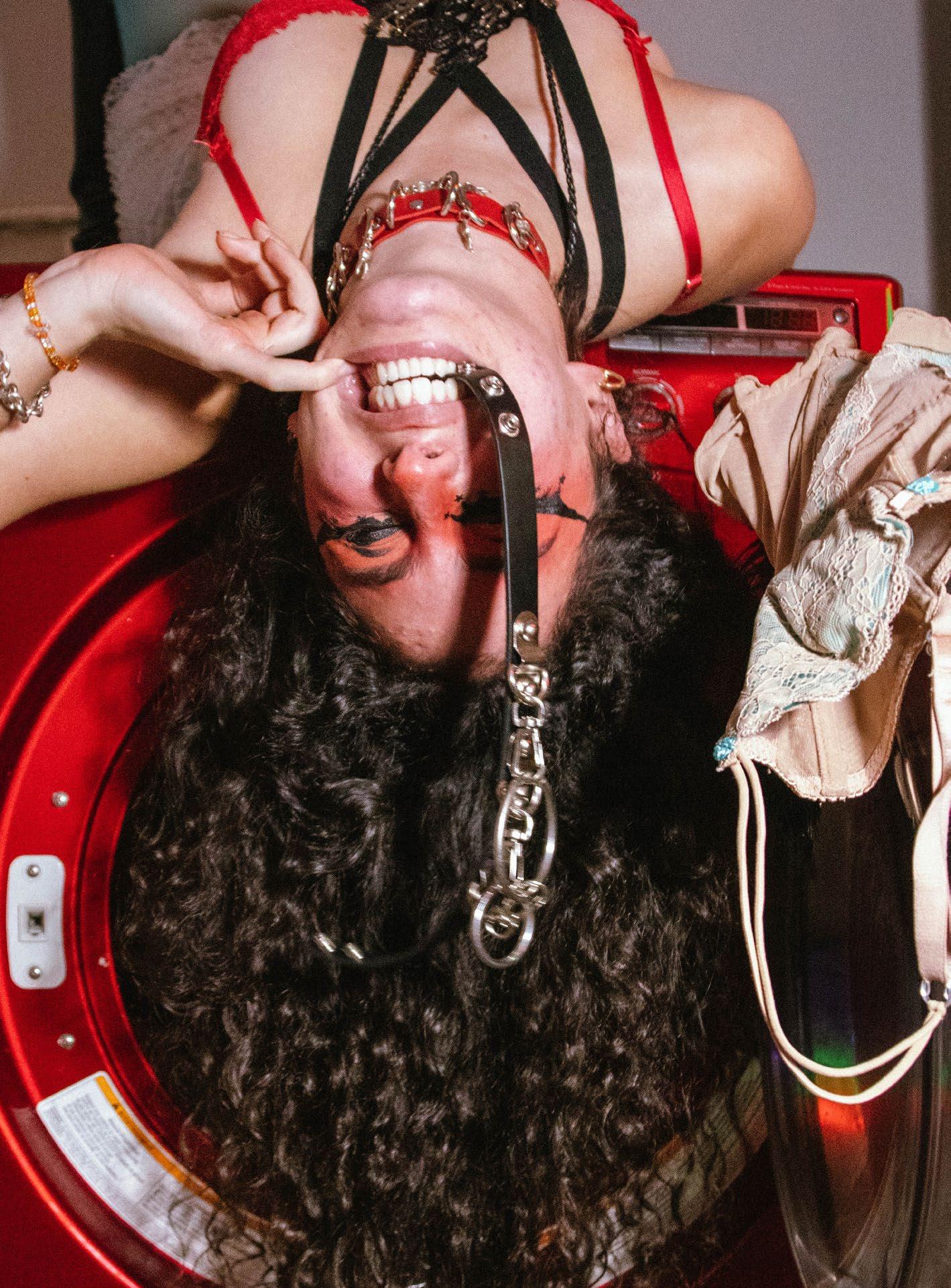
116
The bouncer waves you in and it’s a feast for the senses. The darkness of the club is illuminated by the bursts of strobe lights. Strangers glance playfully at each other before drawing together. Individual identity becomes lost as you move deeper into the dance pits; forgetting where your body ends and others begin. A warm, smoky haze envelops the club as you journey toward the bar.
The nightclub is both a place for the self and a venue for community; a place where everyone is vulnerable and free at the same time. Going to a club is inherently escapist; it’s a place that often feels separate from the outside world. Your job doesn’t exist there; there’s no pressure to catch up on schoolwork, the day-to-day stresses of your regular life are left at the door. The experience of losing oneself to the collective can give way to new discoveries and personal transformations. The liberating nature of the club allows self expression to thrive, especially when it comes to fashion.
Nightclubs have long been the birthplace of fashion inspiration, and quickly became locations for members of fashion subcultures to gather. From the glamorous disco exuberance of Studio 54 in the 1970s, to the outrageous flamboyance of NYC’s Club Kids in ‘80s and ‘90s, to the refined edginess of 1990s and 2000s European clubs like the notorious Berghain, fashion bursts at the
seams when expressed under cover of darkness. Though the styles of counterculture fashion can vary substantially between the decades, the purpose of subculture remains the same: people crave a place where they can be that person that lurks deep within them — or even become someone else entirely — and often this is accessed through making deliberate fashion choices.
In the 1970s, New York’s most nameworthy and star-studded discotheque, Studio 54, reigned supreme. Even today, Generation Z reads about the club and wishes that there was a way to recreate the wild reputation that followed it. Characterized by loose rules, unrestrained sexual activity, and flagrant drug use, Studio 54 drew some of the most famous personalities of New York City into its enigmatic walls. High fashion designers like Halston and Diane von Furstenburg often frequented the club, attracted to its untamed party culture. The likes of Cher and Mick Jagger could often be seen dancing the night away as well. Despite its glossy clientele, Studio 54 was not conceived as a show of luxury and wealth.Though it was exclusive, throwing around exorbitant amounts of money was not the point of the club; the founders described it as a place for freedom. Fun was the priority. And because of the looseness of rules at Studio 54, people felt safe in expressing themselves, triggering several culturally significant fashion moments that remain wellremembered today.
writing LILY ELWOOD
modeling SASHA LEWIS & ANTHONY PETERS photography SHIRLEY WANG design SHARON CHEN makeup CELINE PLAISIR styling ADRIANA ALVAREZ
THE NIGHTCLUB IS BOTH A PLACE FOR THE SELF AND A VENUE FOR THE COMMUNITY.
The style sensation Studio 54 witnessed Bianca Jagger arrive in Halston garments atop a horse; it saw Grace Jones’ outside-of-the-box crochet dress. Dolly Parton wore a mesmerizing, glittery floor length black cape. Olivia Newton John entered the club in bright satin for the premier party of Grease. Diana Ross showed up in Levi’s jeans. The ‘70s fashion scene blossomed at Studio 54, and more experimental fashion choices set the tone for future trends. Queer figures like Halston were also able to express themselves in their clothing without fear of backlash. Studio 54 was among few places where queer people in the ‘70s could feel accepted, cementing club culture as a necessary safe space for the community. The freedom of disco culture is still alive and breathing, with ‘70s trends circulating through social media constantly as a new generation of teenagers seeks to find methods of self expression. Studio 54 remained a central driving force of fashion through to the end of the ‘70s and into the ‘80s.
A new subculture emerged in the ‘80s and ‘90s in New York City, as the LGBTQ+ community began to take over clubs and build the foundations of ballroom — the Club Kids. Originating from a single group of queer people, Club Kid fashion became widespread through an entire community of queer partygoers. The fashion was dramatic, rebellious, and ridiculous. It was invented to turn heads, to be offensive to the elite. The aesthetic was raunchy and gender fluid, an expression of sexuality removed from the confines of the gender binary. The original Club Kids threw salacious, shocking parties at clubs where attendees wore dramatic costumes and makeup. Drugs were the norm at these parties, and experimentation was the gas that kept the fire burning.
The Club Kids set fashion trends as some of the original influencers before the age of Instagram. Their exaggerated, attention-grabbing style choices controlled influence on the fashion industry and helped to push queer people further into the mainstream. At the same time as the Club Kids were partying in established nightclubs, Black and Latinx queer people took over the underground club scene with the inception of ballroom culture. In a push against racism often experienced at drag pageants, they created a subculture full of voguing, house music, hip-hop, and, of course, extravagant outfits.
Often facing discrimination when attempting to enter mainstream club spaces — even queer dominated spaces — queer people of color were able to live that life of freedom mainstream clubs couldn’t offer through the ballroom scene. Houses were formed where young queer kids could be “adopted” into an unconventional family, and ballroom events carved out an exclusive cocoon for the Black and Latinx communities to come together. Ballroom fashion was also over the top and in your face, just like Club Kid fashion. In different ways, and through different subcultures, queer people were sending a defiant message through club culture and loud fashion that they existed, and they were not going anywhere. At a time of increased marginalization, sexual violence, and prejudice due to the AIDS epidemic, these communities were critical to queer joy and survival as a safe haven for pride, community, and acceptance.
118
clubkidculture



THE FASHION WAS DRAMATIC, REBELLIOUS, AND RIDICULOUS. IT WAS INVENTED TO TURN HEADS, TO BE OFFENSIVE TO THE ELITE.









FASHION BOUNDARIES.



120
Some clubs have risen to fame because of their exclusive nature — no one really knows what goes on inside their walls. The fashion trends of these clubs have evolved to reflect these sentiments. While clubs in New York City have often been known for their loud acceptance, with exclusive clubs in the modern era often being looked down on, clubs like Berghain in Berlin have claimed their spotlight by turning people away at the door.
Founded in the mid 2000s, Berghain is located in a formerly abandoned concrete building; the almost threatening brutalist architecture is the first thing you notice about it. It is extremely difficult to make it into the club; people plan their often all-black outfits all day in the hopes of being rewarded with entry, only to be turned away. Upon entering the techno capital of the world, phone cameras are covered, promoting the idea that clubs are places for unobserved freedom. BDSM-inspired fashion and fetishwear are frequent staples in Berghain fashion due to its reputation for the more extreme and experimental flavors of sexuality. Housing a downstairs basement where a male-only sex club exists, Berghain has long been a venue that celebrates queerness and the pleasures of hedonism. Rapture and liberation are the priorities, and the restrictive nature of the club seeks to
preserve this culture — only letting in those who will fit the club’s specific atmosphere and energy. Most people dress in all black — almost communicating a message that within the walls of Berghain, you are no longer an individual, simply a member of the mass energy that pulsates on the dance floor. Notorious for warping time within its bunker, Berghain partygoers often remain inside the clubs for days at a time, making functionality and comfort a must for a multi-night escape.
Historically, nightclubs have been a place where fashion experimentation is not only accepted, but encouraged. Trends that have ascended to the mainstream are often rooted in queer club aesthetics, though these communities are frequently over-shadowed. Today, queer and POC club cultures continue to push fashion boundaries, and club fashion has been notably more excessive and extravagant in the outskirts of the COVID-19 pandemic. With a new generation of young adults craving that feeling of intense liberation post-lockdown, fashion has never had a better opportunity to grow out of the unspoken activities that take place after-hours.
THESE COMMUNITIES WERE CRITICAL TO QUEER JOY AND SURVIVAL AS A SAFE HAVEN FOR PRIDE, COMMUNITY, AND ACCEPTANCE.


122
FEVER



124


126
space between
the space between space between
the the

128

conscious and unconscious
130

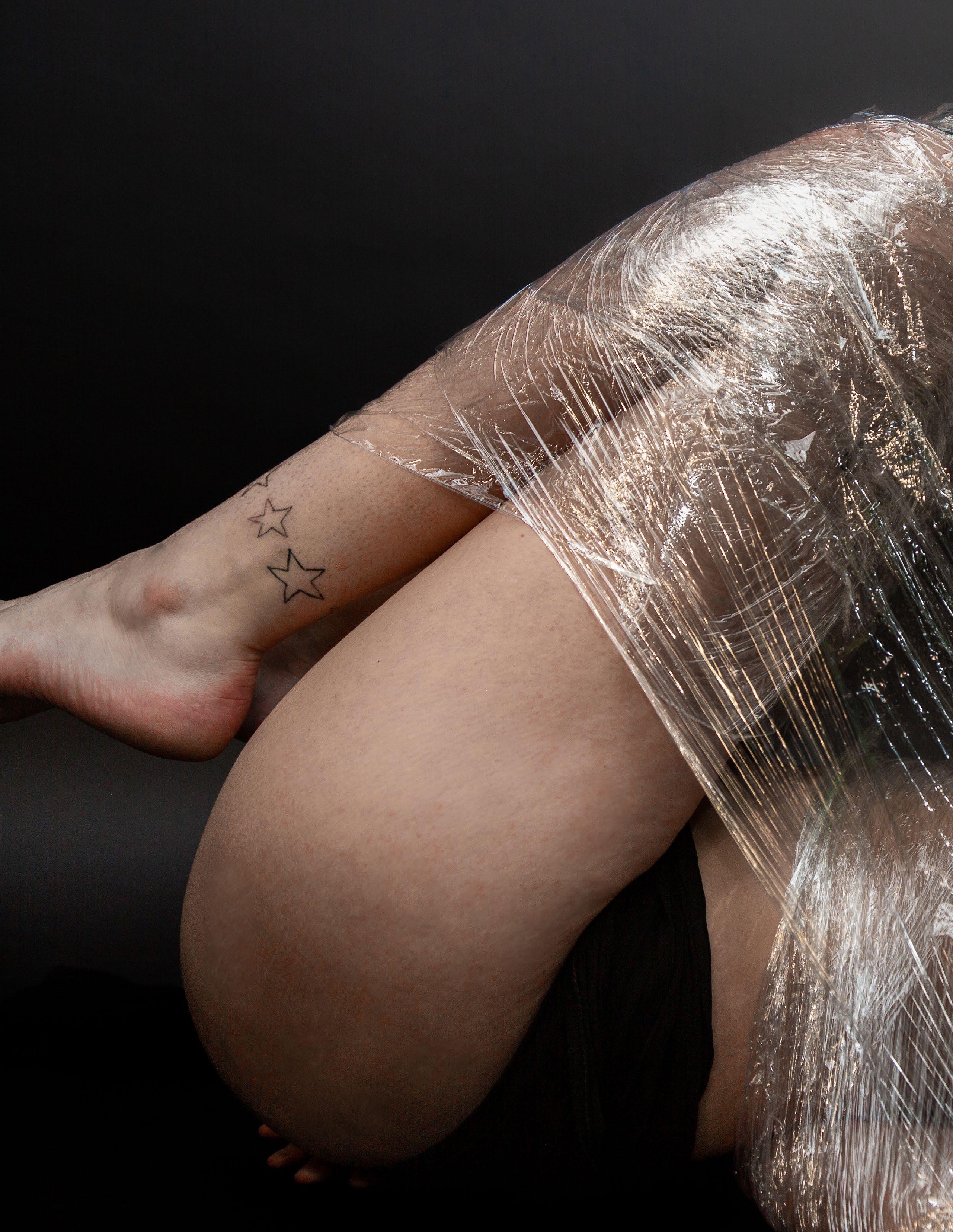
132






















 creativedirection ABBY FALZONE artdirection RENEE PEARCE photography MIA RAPELLA design CLAIRE HIGGINS contributingartdirection JACYN DANIELS modeling SCHEKINATH (KIKI) BIAOU & CHLOE COWAN styling YEANI KWON & GIGI GILLEN & ADRIANA ALVAREZ makeup&hair MELANIE BAREST & GIGI GILLEN & JACYN DANIELS & ELANA LANE
creativedirection ABBY FALZONE artdirection RENEE PEARCE photography MIA RAPELLA design CLAIRE HIGGINS contributingartdirection JACYN DANIELS modeling SCHEKINATH (KIKI) BIAOU & CHLOE COWAN styling YEANI KWON & GIGI GILLEN & ADRIANA ALVAREZ makeup&hair MELANIE BAREST & GIGI GILLEN & JACYN DANIELS & ELANA LANE
















































 writing NYREE CHRISTIANIAN
modeling SRISHTI GUMMARAJU photography KIRA BRIGGS design EMLYN GRIFFITHS styling YEANI KWON makeup MELANIE BAREST
writing NYREE CHRISTIANIAN
modeling SRISHTI GUMMARAJU photography KIRA BRIGGS design EMLYN GRIFFITHS styling YEANI KWON makeup MELANIE BAREST














 writing GRAY TIMBERLAKE modeling YENE USUA photography SERENA BUSCARELLO design SOPHIE FIKS makeup SOFIA URRUTIA styling WOODY LINDOR
writing GRAY TIMBERLAKE modeling YENE USUA photography SERENA BUSCARELLO design SOPHIE FIKS makeup SOFIA URRUTIA styling WOODY LINDOR







 writing ISABELLA BERNSTEIN modeling BITA ADEL-ZADEH & SOFIA FRANCHESCHINI & MARISSA MUNOZ photography OLIVIA LEON design SYDNEY SINGH styling ADRIANA ALVAREZ makeup CLARISA ZALLES
writing ISABELLA BERNSTEIN modeling BITA ADEL-ZADEH & SOFIA FRANCHESCHINI & MARISSA MUNOZ photography OLIVIA LEON design SYDNEY SINGH styling ADRIANA ALVAREZ makeup CLARISA ZALLES





















































 writing ANONYMOUS modeling ELANA LANE & AX BALIONE photography ALEX CHANG design EMLYN GRIFFITHS styling ADRIANA ALVAREZ
makeup MELANIE BAREST
writing ANONYMOUS modeling ELANA LANE & AX BALIONE photography ALEX CHANG design EMLYN GRIFFITHS styling ADRIANA ALVAREZ
makeup MELANIE BAREST








 writing VALERIA MARTINEZ modeling RACHEL SOLOMON photography AZRA SCHORR design DAISY TULLER styling YEANI KWON makeup MELANIE BAREST
writing VALERIA MARTINEZ modeling RACHEL SOLOMON photography AZRA SCHORR design DAISY TULLER styling YEANI KWON makeup MELANIE BAREST











 vwriting ALEX TROTTO modeling HANNAH HARTSOUGH & AIDAN SEVIER & SASHA SHRESTHA photography PEYTON POLLARD design SHARON CHEN makeup SOFIA URRUTIA styling WOODY LINDOR
vwriting ALEX TROTTO modeling HANNAH HARTSOUGH & AIDAN SEVIER & SASHA SHRESTHA photography PEYTON POLLARD design SHARON CHEN makeup SOFIA URRUTIA styling WOODY LINDOR








 writing LOGAN ROBERTS modeling LUNA BRUSS & AMELIA BALL photography ISABELLA POZZI design SOPHIE FIKS makeup SOFIA URRUTIA styling SOLOMON CANADA
writing LOGAN ROBERTS modeling LUNA BRUSS & AMELIA BALL photography ISABELLA POZZI design SOPHIE FIKS makeup SOFIA URRUTIA styling SOLOMON CANADA

























